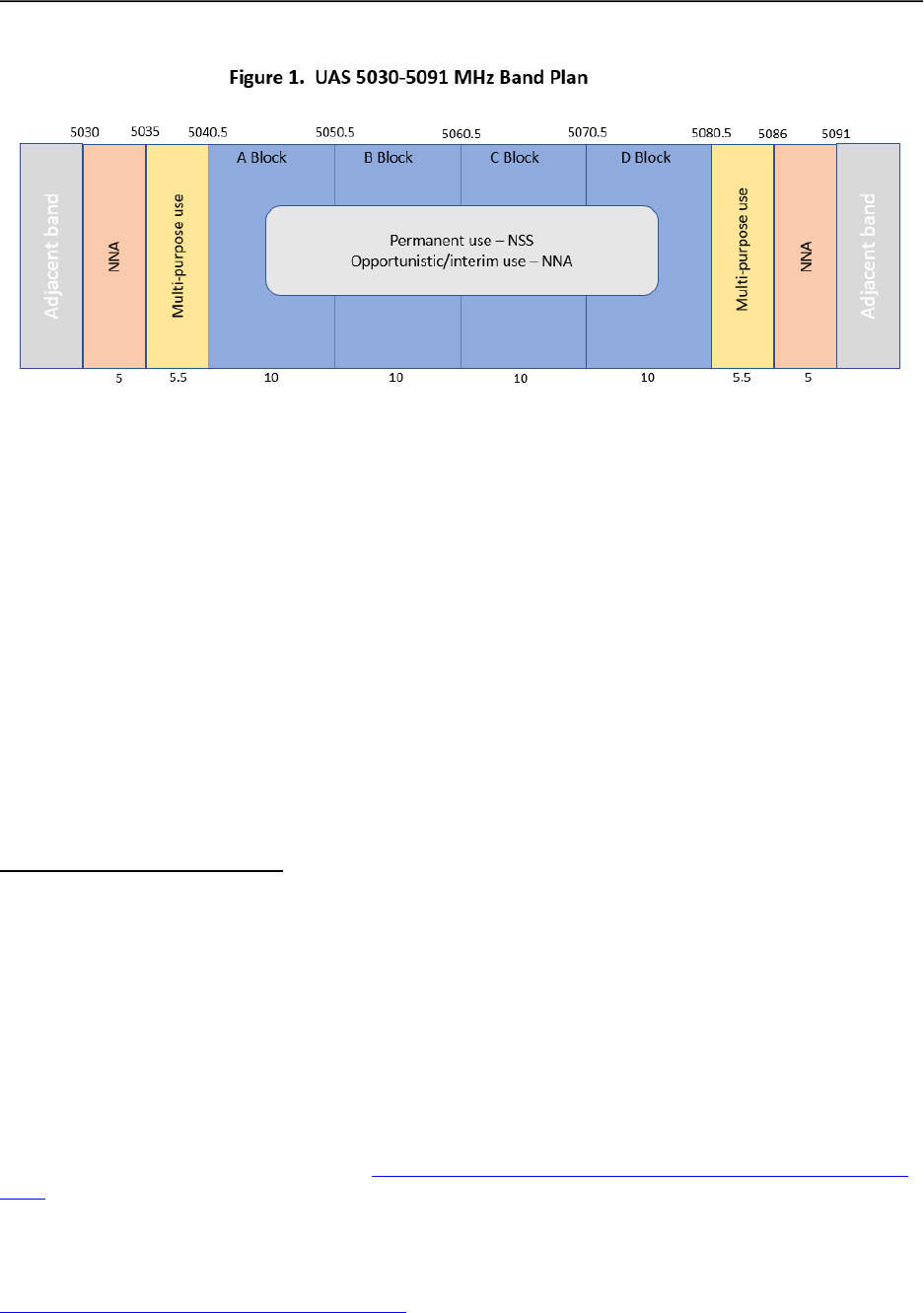
Federal Communications Commission FCC 22-101
Before the
Federal Communications Commission
Washington, D.C. 20554
In the Matter of
Spectrum Rules and Policies for the Operation of
Unmanned Aircraft Systems
Petition of AIA for Rulemaking to Adopt Service
Rules for Unmanned Aircraft Systems Command
and Control in the 5030-5091 MHz Band
)
)
)
)
)
)
)
)
WT Docket No. 22-323
RM-11798 (terminated)
NOTICE OF PROPOSED RULEMAKING
Adopted: December 23, 2022 Released: January 4, 2023
Comment Date: (30 days after date of publication in the Federal Register)
Reply Comment Date: (60 days after date of publication in the Federal Register)
By the Commission: Commissioner Starks issuing a statement.
TABLE OF CONTENTS
Heading Paragraph #
I. INTRODUCTION...................................................................................................................................1
II. UAS COMMUNICATIONS IN THE 5030-5091 MHZ BAND ............................................................4
A. Background .......................................................................................................................................4
B. Discussion .......................................................................................................................................11
1. Band Plan .................................................................................................................................13
2. Dynamic Frequency Management System...............................................................................26
3. Multi-stakeholder Group ..........................................................................................................45
4. Scope of Permissible Services..................................................................................................47
5. Eligibility Restrictions..............................................................................................................53
6. Non-Networked Access (NNA) Service Rules ........................................................................58
7. Network Supported Service (NSS) Service Rules....................................................................75
8. Equipment Authorization .........................................................................................................99
9. Protection of Other Services...................................................................................................100
a. Microwave Landing Systems...........................................................................................100
b. Out-of-band Services .......................................................................................................104
c. Canadian and Mexican Coordination...............................................................................110
III. AIRBORNE USE OF FLEXIBLE-USE SPECTRUM .......................................................................111
A. Background ...................................................................................................................................114
B. Applicable Spectrum Bands..........................................................................................................120
C. Sufficiency of Existing Rules .......................................................................................................122
D. UAS Impact on Spectrum Rights..................................................................................................146
IV. LICENSING UAS OPERATORS FOR VHF COMMUNICATIONS...............................................151
V. PROCEDURAL MATTERS...............................................................................................................164
VI. ORDERING CLAUSES......................................................................................................................170
APPENDIX A – Proposed Rules

Federal Communications Commission FCC 22-101
2
APPENDIX B – Initial Regulatory Flexibility Analysis
APPENDIX C – List of Commenters
I. INTRODUCTION
1. Unmanned aircraft are being used to deliver consumer packages and life-saving medical
supplies, facilitate the rapid restoration of power infrastructure after a storm, and aid in first responder
missions such as search and rescue and wildfire management, among innumerable other beneficial public
and private uses. These operations depend on wireless communications for purposes ranging from flight
control communications between a ground-based control station and the unmanned aircraft (UA)
(hereinafter referenced collectively in this Notice of Proposed Rulemaking (NPRM) as an unmanned
aircraft system or UAS) to the delivery of mission-related payload information from the UA.
1
In this
NPRM, we take several steps to promote access by UA operators to licensed spectrum for these purposes.
2. First, we address the 5030-5091 MHz band, which the Commission previously allocated
to support terrestrial control links for UAS without adopting service rules. Because technical work
regarding UAS is still in a nascent stage, we anticipate that service rules sufficient to facilitate UAS
operations will likely require development in phases. We now take the first step to develop such rules.
We seek comment on service rules for the 5030-5091 MHz band that will provide UAS operators with
access to licensed spectrum with the reliability necessary to support safety-critical UAS communications
links. Second, due to the increasing interest in operating UAS using existing terrestrial flexible-use
spectrum networks, we seek comment on whether the Commission’s rules are adequate to ensure co-
existence of terrestrial mobile operations and UAS use or whether changes to our rules are necessary.
2
Third, to further promote the safe integration of unmanned aircraft operations in controlled airspace and
facilitate flight coordination, we propose a process for UAS operators to obtain a license in the
aeronautical VHF band to communicate with air traffic control and other aircraft. Together, these
measures will help to promote the growth and safety of UAS operations.
3
3. This proceeding implicates the jurisdiction and concerns of multiple federal agencies.
The Federal Aviation Administration (FAA) has the jurisdictional responsibility to ensure the safety of
aircraft, including UAS, and is tasked by statute with the safe integration of UAS into the National
Airspace System.
4
The National Telecommunications and Information Administration (NTIA), which
administers the federal use of spectrum, has jurisdictional interests in the 5030-5091 MHz band, including
1
More specifically, we use the term unmanned aircraft system(s) (UAS) in this NPRM to reference a UA together
with all the associated elements (including communication links and the components that control the UA) that are
required for the safe and efficient operation of the UA in the airspace of the United States. As discussed below, we
seek comment on our proposal to adopt this definition of “unmanned aircraft system” for the 5030-5091 MHz band
service rules.
2
To this end, we seek comment on the sufficiency of the current flexible-use rules to prevent interference to and
from UAS operations, and on whether we can eliminate the current prohibitions on airborne operations applicable to
certain of these flexible-use bands.
3
We note that AURA Network Systems OpCo, LLC and A2G Communications, LLC, have a pending petition for
rulemaking requesting rule changes to allow the 450 MHz General Aviation Air-Ground Radiotelephone Service
band to be used for a broader range of services, including data communications with UAS. See Petition for
Rulemaking by AURA Network Systems OpCo, LLC and A2G Communications, LLC to Permit the Transmission
of Data in Air-Ground Radio Telephone Automated Service Channels Between 454.675-454.975 MHz and 459.675-
459.975 MHz, RM-11912 (filed Feb. 16, 2021) (AURA/A2G Petition). We expect to address the AURA/A2G
Petition in another proceeding.
4
See 49 U.S.C. § 44802. The National Airspace System consists of (1) a network of both controlled and
uncontrolled airspace, (2) air navigation facilities, equipment and services, (3) airports and landing areas, (4)
aeronautical charts, information and services, (5) rules and regulations, (6) procedures and technical information,
and (7) manpower and material. See FAA, National Airspace System, https://www.faa.gov/air_traffic/nas/ (last
visited Sept. 6, 2022).

Federal Communications Commission FCC 22-101
3
potentially using the band for federal UAS operations and ensuring the adequate protection of certain
other federal uses in and adjacent to the 5030-5091 MHz band. As a part of their respective jurisdictional
responsibilities, both the FAA and NTIA have been examining the potential use of the 5030-5091 MHz
band for UAS operations, and the FAA has adopted a minimum performance standard for UAS radio
equipment operating in the 5040-5050 MHz sub-band of the 5030-5091 MHz band.
5
Accordingly, a
whole-of-government approach is needed to ensure that this proceeding addresses the relevant concerns
and issues within the responsibility of each stakeholder agency and that our efforts in this area work in
complement with those of our federal partners to support and promote the safe and productive operation
of UAS. To facilitate this approach, we have consulted with these agencies in the preparation of this
NPRM, and will continue to do so as the proceeding advances.
II. UAS COMMUNICATIONS IN THE 5030-5091 MHZ BAND
A. Background
4. Because a UA, to the extent its route is not pre-programmed, must be operated remotely,
the operator depends critically on wireless communications between a ground-based control station and
the UA to control the flight of the UA, including communications to send commands to the aircraft and to
receive telemetry and other data from it. UAS also increasingly employ wireless signals for other safety-
related purposes, such as to detect and avoid other aircraft. Currently, no spectrum is licensed in the
United States exclusively for UAS communications, and operators have generally relied on unlicensed
operations or experimental licenses. Neither of these spectrum resources provide the user with any right
to protection from harmful interference, and as a result, the reliability of communications using these
resources can be uncertain. As UA flights increasingly involve operations with a higher risk profile, such
as flights that use large aircraft, carry heavy cargo or human passengers, or travel into the controlled
airspace used by commercial passenger aircraft,
6
operators have a growing need for the greater reliability
that interference-protected licensed spectrum provides for control-related and other safety-related
communications.
5. In 2017, the Commission determined that the 5030-5091 MHz band should be allocated
to help address that need.
7
Prior to the 2012 World Radiocommunication Conference (WRC-12), the
5
The FAA’s actions to integrate UAS into the National Airspace System have also involved many regulatory efforts
not specific to the 5030-5091 MHz band. For example, in 2016, the FAA, together with the Office of the Secretary
of Transportation, adopted rules authorizing the routine operation of small UAs (those weighing less than 55
pounds), subject to certain restrictions and limitations. See Federal Aviation Administration and Office of the
Secretary of Transportation, Department of Transportation, Operation and Certification of Small Unmanned Aircraft
Systems, 81 Fed. Reg. 42064 (June 28, 2016) (to be codified at 14 CFR pts. 21, 43, 61, 91, 101, 107, 119, 133, 183).
Among other restrictions, the rules did not permit such operations over people or at night without an individual
waiver. See id. at 42102, 42123. Subsequently, the FAA modified these regulations and authorized routine
operations of small UAs over people and operation at night under certain circumstances. See Federal Aviation
Administration and Office of the Secretary of Transportation, Department of Transportation, Operation of Small
Unmanned Aircraft Systems Over People, 86 Fed. Reg. 4314, 4314-15 (Jan. 15, 2021). At the same time, the FAA
also adopted rules establishing requirements for the remote identification of UAs operating in the United States. See
Federal Aviation Administration, Remote Identification of Unmanned Aircraft, 86 Fed. Reg. 4390 (Jan. 15, 2021)
(Remote ID Rules).
6
The FAA defines “controlled airspace” as “an airspace of defined dimensions within which air traffic control
service is provided to [instrument flight rules] flights and to [visual flight rule] flights in accordance with the
airspace classification. NOTE: Controlled airspace is a generic term that covers Class A, Class B, Class C, Class D,
and Class E airspace.” 14 CFR § 1.1 (General Definitions). Controlled airspace is found around some airports and
at certain altitudes where air traffic controllers are actively communicating with, directing, and separating all air
traffic. See FAA, Airspace 101: Rules of the Sky,
https://www.faa.gov/uas/recreational_fliers/where_can_i_fly/airspace_101/ (last visited Sept. 6, 2022).
7
See Amendment of Parts 2, 15, 80, 90, 97, and 101 of the Commission’s Rules Regarding Implementation of the
Final Acts of the World Radiocommunication Conference (Geneva, 2012)(WRC-12), Other Allocation Issues, and
(continued….)

Federal Communications Commission FCC 22-101
4
5030-5091 MHz band was allocated both internationally and in the United States to the aeronautical
mobile-satellite (route) service (AMS(R)S) and the aeronautical radionavigation service (ARNS) on a
primary basis.
8
Footnote 5.444 of the Table of Frequency Allocations further provides that the spectrum
is to be used for the operation of the international standard system (microwave landing system) for
precision approach and landing and gives microwave landing systems priority over other uses of the
band.
9
At the 2012 World Radiocommunication Conference, the United States proposed that the 5030-
5091 MHz band also be allocated to the aeronautical mobile (route) service (AM(R)S) on a primary basis
in order to support terrestrial control links for UAS, in light of (1) the anticipated growth of UAS
operations, (2) the limited use of the band worldwide at that time, and (3) the lack of microwave landing
system deployment in the United States at 5030-5091 MHz.
10
Consistent with the United States proposal,
the 2012 World Radiocommunication Conference allocated the 5030-5091 MHz band internationally to
the AM(R)S on a primary basis in all Regions.
11
6. In 2017, the Commission adopted a Report and Order taking several steps in response to
the decisions from the 2012 World Radio Conference.
12
Among other measures, the Commission
mirrored the international allocation at 5030-5091 MHz in its domestic allocations, specifically allocating
the 5030-5091 MHz band to the AM(R)S on a primary basis for both federal and non-federal use.
13
Under the Commission rules, “AM(R)S” is defined as “[a]n aeronautical mobile service reserved for
communications relating to safety and regularity of flight, primarily along national or international civil
air routes.”
14
The Commission found that adopting the new AM(R)S allocation would “support the
anticipated growth of UAS and promote their safe operation.”
15
The Commission did not adopt any rules
Related Rule Updates, ET Docket No. 15-99, Report and Order, 32 FCC Rcd 2703, 2717, para. 42 (2017) (WRC-12
R&O).
8
See Amendment of Parts 1, 2, 15, 25, 27, 74, 78, 80, 87, 90, 97, and 101 of the Commission’s Rules Regarding
Implementation of the Final Acts of the World Radiocommunication Conference (Geneva, 2007) (WRC-07), Other
Allocation Issues, and Related Rule Updates et al., ET Docket No. 12-338, et al., Report and Order, Order, and
Notice of Proposed Rulemaking, 30 FCC Rcd 4183, 4262, paras. 223-24 (2015) (WRC-12 NPRM); 47 CFR § 2.106.
Under the Commission’s Table of Frequency Allocations rules, Aeronautical Mobile-Satellite Route Service
(AMS(R)S) is defined as “[a]n aeronautical mobile-satellite service reserved for communications relating to safety
and regularity of flights, primarily along national or international civil air routes.” 47 CFR § 2.1(c). Aeronautical
Radionavigation Service (ARS) is defined as “[a] radio-navigation service intended for the benefit and for the safe
operation of aircraft.” Id.
9
See 47 CFR § 2.106, footnote 5.444.
10
See WRC-12 NPRM, 30 FCC Rcd at 4262, para. 225.
11
See WRC-12 NPRM, 30 FCC Rcd at 4263, para. 226.
12
See generally WRC-12 R&O.
13
See WRC-12 R&O, 32 FCC Rcd at 2717, para. 41. The status of “primary” gives AM(R)S priority over any
services allocated on a “secondary” basis, see 47 CFR § 2.105(c)(2), but AM(R)S remains subject to the higher
priority of MLS provided by Footnote 5.444. See 47 CFR § 2.106, footnote 5.444. The Commission also added
Footnote 5.443C to this allocation band limiting its use to internationally standardized aeronautical systems and
setting limits for unwanted emissions from AM(R)S stations to adjacent band radionavigation-satellite service
(RNSS) downlinks to an EIRP density of -75 dBW/MHz. See WRC-12 R&O, 32 FCC Rcd at 2717, para. 41; see
also 47 CFR § 2.106, footnote 5.443C.
14
47 CFR § 2.1(c). The Commission defines the term “aeronautical mobile service,” in relevant part, as “[a] mobile
service between aeronautical stations and aircraft stations, or between aircraft stations[.]” Id. An aeronautical
station is defined as “[a] land station in the aeronautical mobile service.” Id. An aircraft station is defined as “[a]
mobile station in the aeronautical mobile service, other than a survival craft station, located on board an aircraft.”
Id.
15
See WRC-12 R&O, 32 FCC Rcd at 2717, para. 42; see also id. at 2704, para. 1 (stating that “AM(R)S use of the
5030-5091 MHz band will support unmanned aircraft systems”).

Federal Communications Commission FCC 22-101
5
to license or govern UAS services in the band, however; instead, it stated that “[t]echnical and operational
rules relating to altitude, weight, or other requirements will be addressed in the service rules for this band,
which will be promulgated in a separate proceeding.”
16
7. AIA Petition for Rulemaking. On February 8, 2018, the Aerospace Industries Association
(AIA) filed a petition for rulemaking recommending licensing and service rules for control-and-non-
payload communications (CNPC) links in the 5030-5091 MHz band to support UAS operations in the
United States (AIA Petition).
17
AIA proposed that individual UAS operators that meet certain
qualifications or organizations that employed such operators be able to obtain a non-exclusive, nationwide
Commission spectrum license, which would authorize them to use the 5030-5091 MHz band for UAS
CNPC subject to a dynamic frequency assignment process.
18
AIA further recommended the Minimum
Operational Performance Standards (MOPS) for UAS CNPC links issued by RTCA in 2016 and
designated as RTCA DO-362 as a “good starting point for the Commission’s consideration of licensing
and operational rules[.]”
19
Noting that the AM(R)S allocation of the band is limited to “communications
16
See WRC-12 R&O, 32 FCC Rcd at 2717, para. 42.
17
See Petition of AIA for Rulemaking to Adopt Service Rules for Unmanned Aircraft Systems (“UAS”) Command
and Control in the 5030-5091 MHz Band, RM-11798 (filed Feb. 8, 2018) (AIA Petition).
18
See AIA Petition at 6-7, 9-10. In its petition, AIA used the terms “control-and-non-payload” and “command-and-
control” (or C2) interchangeably. See, e.g., AIA Petition at 7 (referring to “CNPC links”), 8 (referring to “C2
communications links”). We similarly do so throughout this NPRM.
19
See AIA Petition at 7. RTCA is a standards development organization that works with the FAA to develop
standards that can be used as means of compliance with FAA regulations. See RTCA, About Us,
https://www.rtca.org/about/ (last visited Sept. 6, 2022). RTCA Special Committees (SCs) develop Minimum
Operational Performance Standards (MOPS) among other standards documents related to aviation. See RTCA,
Standards & Guidance Materials Descriptions, https://www.rtca.org/standards/standards-guidance-materials/ (last
visited Sept. 6, 2022). According to RTCA’s website, “MOPS provide standards for specific equipment(s) useful to
designers, manufacturers, installers and users of the equipment. . . . MOPS provide the information needed to
understand the rationale for equipment characteristics and requirements stated, describe typical equipment
applications and operational goals, and establish the basis for required performance under the standard. Definitions
and assumptions essential to proper understanding are provided as well as installed equipment tests and operational
performance characteristics for equipment installations.” Id. RTCA MOPS are often referenced as a basis for
equipment certification in FAA technical standard orders. See id. Technical standard orders establish minimum
performance standards for specified materials, parts, and appliances used on civil aircraft. See FAA, Technical
Standard Orders (TSO), https://www.faa.gov/aircraft/air_cert/design_approvals/tso/ (last visited Sept. 6, 2022).
RTCA’s Special Committee 228 (SC-228), established on May 20, 2013, is working to develop, among other things,
Command-and-Control Data Link MOPS for the 5030-5091 MHz band. See RTCA, SC-228, Minimum
Performance Standards for Unmanned Aircraft Systems, https://www.rtca.org/content/sc-228 (last visited Sept. 6,
2022). The committee published the first version in September 2016 with the release of DO-362, Command and
Control (C2) Data Link Minimum Operational Performance Standards (MOPS) (Terrestrial) (RTCA DO-362). In
response, the FAA adopted Technical Standard Order C213, Unmanned Aircraft Systems Control and Non-Payload
Communications Terrestrial Link System Radios, effective March 9, 2018. See Federal Aviation Administration,
Aircraft Certification Service, Technical Standard Order C213, Unmanned Aircraft Systems Control and Non-
Payload Communications Terrestrial Link System Radios (2018) (TSO-C213). TSO-C213 adopted the RTCA DO-
362 standard as a minimum performance standard for new models of UAS CNPC Link System radios operating in
the 5040-5050 MHz portion of the 5030-5091 MHz band. See TSO-C213 at 1. On December 20, 2022, the FAA
issued a revision of TSO-C213, designated TSO-C213a. See Federal Aviation Administration, Aircraft Certification
Service, Technical Standard Order C213a, Unmanned Aircraft Systems Control and Non-Payload Communications
Terrestrial Link System (2022) (TSO-C213a), available at FAA, Technical Standard Orders,
https://drs.faa.gov/browse/TSO/doctypeDetails. TSO-C213a replaces TSO-C213 going forward, adopting aspects of
RTCA DO-362A, the second version of the RTCA MOPS for the 5030-5091 MHz band, as minimum performance
standards for CNPC Link Systems designed for operations within any spectrum in the 5030-5091 MHz band. See
TSO-C213a at 2; RTCA, Command and Control (C2) Data Link Minimum Operational Performance Standards
(MOPS) (Terrestrial), RTCA-DO-362A (2020) (RTCA DO-362A).

Federal Communications Commission FCC 22-101
6
relating to safety and regularity of flight,” AIA also advocated for prohibiting any non-UAS use of the
5030-5091 MHz band or any UAS use for “payload communications or other non-safety or non-route
services.”
20
8. The Commission sought public comment on AIA’s petition on April 26, 2018.
21
Eight
parties filed comments, and four filed replies.
22
The majority of commenters supported commencement
of a rulemaking to license the 5030-5091 MHz band for UAS communications, and several supported
aspects of the AIA proposal.
23
Some raised concerns, however, that the proposal was too restrictive in the
operations it would support or permit and that the 5030-5091 MHz band would not in any case be able to
support all UAS operations; those commenters recommended that the Commission not preclude use of
other bands for UAS operations.
24
9. Section 374 Report. Section 374 of the FAA Reauthorization Act of 2018 directs the
FAA, the FCC, and NTIA to submit a report to specified committees of the House and Senate on, among
other things, “whether [UAS] operations should be permitted, but not required, to operate on [the 5030-
5091 MHz band] on an unlicensed, shared, or exclusive basis, for operations within the [UAS Traffic
Management] system or outside of such a system.”
25
On November 25, 2019, the Office of Engineering
and Technology (OET) and the Wireless Telecommunications Bureau (WTB) (collectively, the Bureaus)
sought public comment on this issue and others identified in Section 374 of the FAA Reauthorization Act
(Section 374 Public Notice).
26
Twenty-three parties filed comments, and eleven filed replies.
27
On
August 20, 2020, the Bureaus jointly submitted a report to Congress on behalf of the Commission
addressing the matters specified in Section 374.
28
In their report, the Bureaus found that “[t]he 5030-5091
MHz band appears to offer promise for intensive UAS use because it is unencumbered”
29
and
“recommend[ed] that the Commission initiate a rulemaking proceeding to develop service and licensing
rules enabling UAS use of the 5030-5091 MHz band in collaboration with the FAA and NTIA.”
30
10. Refresh Public Notice. On August 20, 2021, WTB released a public notice to update the
record on AIA’s proposal to reflect developments since 2018 and to further develop the record on certain
20
AIA Petition at 10.
21
See Consumer & Governmental Affairs Bureau Reference Information Center Petition for Rulemakings Filed,
Public Notice, Report No. 3089 (CGB Apr. 26, 2018), https://docs.fcc.gov/public/attachments/DOC-350441A1.pdf.
22
Parties that filed comments and reply comments in response to the AIA Petition are listed in Appendix C.
23
See Elefante Group AIA Petition Comments at 1-2 (supporting petition framework as a “starting point”); Integrity
Communications AIA Petition Comments at 1 (same); Raytheon AIA Petition Comments at 1-2 (same); see also
Boeing AIA Petition Comments at I; Lockheed Martin AIA Petition Comments at 1; RTCA SC-228 AIA Petition
Comments at 1; AeroVironment AIA Petition Reply at 1; Rockwell Collins AIA Petition Reply at 1.
24
See CTIA AIA Petition Comments at 7-9; see also AURA AIA Petition Comments at 2; Small UAV Coalition AIA
Petition Comments at 3.
25
See FAA Reauthorization Act of 2018, § 374, Pub. L. No. 115-254, 132 Stat. 3186, 3313-14 (2018) (Section 374).
26
See Wireless Telecommunications Bureau and Office of Engineering and Technology Seek Comment on
Unmanned Aerial System Operations in the 960-1164 MHz and 5030-5091 MHz Bands, Pursuant to Section 374 of
the FAA Reauthorization Act of 2018, GN Docket No. 19-356, Public Notice, 34 FCC Rcd 11038 (WTB/OET 2019)
(Section 374 Public Notice).
27
Parties that filed comments and reply comments in the Section 374 proceeding are listed in Appendix C.
28
See WTB & OET, Report on Section 374 of the FAA Reauthorization Act of 2018, GN Docket No. 19-356, 1
(2020), https://docs.fcc.gov/public/attachments/DOC-366460A1.pdf (Section 374 Report). The Section 374 Report
stated that separate reports to Congress were anticipated from the NTIA and FAA regarding matters under their
respective areas of authority. Section 374 Report at 2.
29
Section 374 Report at 12.
30
Id. at 1.

Federal Communications Commission FCC 22-101
7
aspects of the proposal.
31
The Bureau received 24 comments and four reply comments in response to the
Refresh Public Notice.
32
B. Discussion
11. As reflected in the comments to the AIA Petition and the record in response to the
Refresh Public Notice, UAS manufacturers and other stakeholders have continued to express strong
interest in a proceeding to enable licensing of the 5030-5091 MHz band for UAS CNPC links since the
Commission added an AM(R)S allocation in the 5030-5091 MHz band to enable interference-protected
UAS communications.
33
The Section 374 Report released by WTB and OET in 2020 also supports the
commencement of a rulemaking proceeding to adopt service rules enabling UAS operations in the 5030-
5091 MHz band.
34
Accordingly, we propose to adopt a band plan and service rules in the 5030-5091
MHz band to enable UAS operators to use interference-protected CNPC links. We seek comment on our
proposal and on options to make the band available for this purpose. We further seek comment on the
costs and benefits of any such options, including the costs and benefits of the specific band plan and
service rules options discussed below. UAS platforms offer potential benefits in particular to
disadvantaged, remote and rural communities, including delivery of essential goods or medical and other
critical supplies in hard-to-reach areas, as well as innovative agricultural uses. We seek comment on
measures that will facilitate UAS use and promote equity for these underserved populations. We
encourage stakeholders to develop and submit consensus recommendations on service rules for the 5030-
5091 MHz band, including recommendations on the issues and proposals discussed below.
12. We do not intend to mandate that all UAS CNPC occur exclusively in the 5030-5091
MHz band. Other licensed bands, including the flexible-use bands where mobile networks are already
deployed nationwide and the 450 MHz General Aviation Air-Ground band, are being explored as
platforms for UAS operations, including UAS CNPC. Commenters in this proceeding broadly support
the availability of these bands as resources to help meet the rapidly growing spectrum access needs of the
UAS community.
35
In addressing the 5030-5091 MHz service rules, we do not propose to mandate that
all CNPC occur within the band, nor do we intend that the future rules adopted in this proceeding for
5030-5091 MHz will necessarily govern any UAS operations in other bands. Rather, through this
proceeding, we seek to provide UAS operators with access to an additional spectrum resource that may
complement other spectrum resources that are currently available or in development. The 5030-5091
MHz band is a limited resource, and the demand for protected UAS CNPC may well exceed the capacity
of the band as UAS operations increase over time.
36
Further, while existing networks operating in other
bands such as flexible-use bands may provide sufficient reliability for many UAS use cases, authorization
of the 5030-5091 MHz band for UAS use offers an opportunity to apply standards and rules designed to
31
See Wireless Telecommunications Bureau Seeks to Refresh the Record on Unmanned Aircraft Systems Use of the
5 GHz Band, RM-11798, Public Notice, 36 FCC Rcd 12706 (WTB 2021) (Refresh Public Notice).
32
Parties that filed comments and reply comments in response to the Refresh Public Notice are listed in Appendix C.
33
See, e.g., AIA Refresh PN Comments at 1-3; ASRI Refresh PN Comments at 1, 4; AURA Refresh PN Comments
at 1; AeroVironment Refresh PN Comments at 1; CDA Refresh PN Comments at 1; EEI Refresh PN Comments at 1;
FPL Refresh PN Comments at 4; Qualcomm Refresh PN Comments at 1.
34
Section 374 Report at 1, 12.
35
See infra n.255.
36
See Letter from John W. Kuzin, Vice President, Spectrum Policy & Regulatory Counsel, Qualcomm, to Marlene
Dortch, Secretary, FCC, RM-11798 (filed Mar. 15, 2022) (Qualcomm Mar. 15, 2022 Ex Parte). Qualcomm
performed simulations that purport to show that, as the number of UAS per “cell” increases, both uplink data
throughput and uplink latency increase to levels that may exceed acceptable target values. See id., Attach. at 12-17.
To combat these capacity issues in the 5030-5091 MHz band, Qualcomm suggests that terrestrial mobile networks in
other bands could be utilized for lower altitude operations and offloaded to the 5030-5091 MHz band above a
certain height threshold. See id., Attach. at 22.

Federal Communications Commission FCC 22-101
8
meet even the most safety-critical communications needs.
37
In addition, as we discuss below, technical
standards have already been developed for the 5030-5091 MHz band specifically to support reliable UAS
CNPC, whereas work is still nascent to establish or demonstrate the reliability of CNPC standards or
operations in other bands. As a result, the 5030-5091 MHz band has the potential to be available for
safety-critical aviation needs more quickly than licensed spectrum in these other bands. We tentatively
conclude that, while other spectrum bands are available for UAS communications, licensing the 5030-
5091 MHz band specifically for UAS CNPC will have important public interest benefits. We seek
comment on this tentative conclusion and the extent to which the 5030-5091 MHz band may offer unique
advantages over other bands in supporting UAS CNPC.
1. Band Plan
13. Below, we seek comment on an appropriate band plan for communications to support the
growth and safety of UAS operations. For the purpose of this band and its service rules, and consistent
with the FAA definitions of the terms, we propose to define UAS as an unmanned aircraft (UA) and its
associated elements (including communication links and the components that control the UA) that are
required for the safe and efficient operation of the UA in the airspace of the United States, and to define a
UA as an aircraft operated without the possibility of direct human intervention from within or on the
aircraft.
38
We seek comment on these proposed definitions and on any alternatives. We further identify
two broad UAS use cases for purposes of determining the appropriate band plan and service rules – non-
networked operations, generally occurring within radio-line-of-sight
39
of the UAS operator, and network-
supported operations, which rely on network infrastructure to go beyond radio-line-of-sight of the
operator. Non-networked operations involve flights within a sufficiently localized area that can rely on
direct wireless links between the UAS operator’s controller and the UA and therefore do not require any
supporting network infrastructure. Such operations may include, for example, tower or other site
inspections, public safety operations, or localized surveillance. In contrast, network-supported operations
rely on deployed network infrastructure, such as cell towers and sites, to relay information between the
operator and the UA and may therefore extend far beyond the range of direct wireless links between
operator and UA.
40
While UAS operations have in the past been predominantly non-networked
operations, there is growing interest in and exploration of network-supported operations, such as for
package delivery, mapping, search-and-rescue, long-range infrastructure inspections (e.g., involving
37
See, e.g., ASRI Refresh PN Comments at 1 (asserting that the 5030-5091 MHz band is central to successful UAS
development and advancement, “particularly for larger UAS operating in [FAA]-controlled airspace”).
38
See 14 CFR § 1.1; accord 49 U.S.C. § 44801(11), (12) (defining “unmanned aircraft” and “unmanned aircraft
system”). While our rule proposal thus focuses use of the band on communications for the operation of a type of
aircraft, which meets the definition of a part 87 aviation service, see 47 CFR § 87.5, we note that a network-based
communications service offered to operators of UAS would typically also be a commercial service providing access
to wide-area networks, in contrast to the largely if not entirely non-commercial and non-network-based services
regulated under part 87. See generally 47 CFR pt. 87. Below, we seek comment on the regulatory treatment of
these services, including their placement in the organization of our rules. See, e.g., infra paras. 70-73.
39
References to “line-of-sight” herein correspond to radio-line-of-sight. This is in contrast to FAA rules, which
consider whether UAS operations are within visual-line-of-sight rather than radio-line-of-sight. See 14 CFR §
107.31. We focus on whether a UA is beyond-radio-line-of-sight in this context because the suitability of the
different licensing approaches we consider below (direct link connections as opposed to network-based connections)
appears to depend to a greater extent on whether an operation is within radio-line-of-sight of the operator than on
whether or not an operation is in visual sight of the operator. A UA that is beyond-visual-line-of-sight but within
radio-line-of-sight can still be controlled by a direct wireless link between the controller’s radio and the UA.
40
See, e.g., CTIA Refresh PN Comments at 11 (“To the extent this band is to be used for [beyond-line-of-sight], the
spectrum will either need to be deployed on existing nationwide infrastructure, or brand-new infrastructure that can
accommodate UAS flight over long distances.”). Such operations have also relied on satellite-based connections or,
in some cases, autonomous aircraft that do not require radio control.

Federal Communications Commission FCC 22-101
9
railroad tracks, power distribution infrastructure, or pipelines) and long-range surveillance flights.
41
We
find substantial support in the response to the Refresh Public Notice for both use cases.
42
We seek
comment on whether any other UAS use cases should be considered in determining the appropriate band
plan and service rules.
14. Hereinafter, we use the term Non-Networked Access (NNA) to indicate spectrum or
licenses (e.g., NNA blocks) that would be governed by service rules appropriate to support non-
networked communications.
43
Likewise, we use the term Network-Supported Service (NSS) in
connection with spectrum or licenses to indicate that the relevant spectrum or licenses would be governed
by service rules appropriate to support the provision of network-based services.
44
Further, we propose to
use NNA and NSS in the rules to designate the spectrum allocated for non-networked and network-
supported use cases, respectively.
15. AIA suggests that RTCA’s terminology for these two use cases should be used.
45
RTCA
uses the term “point-to-point” for non-networked communications links and the term “Command-and-
Control Communications Service Providers” to describe network-supported services.
46
We tentatively
find that our proposed terminology is more descriptive of the use cases we seek to support, and that the
use of the term point-to-point, which has been long used in Commission rules and orders to reference
systems providing a data communication link between two fixed stations, may itself contribute to
confusion in this context.
47
We seek comment on the proposed terminology, and on alternatives.
16. To accommodate both NNA and NSS in the 5030-5091 MHz band, we propose to
partition the band, to dedicate different segments of spectrum in the band for each use case, and to license
each of these segments in a manner that is appropriate to support the relevant use cases. We seek
comment broadly on the placement of NNA and NSS spectrum to ensure efficient, reliable, and safe use
of the band. We seek comment on whether to make spectrum available for multi-purpose uses, e.g.,
expansion bands for temporary NNA or NSS use. For example, an NSS licensee operating a network in
one of the NSS license blocks might request and receive a temporary assignment from a multi-purpose
spectrum block to temporarily supplement the network provider’s spectrum capacity in a particular cell
site in order to provide more capacity to an active UAS operation in that cell. We seek comment on our
proposals and on alternatives.
17. We specifically propose to dedicate at least 10 megahertz of spectrum for NNA
operations, and seek comment on this proposal. AIA and AURA support initially dedicating 10
megahertz for this purpose, and we find no support for dedicating less than 10 megahertz.
48
AIA argues
that 10 megahertz will be sufficient to promote deployment while preserving the opportunity for an
41
See, e.g., Small UAV Coalition Section 374 Report Comments at 2-4 (discussing recent tests and studies involving
beyond-visual-line-of-sight operations); T-Mobile Section 374 Report Comments at 2 (stating that T-Mobile has
been selected to work with three state and local departments of transportation to explore how its LTE network can
be used to support advanced drone operations, including beyond-visual-line-of-sight flying).
42
See, e.g., AIA Refresh PN Comments at 5; EEI Refresh PN Comments at 5 (supporting licensing for beyond-
radio-line-of-sight operations); L3H Refresh PN Comments at 18; RTCA Refresh PN Comments at 3.
43
We seek comment elsewhere on whether the scope of permitted services should encompass types of
communications other than CNPC.
44
Network-supported operations will require a different licensing approach than non-networked access due to the
need in the former case to provide the regulatory framework and incentives to support the investment in and
deployment of substantial network infrastructure.
45
See AIA Refresh PN Comments at 5.
46
See id. at 5.
47
See, e.g., 47 CFR pt. 101, subpts. H, I.
48
See, e.g., AIA Refresh PN Comments at 17; AURA Refresh PN Comments at 6.

Federal Communications Commission FCC 22-101
10
incremental approach to licensing the band that will better accommodate developing industry standards.
49
We seek comment on AIA’s argument. We seek comment on the placement of the NNA spectrum within
the band and whether, consistent with AIA’s proposal, we should place 5 megahertz blocks at the bottom
(5030-5035 MHz) and top (5086-5091 MHz) of the band for NNA use. Alternatively, should we locate
the dedicated NNA blocks somewhere internal in the band rather than at the band edges? If so, should we
designate the spectrum at the edges of the band for NSS?
18. An analysis by RTCA based in part on the use of an “online filter-design tool” finds that
filters that sufficiently protect services in the adjacent bands “would necessitate guardbands unusable by
terrestrial CNPC at both ends of the 5030-5091 MHz bands, reducing the 61 MHz of usable passband
width to 42-52 MHz depending on the case.”
50
It further states, however, that “[c]ustom filter designs
could probably provide larger usable passbands than those obtained using the online tool, possibly at the
cost of increased size and weight.”
51
We seek comment on this analysis, and whether fixed guard bands
at one or both ends of the band are warranted to protect services in the spectrum adjacent to the 5030-
5091 MHz band, including (1) radionavigation-satellite service (RNSS) downlinks in the 5010-5030 MHz
band, (2) aeronautical mobile telemetry (AMT) downlinks to support flight testing in the 5091-5150 MHz
band, and (3) the Aeronautical Mobile Airport Communications System (AeroMACS) in the 5000-5030
MHz and 5091-5150 MHz bands. Alternatively, does the need to protect adjacent band services argue for
dedicating the edge spectrum to something other than NNA assignments, such as satellite?
52
Below, we
discuss more generally whether any measures beyond appropriate power and out-of-band-emissions limits
are needed to protect these adjacent band services.
19. We further seek comment on whether, instead of designating separate upper and lower
NNA blocks, we should place all dedicated NNA spectrum together in one contiguous block. Is
placement of the NNA spectrum into two or more separate blocks useful for technical or other reasons?
Conversely, would providing the spectrum in a single contiguous block reduce interference challenges
(e.g., by potentially reducing the adjacency of NNA and NSS blocks) or better support certain
channelizations of the band or important use cases that may require channel bandwidths of more than 5
megahertz? Further, with regard to any technical standards that commenters may recommend applying to
services or equipment in the 5030-5091 MHz band, we seek comment on whether these standards require
the use of contiguous spectrum.
53
20. With regard to the remaining spectrum in the band, we seek comment on how to structure
it consistent with the goal of dedicating a segment of spectrum for exclusive use NSS licenses. We seek
comment on how much of the spectrum to dedicate for NSS operations, and how we should license any
remaining spectrum. For the spectrum that we dedicate to NSS operations, we seek comment on the
placement of the NSS blocks and on the appropriate block size for NSS licenses to promote investment
and competition and support the current and evolving bandwidth needs of NSS services.
54
In the current
49
See AIA Refresh PN Comments at 7-8; see also AURA Refresh PN Comments at 8 (asserting that 10 megahertz
will “accomplish the Commission’s goal of effectively promoting deployment”).
50
RTCA DO-362A, Appx. T at T.5, T.6.
51
Id. at T.6.
52
For example, in its analysis, RTCA asserts that although any guard bands at the edge of the 5030-5091 MHz band
“would be unusable by terrestrial CNPC links, they could still be used by satellite-based CNPC if a satellite system
is built to take advantage of the AMS(R)S allocation.” Id. at T.1. We further discuss the protection of adjacent-
band services below.
53
For example, L3H asserts that RTCA DO-362 requires CNPC uplinks or downlinks to operate within a contiguous
channel. See L3H Refresh PN Comments at 15.
54
See, e.g., AIA Refresh PN Comments at 17 (arguing that frequency band partitioning and channelization schemes
should not impede future use of the spectrum by advanced radio technologies).

Federal Communications Commission FCC 22-101
11
record, AIA proposes 5 to 10 megahertz blocks, and Wisk supports 10 megahertz blocks.
55
We seek
comment on these options and on any other appropriate block sizes. Below, we seek comment on the
appropriate scope of permissible services, including whether to restrict communications in the 5030-5091
MHz band to CNPC, or permit transmissions of other types of communications. What size spectrum
blocks would be necessary to support CNPC services? What block size would be appropriate if we
permit NSS licensees to support non-CNPC communications? Would the flexibility of larger block sizes
(such as 10 or 20 megahertz) better facilitate mixed CNPC and non-CNPC use?
21. While we anticipate that a significant portion of this remaining spectrum would be
designated for NSS, we seek comment on whether we should use a portion of the spectrum for
opportunistic use by both NNA or NSS licensees (multi-purpose use). Should we instead use a portion of
the spectrum to increase the amount of spectrum dedicated to NNA operations? To the extent we
dedicate spectrum for NSS licenses, we also seek comment on making that spectrum available for NNA
operations on an interim, opportunistic basis. Under this approach, NNA users, in addition to having
access to dedicated NNA spectrum, could use frequencies in a dedicated NSS block in geographic areas
where the NSS licensee has not yet deployed an operating network. Once a network is deployed and
operational in a particular area, NNA users would no longer have opportunistic access to the spectrum in
that area. This approach would enable the NSS spectrum in an area to be used productively prior to the
issuance of NSS licenses and deployment of networks, while providing NSS licensees with complete
exclusivity once their systems are deployed. We seek comment on the costs and benefits of this
approach, including its technical and economic feasibility, and on alternative approaches to NNA
opportunistic access or alternative methods of ensuring productive usage of dedicated NSS spectrum prior
to network deployment.
22. With these issues and questions in mind, we seek comment broadly on an appropriate
band plan for the 5030-5091 MHz band. As one possible option for structuring the band overall, we
invite comment on:
• Dedicating 10 megahertz of spectrum for NNA operations, with 5 megahertz blocks at the bottom
(5030-5035 MHz) and top (5086-5091 MHz) of the band.
• Dedicating 40 megahertz of spectrum for NSS operations, divided into 4 licensed blocks of 10
megahertz each, with NNA opportunistic access as described above.
• Making the remaining 11 megahertz available for temporary, opportunistic use by either NNA
users or NSS licensees (multi-purpose use).
This potential option is illustrated in Figure 1; however, we seek comment on alternative band plans
including plans that designate the edge spectrum for some purpose other than NNA operations (such as
for NSS operations) or that provide different amounts of spectrum for NNA, NSS, and/or multi-purpose
use than those presented in the depicted example.
55
See AIA Refresh PN Comments at 17 (asserting that a 5 megahertz block is sufficient to permit a provider to serve
a decent-sized market and provide operational experience controlling out-of-band emissions and in-band
interference); AURA Refresh PN Comments at 8-9 (recommending blocks of at least five megahertz to provide “the
industry with sufficient bandwidth to tailor internal network requirements and to safety serve a variety of UAS use
cases”); Wisk Refresh PN Comments at 6 (supporting 10 megahertz blocks); see also Qualcomm Refresh PN
Comments at 2 (proposing that, for the “network mode” of UAS communications, the Commission license either
four 10.25 megahertz blocks or two 20.5 megahertz blocks).

Federal Communications Commission FCC 22-101
12
23. We further invite comment on alternative approaches to allocating the 5030-5091 MHz
band for the support of UAS. For example, AIA proposes that we allocate and license the 51 megahertz
between 5035 MHz and 5086 MHz on a geographic area basis in a phased, incremental manner over a
period of years—e.g., allocating and licensing only 5 megahertz in the first year, and then licensing
additional spectrum over the following years with blocks and geographic areas sized according to user
demand and service provider applications.
56
AIA suggests that such an incremental approach would help
the Commission to accommodate different UAS markets defined by different UAS missions that are
expected to emerge over time.
57
We seek comment on this possible approach, and more generally on
whether we should allocate only a portion of the band at this time and defer allocation of the remainder of
the band. We further seek comment on whether we should preserve part of the band at this time for
experimental use, or for potential future satellite-based CNPC that relies on the AMS(R)S allocation in
the band.
24. As another alternative, Qualcomm recommends that the Commission allocate 20
megahertz for direct UA-to-UA communications, including communications between the aircraft to
facilitate detect and avoid (DAA) operations, and communications to broadcast Remote ID information.
58
56
See Letter from Karina Perez Molina, Director, Unmanned and Emerging Aviation Technologies, Aerospace
Industries Association, to Marlene Dortch, Secretary, FCC, RM-11798 (filed Feb. 1, 2022) (AIA Feb. 1, 2022 Ex
Parte) (filing notice of presentation to Ethan Lucarelli), Attach. at 6-7.
57
See Letter from Karina Perez, Director, Unmanned and Emerging Aviation Technologies, Aerospace Industries
Association, to Marlene Dortch, Secretary, FCC, RM-11798 (filed Sept. 14, 2021) (AIA Sept. 14, 2021 Ex Parte), at
1; AIA Feb. 1, 2022 Ex Parte, Attach. at 6-7 (arguing that “[a] phased implementation preserves large sections of
the band for future licensing or use,” with the opportunity to open the band to new uses and updated technologies
and standards).
58
See Qualcomm Refresh PN Comments at 1. DAA involves a range of still-developing technologies to enable
UAS or their operators to detect other aircraft or property and avoid collisions. See, e.g., S. Ramasamy & R.
Sabatini, A Novel Approach to Cooperative and Non-Cooperative RPAS Detect-and-Avoid, SAE Technical Paper
2015-01-2470, 1 (Sept. 15, 2015), available at https://www.sae.org/publications/technical-papers/content/2015-01-
2470/ (last visited Sept. 6, 2022). DAA can rely on transmissions in a variety of ground-based or aircraft-based
implementations, for example non-cooperative detection methods such as on-board sensors or cooperative methods
that involve the communication between UAS to facilitate cooperative collision avoidance. See id. Remote ID, as
required by FAA rules that became effective on April 21, 2021, is the ability of UAS in flight to broadcast
identification and location information that can be received by other parties. See FAA, UAS Remote Identification,
https://www.faa.gov/uas/getting_started/remote_id/ (last visited Sept. 6, 2022). We note that FAA rules currently
require Remote ID to be broadcast using devices authorized under the Commission’s part 15 rules. See 14 CFR §
89.320(g).

Federal Communications Commission FCC 22-101
13
Qualcomm proposes that the remaining 41 megahertz of spectrum be licensed in two 20.5 megahertz
blocks or four 10.25 megahertz blocks to network providers for the provision of NSS CNPC services and
for payload transmissions to the extent that capacity is not needed for CNPC.
59
We seek comment on this
option and on Qualcomm’s assertion that supporting the functionalities of DAA and Remote ID
broadcasts will require 20 megahertz of 5030-5091 MHz band spectrum.
60
We also seek comment on the
compatibility of UA-to-UA transmissions and UA broadcast with CNPC links between a ground control
station and a UA. If they are not compatible, should a portion of the band be designated exclusively for
UA-to-UA or UA broadcast transmissions, and if so, how much spectrum should be designated for this
purpose?
61
25. We seek comment on whether we should establish any internal guard bands, such as
between the NNA and NSS blocks, or whether we can rely on appropriate technical rules to ensure that
UAS operations in one block do not cause harmful interference to UAS operations in adjacent spectrum
blocks. We request that parties proposing guard bands provide detailed technical justification and specify
the width and placement of the proposed guard bands. We further seek comment on whether fixed guard
bands at one or both ends of the band are warranted to protect services in the spectrum adjacent to the
5030-5091 MHz band, including (1) radionavigation-satellite service (RNSS) downlinks in the 5010-5030
MHz band, (2) aeronautical mobile telemetry (AMT) downlinks to support flight testing in the 5091-5150
MHz band, and (3) the Aeronautical Mobile Airport Communications System (AeroMACS) in the 5000-
5030 MHz and 5091-5150 MHz bands. Below, we discuss more generally whether any measures beyond
appropriate power and out-of-band-emissions limits are needed to protect these adjacent band services.
2. Dynamic Frequency Management System
26. To address the complexities involved in coordinating shared interference-protected
access to the 5030-5091 MHz band, we propose that access to the band be managed by one or more
dynamic frequency management systems (DFMS). We use the term DFMS to describe a frequency
coordination system that, in response to requests from UAS operators for frequency assignments in NNA
spectrum, would determine and assign to the requesting operator, through an automated (non-manual)
process, temporary use of certain frequencies for a particular geographic area and time period tailored to
the operator’s submitted flight plan. For the duration of the assignment, the operator would have
exclusive and protected use of the assigned frequencies within the assigned area and timeframe, after
which the frequencies would be available in that area for assignment to another operator. We
contemplate that each DFMS would be administered by a private third party, which we refer to as a
DFMS administrator. We further contemplate that each system would be capable of coordination-related
activities across the entire 5030-5091 MHz band. While we contemplate that NSS licensees would be
responsible for the use and coordination of frequencies within the scope of their licenses, requiring a
DFMS to be capable of coordination across the entire band would enable a DFMS to provide dynamic
access to any portions of the 5030-5091 MHz band that are, in the initial order or subsequently, assigned
for NNA use, as well as to implement opportunistic access to portions of the band that are assigned for
NSS use as appropriate. We tentatively conclude that these systems could (1) facilitate the efficient and
intensive use of a limited spectrum resource for interference-protected CNPC; (2) give UAS operators
access to reliable CNPC for operations where those communications links are safety-critical; (3) enable
UAS operators to gain spectrum access in a timely, efficient, and cost-effective manner; (4) enforce
compliance with frequency assignments through access controls, checking existing frequency
59
See Qualcomm Refresh PN Comments at 2.
60
See Qualcomm Refresh PN Comments at 8 (asserting that 20 megahertz will be needed for “broadcasting of
detection information by UAVs for ‘remain well clear’ messaging and collision avoidance, [broadcast Remote ID],
and potentially other important safety and security use cases”).
61
See, e.g., AIA Feb. 1, 2022 Ex Parte, Attach. at 5, 7 (suggesting that allocating some portion of the band for UAS
vehicle-to-vehicle (V2V) communications would “provide situational awareness for UAS that cannot use ADS-B
due to the Remote ID (RID) rule” but that 20 megahertz for V2V would be “an oversupply”).

Federal Communications Commission FCC 22-101
14
assignments, providing updates in authorized databases, and other mechanisms; (5) protect critical
communications inside the band and in adjacent spectrum; (6) support opportunistic use in unused
portions of spectrum sub-bands designated for exclusive use licenses; and (7) promote rapid evolution of
the use of the band in response to technological, market, or regulatory changes, such as if the Commission
deploys spectrum in the band incrementally or, in the future, finds that modifying the access rules in a
particular sub-band is in the public interest to better meet market demand. We seek comment on our
proposal and its costs and benefits.
27. The record and past Commission experience further lead us to tentatively conclude that
the DFMS approach we propose is feasible and practical. The record reflects support from a number of
parties for the use of such a system to manage shared access to the 5030-5091 MHz band.
62
In addition,
the Commission has successfully relied on automated dynamic frequency management systems in other
bands, including the Spectrum Access System (SAS) that was adopted in the 3.55-3.7 GHz band (3.5
GHz band) to coordinate spectrum access to the Citizens Broadband Radio Service (CBRS), allowing
incumbent radar systems, licensed services, and licensed-by-rule services to coexist in the band.
63
Several
parties in the record state that aspects of the SAS can be leveraged or incorporated in the development and
deployment of a DFMS.
64
The support in the current record for the use of a DFMS, along with the
success of the 3.5 GHz band SAS and the potential to build on the SAS experience and technology, lead
us to tentatively conclude that a DFMS solution can feasibly be implemented to enable near-term use of
the band with the benefits discussed above. We seek comment on our tentative conclusion, and the extent
of interest in providing such DFMS services in the 5030-5091 MHz band. In addition to the specific
questions below, what other aspects of the 3.5 GHz band SAS approach would be appropriate here, and
what aspects should be changed? How should the Commission supervise the operations of the DFMS?
28. We propose to permit more than one DFMS to operate in the band, each providing access
to frequencies nationwide, and to require coordination and communication between them to ensure that
the assignments of one DFMS are consistent with the assignments of the others. This approach would
provide the benefits of competition to DFMS services, including promoting technological innovation in
such services, encouraging responsiveness to market demands through tailored and differentiated
services, helping to prevent discriminatory conduct based on potential conflicts of interest, and placing
competitive pressure on fees and service quality.
65
Further, the use of multiple competitive administrators
was successfully implemented in the 3.5 GHz band, where the Commission has, to date, authorized six
SASs for full commercial operations in the band.
66
We seek comment on this proposal.
29. DFMS requirements and responsibilities. We seek comment on the appropriate
regulatory framework to establish for a DFMS, including its requirements and responsibilities and the
62
See AIA Refresh PN Comments at 4, 7; AURA Refresh PN Comments at 8; Boeing Refresh PN Comments at 5;
DSA Refresh PN Comments at 3; Federated Wireless Refresh PN Comments at 2-3; FPL Refresh PN Comments at
4; L3H Refresh PN Comments at 3; WInnForum Refresh PN Comments at 3-4; Wisk Refresh PN Comments at 3;
Xcel Refresh PN Reply at 5.
63
See 47 CFR pt. 96; see also, generally, Amendment of the Commission’s Rules with Regard to Commercial
Operations in the 3550-3650 MHz Band, GN Docket No. 12-354, Report and Order and Second Further Notice of
Proposed Rulemaking, 30 FCC Rcd 3959 (2015) (3.5 GHz R&O).
64
See DSA Refresh PN Comments at 2-3; Federated Wireless Refresh PN Comments at 3-7; WInnForum Refresh
PN Comments at 5; see also AIA Refresh PN Comments at 8 (stating that the SAS as used in the 3.5 GHz band does
not meet all the requirements for aviation use, having been designed for use by fixed, ground-based networks, but
finding that some aspects of the concept could be incorporated).
65
See, e.g., 3.5 GHz R&O, 30 FCC Rcd at 4063-64, 4066, paras. 354, 357, 366.
66
Wireless Telecommunications Bureau and Office of Engineering and Technology Approve Four Spectrum Access
System Administrators for Full Scale Commercial Deployment in the 3.5 GHz Band and Emphasize Licensee
Compliance Obligations in the 3650-3700 MHz Band Under Part 96, GN Docket No. 15-319, Public Notice, 35
FCC Rcd 117, 117, para. 1 (WTB/OET 2020) (certifying CommScope, Federated Wireless, Inc., Google, and Sony,
(continued….)

Federal Communications Commission FCC 22-101
15
requirements and responsibilities of a DFMS administrator. We seek comment on whether and to what
extent we can draw on the requirements and responsibilities governing the SAS and SAS administrators
in the 3.5 GHz band.
67
For example, we seek comment on whether to follow our policy for the 3.5 GHz
SASs and establish only the minimum high-level requirements necessary to ensure the effective
development and operation of fully functional DFMSs, leaving other requirements to be addressed by the
DFMS administrators and multi-stakeholder groups.
68
If we follow this policy, what high-level
requirements should we establish? Below, we explore in greater detail a potential regulatory framework
for DFMSs, and the extent to which aspects of the DFMS requirements and operation should be specified
in our rules.
30. One of the most important responsibilities of the DFMS would be to ensure that UAS
operators receiving 5030-5091 MHz assignments and operating consistent with their assignments are
protected from harmful interference and that they do not cause harmful interference to other protected
operations in the band and adjacent bands, including protected federal operations.
69
In light of the many
challenges of ensuring appropriate protection and reliability for all authorized UAS operations in the
band, which could involve highly diverse and evolving operations with different risk profiles, altitudes,
flight speeds, and spectrum needs in a shared spectrum environment, and could potentially involve the
need for mid-flight alterations to flight plans and other operational complications, we seek comment on
whether the Commission should simply establish an appropriate high-level requirement on the DFMS,
such as a requirement to provide protected access to spectrum appropriate to cover a submitted and valid
request, to the extent such spectrum is available, and defer to the DFMS administrators, or potentially a
multi-stakeholder group, to determine the appropriate means of doing so. To the extent the Commission
should codify more detailed requirements, we seek comment on all measures the Commission should
adopt to facilitate the ability of the DFMS to provide reliable, interference-protected assignments,
including any necessary specifications, requirements, responsibilities, authority, processes, or remedies.
We further seek comment on the interference mitigation techniques that can be employed by UAs, such as
geo-fencing.
70
31. At a minimum, we propose to require that a DFMS administrator adopt procedures to
immediately respond to requests from Commission staff for information they store or maintain and to
Inc. as SAS Administrators); Wireless Telecommunications Bureau and Office of Engineering and Technology
Approve Spectrum Access System Administrator Amdocs for Full Scale Commercial Deployment in the 3.5 GHz
Band, GN Docket No. 15-319, Public Notice, 35 FCC Rcd 3687, 3687, para. 1 (2020 WTB/OET) (certifying
Amdocs, Inc. as a SAS Administrator); Wireless Telecommunications Bureau and Office of Engineering and
Technology Approve Spectrum Access System Administrator Key Bridge Wireless for Full Scale Commercial
Deployment in the 3.5 GHz Band, GN Docket No. 15-319, Public Notice, 36 FCC Rcd 4880, 4880, para. 1
(WTB/OET 2021) (certifying Key Bridge Wireless LLC as a SAS Administrator). On May 1, 2021, the
Commission gave conditional approval to three additional parties as SAS Administrators, subject to further testing
and review before final certification. See Wireless Telecommunications Bureau and Office of Engineering and
Technology Conditionally Approve Three Spectrum Access System Administrators for the 3.5 GHz Band, GN
Docket Nos. 17-258, 15-319, Public Notice, 36 FCC Rcd 8255 (WTB/OET 2021) (conditionally approving
Fairspectrum LLC, Nokia, and RED Technologies). See also, e.g., DSA Refresh PN Comments at 5 (recommending
that the Commission “continue its policy of authorizing multiple commercial dynamic spectrum management system
administrators,” and asserting that competition among these providers “will spur greater innovation and reduce
costs”).
67
See 47 CFR pt. 96 subpt. F (Spectrum Access System); see also 3.5 GHz R&O, 30 FCC Rcd at § III.H.
68
We discuss a potential role for a multi-stakeholder group in greater detail below.
69
See infra Section II.B.9 (seeking comment on measures necessary to protect federal Microwave Landing Systems
in the 5030-5091 MHz band and various out-of-band services).
70
Geo-fencing is a technique of defining a virtual geographic boundary (defined by coordinates) around an area.
Depending on the implementation, when a UA approaches the boundary, the UA or its controller could receive a
transmission to change course to avoid the area.

Federal Communications Commission FCC 22-101
16
comply with any Commission enforcement instructions they receive, as well as to securely transfer all the
information in the DFMS to another approved entity in the event it does not continue as the DFMS
Administrator at the end of its term. We seek comment on these proposals. In addition, what
requirements should we impose on the DFMS or DFMS administrator with regard to retention of records
and information, including registration and assignment records? Should we require retention of all such
information for at least five years? What requirements should we adopt to ensure data security in DFMS
operations, including the security of end-to-end communications between operators and a DFMS and the
security of information stored by a DFMS?
32. What requirements, if any, should be imposed on NNA operators in the band to help
ensure the DFMS’s ability to provide interference-protected access or to promote more robust or efficient
use of the spectrum? Should these requirements be high-level, with additional development through a
DFMS administrator or multi-stakeholder group, or should they be more detailed? What information
should we require operators to provide to the DFMS regarding ground stations and unmanned aircraft
stations? Should that information be provided prior to any requests, with an assignment request, or on an
ongoing or periodic basis during an operation? For example, should we require operators to provide
ground station geographic location, effective isotropically radiated power (EIRP), and/or antenna
patterns? Assuming a DFMS has the necessary information about the ground station, is information
about the location or transmitter characteristics of the UA unnecessary to prevent harmful interference?
Should we require an active UAS relying on an NNA assignment in the band to provide a DFMS with the
UA information that must be broadcast under the Remote ID rule or some subset or variation of that
information?
71
Should an operator be required to provide the DFMS specific information about the UA,
including its manufacturer, model, or other technical or identifying information? Should an operator be
required to affirmatively communicate to the DFMS, in real time or within a certain period of time of the
relevant event, the initiation and termination of the flight or, alternatively, the initiation and termination of
the operator’s use of the assigned frequencies? Are there other circumstances or information (aside from
the request) that the operator should be required by rule to communicate to the DFMS? Should any
requirements be imposed on UAS operators relying on NSS networks to facilitate the DFMS’s ability to
provide interference-protected NNA assignments?
33. We further seek comment on whether to mandate that a UAS operator register with a
DFMS as a precondition to requesting NNA frequency assignments, and if so, what requirements we
should impose with respect to such registration. Should the Commission simply require registration and
leave the details to be developed by, for example, the DFMS administrators or a multi-stakeholder group?
To the extent the Commission should codify further details, what information should be included with
registration? Should UAS operators be required to register ground and UA stations? Should we impose
requirements with regard to if and when registration should be updated and, if so, what is the appropriate
duration of the initial registration term and the renewal term? Under what circumstances should the
Commission or the relevant DFMS administrator revoke a UA operator’s registration? While we
envision that any registration requirements would apply only to operators seeking NNA assignments, we
seek comment on whether to require operators relying on a network service in NSS spectrum to register
with a DFMS.
34. We also seek comment on what requirements, if any, we should impose with respect to
the submission of UAS operator requests for NNA assignments, and conversely what, if any, details of
the request process should be left to be developed by a multi-stakeholder group. For example, should we
impose specifications of what information should be included in a request, and if so, what data should we
require? Should requests include the relevant ground and unmanned aircraft stations that will be used in
the operation, and if so, how should these be identified? To the extent we permit mobile ground stations,
71
The FAA’s rules for Remote ID require most UAS operating in United States airspace to have Remote ID
capability. See Remote ID Rules at 4403-04; 49 CFR § 89.101. Remote ID capability includes the broadcast of
information such as the identity, location, and altitude of a drone in flight, including its control station or take-off
location. See 14 CFR § 89.305.

Federal Communications Commission FCC 22-101
17
should requests provide a specification of the route of the mobile ground station over time and the times
at which the station will reach specific locations in order to enable frequency assignment to consider the
range coverage of the station as a function of time? Should we require submission of a flight plan, and if
so, what information should the flight plan include, and in what format? For example, should it specify
time of use, and flight positions and flight altitude over the course of the flight plan, as suggested by
AIA?
72
Should an operator be required to submit requests no more than a certain specified time period in
advance of a flight?
73
35. As a general matter, should a DFMS grant a frequency assignment for the duration and
other parameters requested, provided the unassigned spectrum is available to meet the request?
Alternatively, should limits or restrictions be placed on what can be granted? For example, should a limit
be placed on the maximum duration of an assignment to prevent monopolization of the spectrum by one
or a few parties with flights of long or indefinite duration?
74
Should a limit be placed on the number of
simultaneous temporary frequency assignments allowed by the DFMS to reduce the potential for harmful
interference?
36. As several parties have noted, operators may need to revise their assignments after a
flight has commenced (e.g., where the flight needs to deviate from its anticipated flight path and UAS
CNPC transmissions for the revised flight would not be covered by the original assignment, or where a
flight takes longer than provided under the assignment). We seek comment on any rules we should adopt
to enable or facilitate the filing and timely processing of such requests for revised assignments or to
otherwise address an operator’s mid-flight need for revised assignment. Do we need to adopt any rule to
address cases where the revised request cannot be granted consistent with other previously granted
assignments?
37. In the 3.5 GHz band, SASs may require fixed stations to implement reassignment to new
frequencies, reduction of the permitted transmitting power level, or cessation of operations, as necessary
to avoid or eliminate harmful interference and implement spectrum access priorities.
75
We note, however,
that the 5030-5091 MHz band presents challenges to such an approach that are not present in the 3.5 GHz
band. First, whereas the 3.5 GHz stations under SAS control are all fixed stations (i.e., stations operating
from a fixed location), facilitating a SAS’s ability to communicate with such stations and determine their
location, we seek comment below on permitting UAS ground stations in the NNA portion of the 5030-
5091 MHz band to be mobile stations (e.g., hand-held controllers).
76
Second, active management of
spectrum access during an ongoing UAS operation could introduce significant safety hazards, such as if a
DFMS were to require automatic cessation or powering-down of a UAS CNPC link while a flight was
ongoing, resulting in a mid-operation loss of control.
77
Given such challenges, is an active management
72
See AIA Refresh PN Comments at 9.
73
See AIA Petition at 14 (indicating that RTCA DO-362 “anticipates” that requests will be made no more than 20
minutes in advance of a flight). But see RTCA Refresh PN Comments at 4 (stating that “[i]n some circumstances,
requests for channel assignments for flights could be made days in advance”).
74
See, e.g., dronelife, Heavy Lift Tethered Drone Flies for a Week: Zenith AeroTech Celebrates 108 Hours of
Uninterrupted Flight, https://dronelife.com/2021/06/10/heavy-lift-tethered-drone-flies-for-a-week-zenith-aerotech-
celebrates-108-hours-of-uninterrupted-flight/ (last visited Sept. 6, 2022).
75
See 47 CFR § 96.39(c)(2).
76
See infra para. 58 & n.112.
77
For this reason, some parties in the record oppose mechanisms that would automatically revoke an assignment
after the duration of assignment has expired. See EEI Refresh PN Comments at 8 (“Frequency assignments should
not be revoked during flights because it would create potential safety concerns.”); L3H Refresh PN Comments at 5-6
(suggesting that use of an assignment beyond its duration should be subject to post-flight investigation and
enforcement, but that “[r]evocation of a frequency channel should never occur during a UAS flight”). But see
RTCA Refresh PN Comments at 5 (stating that automatic revocation of an assignment without confirmation from
(continued….)

Federal Communications Commission FCC 22-101
18
approach feasible and appropriate, and if so, what regulatory requirements should be adopted to enable or
implement such an approach? If not feasible, what approaches or mechanisms will be available to the
DFMS to ensure the reliability of communications? In particular, given that the proposed assignments
would be limited in both frequency, time, and geography, what requirements, procedures, penalties, or
other measures should be in place to prevent or address (1) flights that use unauthorized frequencies; (2)
flights that occur outside an authorized time period, such as a flight that exceeds its authorized duration;
or (3) flights that occur outside an authorized area. If a DFMS’s role is merely to reserve appropriate
spectrum for UAS flights, and a DFMS takes no other active measures to ensure or enforce compliance
with the assignments or the protection of operations, will spectrum access be sufficiently reliable for
mission critical purposes?
38. Fees. Under the 3.5 GHz rules, an SAS administrator is authorized to charge users “a
reasonable fee” for the provision of its services, and the Commission “can require changes to those fees if
they are found to be unreasonable.”
78
We propose to adopt a similar provision authorizing the
administrator of a DFMS to charge reasonable fees for its provision of services, including registration and
channel assignment services, and to permit parties to petition the Commission to review fees and require
changes if they are found to be excessive. To encourage efficient use of the limited spectrum resource
and discourage any attempt at warehousing, we seek comment on specifically authorizing reasonable
usage-based fees, and on standards and approaches for establishing the amounts of such fees.
39. Selection process. We seek comment on the process for selecting the DFMS
administrators, and whether the 3.5 GHz SAS approval process could serve as a model.
79
Under the
approach for SAS approval, the Commission delegated authority to WTB and OET to administer the
process and provided that (1) the Bureaus would issue a Public Notice requesting proposals from entities
desiring to administer a SAS; (2) applicants would be required, at a minimum, to demonstrate how they
plan to meet the Commission’s rules governing SAS operations, demonstrate their technical qualifications
to operate a SAS, and provide any additional information requested by WTB and OET; (3) based on these
applications, WTB and OET would determine whether to conditionally approve any of the applicants; and
(4) any applicants that received conditional approval would be required to demonstrate that their SASs
meet all the requirements in the rules and any other conditions the Bureaus deemed necessary, and at a
minimum, to allow their systems to be tested and analyzed by Commission staff.
80
We seek comment on
adopting this approach. In particular, we seek comment on facilitating the potential selection of multiple
DFMSs through an application and certification process by which any entity found to meet the
requirements can be the administrator of such a system, and we seek comment on what eligibility
requirements should be set and whether (or to what extent) they should be codified or established through
a separate process. We also seek comment on whether we should provide a testing or trial phase for
DFMS technology prior to the submission of applications, to facilitate or inform the requirements of the
application process. Following the SAS model, we propose to delegate jointly to WTB and OET the
the UAS operator “should happen only after the frequency assignment manager has followed documented, disclosed
and agreed upon . . . safety procedures”).
78
See 47 CFR § 96.65(a), (b).
79
See 3.5 GHz R&O, 30 FCC Rcd at 4067, paras. 369-73; see also, e.g., Wireless Telecommunications Bureau and
Office of Engineering and Technology Conditionally Approve Seven Spectrum Access System Administrators for the
3.5 GHz Band, GN Docket No. 15-319, Public Notice, 31 FCC Rcd 13355, 13356-59, paras. 7-10 (WTB/OET
2016).
80
See 3.5 GHz R&O, 30 FCC Rcd at 4067, paras. 371-72; see also 47 CFR §§ 0.241(j), 0.331(f) (jointly delegating
to the Chiefs of OET and WTB authority to administer the SAS and SAS Administrator functions, and “to develop
specific methods that will be used to designate SAS Administrators; to designate SAS Administrators; to develop
procedures that these SAS Administrators will use to ensure compliance with the requirements for SAS operation; to
make determinations regarding the continued acceptability of individual SAS Administrators; and to perform other
functions as needed for the administration of the SAS”).

Federal Communications Commission FCC 22-101
19
authority to administer the selection process and make the selection. We seek comment on what role the
FAA and NTIA should have in setting up the process, reviewing applications, and making the selection.
40. Coordination with flight authorization. In addition to spectrum access, i.e., authorization
to transmit, UAS operators also need approved or otherwise authorized access from the FAA to conduct
flights in the airspace of the United States. For example, under part 107, UAS operators are authorized to
fly in uncontrolled airspace below 400 feet above the ground (AGL) and in accordance with part 107 of
the FAA’s rules without specific airspace authorization, whereas part 107 flights in controlled airspace
generally require a specific airspace authorization from air traffic control.
81
Under the UAS Traffic
Management (UTM) program, however, the FAA has been developing a separate ecosystem of
requirements, services, and other features to enable the traffic management of low-altitude UAS
operations, including systems for automating the flight approval process.
82
One result of the program has
been the deployment of the Low Altitude Authorization and Notification Capability (LAANC) system,
through which UAS operators can apply to LAANC service providers to receive a near real-time airspace
authorization for operations under 400 feet in controlled airspace around airports.
83
41. We seek comment on whether and how frequency assignments should be coordinated
with airspace authorization for low altitude, high altitude, and terminal (departure/arrival) operations. For
example, should a DFMS be required to determine that a requesting party has any necessary flight
authority as a condition of granting a spectrum assignment request? If so, we seek comment as to
whether and how a DFMS would interact with air traffic control or the relevant UTM systems (such as
LAANC), or otherwise obtain information regarding airspace approvals, authorizations, or availability.
42. Alternative approaches to dynamic spectrum access. We seek comment on other options
to enable dynamic spectrum access to the 5030-5091 MHz band. Some parties suggest that we adopt
some form of cognitive radio solution, in which UAS radios would directly detect and identify available
spectrum channels.
84
They argue that a centralized system like the DFMS will be complex and labor
intensive to use, will be inefficient in spectrum assignments and vulnerable to spectrum warehousing, and
will have difficulty ensuring link protection and responding quickly to developments such as changes in
flight plans while a UA is already in flight.
85
We seek comment on these concerns and whether they can
be addressed by a DFMS, and we seek comment on the feasibility, costs, and benefits of alternative
options as compared to the DFMS discussed above, and whether such alternatives would be sufficiently
reliable to support even the most safety-critical uses such as flights in controlled airspace. We further
seek comment on whether there are existing technologies that could be applied or adapted to implement
these alternative approaches, and on any standards work or other studies regarding the safety and
reliability of links under such systems.
43. We note that the Commission has, in two cases, adopted a variation of the DFMS
approach in which, for a particular device to access the relevant spectrum band, automated and periodic
81
See FAA, Small Unmanned Aircraft Systems (UA) Regulations (Part 107), https://www.faa.gov/newsroom/small-
unmanned-aircraft-systems-uas-regulations-part-107 (last visited Sept. 6, 2022) (stating that part 107 “[o]perations
in Class G airspace are allowed without air traffic control (ATC) permission” while such “[o]perations in Class B,
C, D and E airspace need ATC authorization.”).
82
See FAA, Unmanned Aircraft System Traffic Management,
https://www.faa.gov/uas/research_development/traffic_management (last visited Sept. 6, 2022); see also NASA,
Aeronautics Research, https://www.nasa.gov/utm (last visited Sept. 6, 2022).
83
See FAA, UAS Data Exchange (LAANC), https://www.faa.gov/uas/programs_partnerships/data_exchange/ (last
visited Sept. 6, 2022).
84
See L3H Refresh PN Comments at 13 (asserting that cognitive radios would have benefits and are “worthy of
further consideration”); SSC Refresh PN Comments at 4-5 (proposing a system including “multiple types of
evidence” to determine availability including database query and optional device-based sensing).
85
See, e.g., SSC Refresh PN Comments at 9-11.

Federal Communications Commission FCC 22-101
20
queries of spectrum availability are made to a central database by the device itself. In the 6 GHz band,
the Commission adopted a system that allows unlicensed access to temporarily unused portions of the
band while protecting incumbent services through a database of incumbent operations that certain
unlicensed devices must query to determine available channels for their coverage area.
86
Similarly, in the
TV bands, the Commission established a TV white space database that is queried by an unlicensed device
seeking access to the bands and that authorizes operations only on unused spectrum throughout the
unlicensed device’s coverage area.
87
We seek comment on whether a similar system could be adopted for
NNA operations in the 5030-5091 MHz band, under which 5030-5091 MHz radios would be required to
directly and periodically query a central database for available channels. Given that the 6 GHz and white
space systems are implemented to enable unlicensed devices to access spectrum without interference
protection, we seek comment on whether this type of system could be suitable to implement interference
protection for UAS NNA operations. Could such a system be implemented in a manner that provides an
assignment of protected spectrum that covers all applicable stations in a particular UAS NNA operation
(e.g., both the operator’s control station and the associated airborne radio) and ensures protected access
for the duration of an entire UAS flight plan? Alternatively, could such a device query function be added
to the DFMS as a second and optional means of receiving authorization from the DFMS for use cases
where such authorization is sufficient? If the Commission adopts rules providing for the establishment of
such a system, should we require that the system database be updated in real time with relevant
parameters of the NNA systems currently in operation? We further seek comment on whether any such
system and any tool used to perform the interference analysis should be certified and approved for use by
the Commission and/or other appropriate authorities prior to operation.
44. In the event that we adopt rules providing for the establishment and operation of a DFMS
or some other coordination system or process, there may be a significant period of time before such
coordination system is operational in the band and some operators may want protected access to the band
during this interim period. While such operators may currently apply for special temporary authority to
use the band, these authorizations do not provide interference protection.
88
Accordingly, we seek
comment on whether to establish some method by which operators can get temporary protected access to
frequencies in the 5030-5091 MHz band, or a portion of the band, during this interim period. Should we
provide that parties may apply during this period for licenses comparable to grants of part 5 special
temporary authority (STA) (e.g., a duration of no more than 6 months) but with rights of interference
protection, and subject to pre-application coordination through a frequency coordinator group and to
termination in the event a DFMS becomes operational? Should such uses have the same opportunity for
renewal as part 5 STAs? Moreover, we seek comment on an interim frequency management process
through which parties could obtain limited, short-term access to spectrum, such as access suitable for a
single flight or event.
3. Multi-stakeholder Group
45. We seek comment on a possible role for a multi-stakeholder group to help develop the
requirements and processes applicable to the DFMSs, as well as to study standards and interference issues
associated with UAS operations in the band. There are aviation-specific considerations that may affect
how spectrum access should be managed, and it may be beneficial for stakeholders versed in such
86
See Unlicensed Use of the 6 GHz Band et al., ET Docket No. 18-295, et al., Report and Order and Further Notice
of Proposed Rulemaking, 35 FCC Rcd 3852 (2020) (6 GHz R&O).
87
See generally 47 CFR pt. 15, subpt. H. See also, generally, Amendment of Part 15 of the Commission’s Rules for
Unlicensed Operations in the Television Bands, Repurposed 600 MHz Band, 600 MHz Guard Bands and Duplex
Gap and Duplex Gap, and Channel 37, et al., ET Docket No. 14-65, et al., Report and Order, 30 FCC Rcd 9551
(2015).
88
See 47 CFR § 1.931(b)(1); Promoting Expanded Opportunities for Radio Experimentation and Market Trials
under Part 5 of the Commission’s Rules and Streamlining Other Related Rules et al., ET Docket No. 10-236, et al.,
Report and Order, 28 FCC Rcd 758, 760, para. 3 (2013).

Federal Communications Commission FCC 22-101
21
considerations (e.g., members of the aviation industry, the UAS standards-making community, frequency
managers, and network operators) to assist in the development of requirements and processes. In the
context of the 3.5 GHz band, the Commission encouraged the informal creation of a multi-stakeholder
group to develop various implementation details to facilitate development of CBRS, and this approach
proved highly successful.
89
This informal reliance on multi-stakeholder group activities has been adopted
in other contexts as well, including the implementation of Automated Frequency Coordination (AFC)
systems in the 6 GHz band.
90
Further, several parties in the record support a role for a multi-stakeholder
group to further develop requirements for the DFMS and the 5030-5091 MHz band, although some
advocate the designation of a more formal, governing body to serve in this role.
91
We seek comment on
whether, consistent with the successful approach in the 3.5 GHz band, we should encourage a multi-
stakeholder group to address implementation issues in the 5030-5091 MHz band, but without the
Commission formally designating such a group or imposing a formal process for how the group reaches
its determinations or recommendations. If such a multi-stakeholder group were to be formed by third
parties, what selection procedures might be desirable to ensure that the group appropriately reflects the
diversity of UAS stakeholders? What role might federal agency stakeholders have in this process? We
seek comment on these and any additional procedures or approaches that a multi-stakeholder group might
implement, particularly in light of the positive experience with the 3.5 GHz band stakeholder group.
46. Assuming there is a role for a multi-stakeholder group, we seek comment on the
appropriate extent of that role and the responsibilities it might most usefully undertake. We seek
comment on the matters a multi-stakeholder group should address with consensus standards or other
determinations, or with the development of recommendations to one or more of the stakeholder agencies.
We further seek comment on the matters that the Commission should address independently of any multi-
stakeholder group and the rules it should adopt to establish a basic regulatory framework to govern the
5030-5091 MHz band and the DFMSs.
89
See 3.5 GHz R&O, 30 FCC Rcd at 4081, paras. 416, 417 (finding that a multi-stakeholder group could be
instrumental in developing answers to some of the novel technical questions raised by the CBRS rules, declining to
formally designate a group or adopt a specific process for reviewing and responding to their recommendations, but
encouraging any such group to work to share their findings with the Commission and to incorporate their work, to
the extent feasible, into the development of the 3.5 GHz band SAS and citizens band radio service devices). To
serve as a multi-stakeholder group for this purpose, the Wireless Innovation Forum (WInnForum) created the
Spectrum Sharing Committee, which, inter alia, collaborated with relevant government agencies to develop 10
standards for the 3.5 GHz band addressing a range of CBRS and SAS technical and operational issues. See, e.g.,
WInnForum Refresh PN Comments at 1-2.
90
See 6 GHz R&O, 35 FCC Rcd at 3918-19, paras. 174-80 (encouraging the formation of a multi-stakeholder group
to provide a forum for the industry to study technical and operational issues raised by 6 GHz band unlicensed access
and work cooperatively towards solutions); see also Expanding Flexible Use of the 3.7 to 4.2 GHz Band, GN Docket
No. 18-122, Report and Order and Order of Proposed Modification, 35 FCC Rcd 2343, 2467, para. 333 (2020).
91
Compare Federated Wireless Refresh PN Comments at 7-8 (recommending that the Commission follow the
approach taken in the 3.5 GHz band and rely on cross-industry stakeholder groups to develop consensus standards
for the performance of a shared access system for the 5030-5091 MHz band), with AIA Refresh PN Comments at
13, 18 (recommending that the Commission and FAA jointly authorize an independent governing board to oversee
the band), and ASRI Refresh PN Comments at 8 (supporting the establishment of a “governing body formed from
the UAS user community with FAA and Commission participation to oversee the frequency management system”).
See also L3H Refresh PN Comments at 2, 5-6 (proposing that the FCC and FAA collaborate with industry to
establish a “UAS Spectrum Committee” responsible for establishing policies, procedures, and standards for
assignment of frequencies and procedures for processing frequency requests, as well as policies and procedures for
releasing channels following the end of flight). While AIA proposes establishment of a formal “governing body,” it
also discusses a potential role for “standards development organizations” to determine standards for such matters as
the returning of frequency assignments. See AIA Refresh PN Comments at 10, 13.

Federal Communications Commission FCC 22-101
22
4. Scope of Permissible Services
47. In considering the appropriate scope of services to permit in the band, we begin with the
services permitted by the underlying allocation. As discussed above, the Commission added an AM(R)S
allocation in the 5030-5091 MHz band to support UAS communications. AM(R)S is reserved exclusively
for communications relating to the safety and regularity of flight, primarily along national or international
civil air routes.
92
Consistent with the scope of the allocation and the expressed purpose for its
incorporation, we propose to permit only CNPC and to define CNPC as any UAS transmission that is sent
to or from the UA component of the UAS and that supports the safety or regularity of the UA’s flight.
93
We seek comment on these proposals and on alternatives that would be consistent with the allocation and
its purpose. Should we alternatively define CNPC to cover any communications to or from a UA other
than payload communications, and to define payload as information sent to achieve mission objectives?
94
RTCA DO-362A, which provides MOPS for UAS CNPC in the 5030-5091 MHz band, states that
“payload communications,” for purposes of the standard, “specifically include communications associated
with the UA mission payloads, which do not contain safety-of-flight information,” and clarifies that
“[s]afety-of-flight information is any information/data sent to or received from the UA that is necessary to
ensure the UAS is operated/operating in a manner that protects people and/or property from harm due to
unintentional events.”
95
We seek comment on whether to adopt these or similar terms to define the scope
of permissible CNPC. NTIA proposes that we limit the band to a subset of CNPC, specifically
communications for the control of the UA and other “safety-critical functions,” in order to limit UAS use
to “essential services.”
96
RTCA DO-362A similarly provides that CNPC includes “[d]ata and information
sent to/from the Pilot Station and the UA for the control of the UA and other safety-critical functions.”
97
We seek comment on this option, on the costs and benefits of limiting the band to only the “safety-
critical” communications, on what types of communications would be considered “safety-critical,” and
what, if any, types of non-payload but safety-related communications would not be considered “safety-
critical.” More generally, should we restrict communications to a subset of CNPC?
48. Conceivably, the same data from a UA may be both for the purpose of achieving flight
mission objectives and for flight safety-related purposes, for example, video transmissions relied upon
both as surveillance data and to assist in flight guidance, or UA telemetry data with respect to local
weather conditions such as turbulence and wind shear. We seek comment on whether such dual-purpose
communications should be permissible if one of the purposes falls within the permissible scope.
98
Would
it better serve the public interest to only include communications that are exclusively for purposes of
flight safety or regularity?
92
See 47 CFR §§ 2.1, 2.106.
93
See ASRI Refresh PN Comments at 5-6 (arguing that band access should be dedicated to “UAS safety and
regularity of flight communications”); AURA Refresh PN Comments at 6; Boeing Refresh PN Comments at 8;
RTCA Refresh PN Comments at 7 (recommending that “payload and non-safety or non-route related information
should not be sent over systems using this band.”).
94
See NTIA Refresh PN Comments at 3 (proposing that the scope of services “does not include any messages sent
to achieve mission (payload) objectives”); AIA Refresh PN Comments at 11.
95
See RTCA DO-362A, § 1.1.
96
See NTIA Refresh PN Comments at 3; see also L3H Refresh PN Comments at 2 (arguing that the Commission
should prohibit “non-safety-of-life communications in the 5030-5091 MHz band, with the exception of Health &
status reports generated by the UAV and sent to the PIC for the sole purpose of ensuring flight reliability and
integrity.”).
97
RTCA DO-362A, Appx. A.
98
See Wisk Refresh PN Comments at 6 (stating that Wisk “does not support the use of the band for payload data
except as required for the safe operation of the payload, and in the case of UAM, safety related communications with
the passengers.”) (emphasis added).

Federal Communications Commission FCC 22-101
23
49. We seek comment on whether, instead of a general definition of scope or, potentially, as
a clarifying and non-exclusive supplement to a general definition, we should specify certain categories of
communications that are covered, such as (1) telecommands to the UA; (2) telemetry from the UA that is
relied upon for flight guidance or other flight safety-related purposes, such as geo-fencing to protect
sensitive areas, i.e., Microwave Landing System sites, radio astronomy sites, adjacent licensees, etc.; (3)
DAA-related transmissions; (4) video transmissions from the UA relied upon for flight guidance or other
flight safety-related purposes; (5) Air Traffic Control communications relayed via the UA; and (6) remote
identification transmissions. We seek comment on whether any of these categories should be narrowed,
broadened, eliminated, replaced, or supplemented with other categories.
99
We seek comment on whether
permissible communications should be restricted to communications between the control station and the
UA station, i.e., excluding broadcast from the UA or UA-to-UA communications. We further seek
comment on whether we should establish priorities among different categories of CNPC, or leave the
rules flexible on this matter, with such prioritization potentially to be considered and developed through
appropriate standards development by multi-stakeholder groups.
100
Commenters should also consider the
impact of these potentially covered communications on the capacity of the band, i.e., whether the addition
of these categories of communications allows for sufficient spectrum to support the core purpose of the
band, CNPC links.
50. We note that the regulatory definition of AM(R)S limits the allocation to communications
“relating to safety and regularity of flight, primarily along national or international civil air routes.”
101
As the allocation does not require that communications be exclusively for flights along such air routes, we
propose not to restrict the scope of permissible CNPC services to such communications. We seek
comment on this proposal and the extent to which operations outside civil air routes will need access to
the 5030-5091 MHz band for CNPC (as opposed to being able to rely on other spectrum solutions that
may or may not provide the same level of reliability or air safety assurance). Assuming some measure is
necessary or appropriate to reflect the focus on flights primarily along national or international civil air
routes, we seek comment on whether it would be sufficient to ensure that the applicable rules and
technical standards provide the necessary reliability and safety to support the use of the band for such
flights.
51. We also seek comment on whether we should restrict NNA to CNPC but permit NSS
licensees a broader scope such as a scope permitting UAS payload communications or permitting both
UAS and non-UAS communications, provided that licensees ensure the safety and reliability of CNPC
and ensure that communications associated with the safety of flight always have both priority and
99
AURA, for example, asserts that categories that can be supported consistent with the AM(R)S allocation include
(1) UAS flight control and configuration messages; (2) high priority detect-and-avoid messages, (3) ATC
communications; (4) flight safety telemetry messages; (5) other flight safety messages; (7) routine telemetry
messages; and (7) air traffic services other than ATC communications. See AURA Refresh PN Comments at 6; cf.
RTCA, Minimum Aviation System Performance Standards for C2 Link Systems Supporting Operations of
Unmanned Aircraft Systems in U.S. Airspace, RTCA DO-377A (2021) (RTCA DO-377A), Appx. E at E.3, Fig. E-2
(describing the categories of non-payload internal and external information exchange between a control station and a
UA as (1) Aircraft Control telecommands; (2) Aircraft Control telemetry; (3) Navaids Setting Changes; (4) Navaids
Display Data; (5) ATC Voice Relay; (6) Target Data (DAA); (7) Weather Radar Data; (8) Non-Payload Video; and
(9) C2 Link Management).
100
AIA, for example, describes a prioritization of CNPC under the International Civil Aviation Organization
(ICAO) Annex 10 Volume VI Part I Standards and Recommended Practices (SARPs) to be applied in both the
Forward and Return directions of a “C2 Link System.” See AIA Refresh PN Comments at 11-12. This scheme
prioritizes data as follows: (1) UAS flight control and configuration messages; (2) high priority DAA messages; (3)
ATC communications including distress calls and urgency messages; (4) flight safety telemetry messages including
low priority DAA messages; (5) other flight safety messages; (6) routine telemetry messages; (7) air traffic services
other than ATC communications; and (8) other communications related to safety and regularity of flight. See id.
101
47 CFR § 2.1(c) (emphasis added).

Federal Communications Commission FCC 22-101
24
preemption over other communications.
102
We see at least two potential distinctions between NNA and
NSS operations that may argue for a broader NSS scope of service. First, NSS operations will require
deployment of networks that will necessitate a very substantial investment, in contrast to NNA operations
that can occur without any network deployment. We seek comment on whether permitting a broader
scope of services is necessary to provide adequate financial incentives to support network buildout in
NSS spectrum. Second, network technologies may be better positioned than direct-link systems to
implement a successful prioritization of CNPC. We seek comment on this possibility, and to what extent
current or developing network technologies or architectures are capable of ensuring the safety and priority
of CNPC information over that associated with other traffic and whether these technologies or
architectures will be compatible with other authorized operations in the band and/or with the TDD
requirements of RTCA DO-362A. We seek comment on whether such an expansion of scope would be
permissible under section 303(y) of the Communications Act, which places certain limits on the
Commission’s authority to “allocate electromagnetic spectrum so as to provide flexibility of use.”
103
52. If we conclude that NSS licensees should be permitted a broader scope of permissible
communications on an ancillary basis, we seek comment on adding an appropriate allocation if necessary,
on what type of allocation should be adopted to support the broader scope, on whether to subject the
allocation to secondary status under the AM(R)S allocation and to the limitations applicable to the
AM(R)S allocation, and on any measures we should adopt to ensure that the primary use of the spectrum
is for CNPC. Should we rely on appropriate multi-stakeholder groups to develop the details of
requirements to implement prioritization and preemption? Should any mechanisms for implementing
preemption and prioritization be subject to specific review and approval by the Commission, the FAA,
and/or an appropriate third-party group?
5. Eligibility Restrictions
53. We propose that any entity be eligible to obtain a 5030-5091 MHz NSS license other than
those precluded by section 310 of the Communications Act and those that are barred under 47 U.S.C. §
1404 from participating in auctions.
104
We seek comment on this proposal and whether eligibility should
be more restricted. We further seek comment on how, in this context, we interpret section 310(b), which
imposes restrictions on who can hold or be granted a “broadcast or common carrier or aeronautical en
route or aeronautical fixed radio station license.”
105
Under the various authorization proposals discussed
herein, would a licensee be considered as holding a “common carrier[,] aeronautical en route or
102
The standard document RTCA DO-377A appears to endorse further consideration, to the extent permitted under
the relevant spectrum allocation, of permitting networks (as opposed to direct links) to provide both CNPC and
payload if the relevant spectrum allocations support both, stating that “if a UAS designer selects . . . (a) a C2 Link
System architecture that relies on external entities to provide the communication link, e.g., networked terrestrial
radios or SATCOM and (b) there is sufficient bandwidth in the link, it may be beneficial to use a single link to
transmit both C2 and payload information; provided that the link is able to ensure the safety and priority of C2
information over that associated with the payload(s).” See RTCA, Minimum Aviation System Performance
Standards for C2 Link Systems Supporting Operations of Unmanned Aircraft Systems in U.S. Airspace, RTCA DO-
377A (2021) (RTCA DO-377A), Appx. A, at A.6.3; see also RTCA DO-377A, Appx. J (“Command and Control
and Payload on Same Link”), at J.1 (providing “information related to using a common, or shared, link to support
both Command and Control (C2) and payload information exchanges.”) (emphasis in original).
103
See 47 U.S.C. § 303(y). Specifically, the provision provides that the Commission has authority to “allocate
electromagnetic spectrum so as to provide flexibility of use” if (1) such use is consistent with international
agreements to which the United States is a party; (2) such use would not deter investment in communications
services and systems, or technology development; and (3) such use would not result in harmful interference among
users. Id.
104
See 47 U.S.C. § 310; id. § 1404; see also 47 CFR § 96.5 (applying similar restrictions to Priority Access
Licensees in the 3.5 GHz band).
105
See 47 U.S.C. § 310(b). Section 310(b) provides that these types of licenses may not be granted to or held by
aliens, representatives of aliens, foreign corporations or corporations with specified levels of foreign ownership. Id.

Federal Communications Commission FCC 22-101
25
aeronautical fixed radio station license”?
106
If so, how should we evaluate any foreign-ownership
holdings?
54. We also seek comment on whether to provide that any entity is eligible to operate NNA
stations using assignments from a DFMS other than those precluded by section 310 from holding station
licenses. Given our proposal elsewhere to license NNA stations by rule, we seek comment on whether
section 310 ownership restrictions, which apply to “station licenses,” apply to operators of stations
licensed by rule. We further seek comment, if section 310 does not apply to operators of licensed-by-rule
stations, on whether NNA station operators, or the parties receiving assignments from a DFMS for such
operation, should be subject to eligibility restrictions comparable to those imposed by section 310 on
station licensees.
55. NTIA recommends that, to be eligible for a license for 5030-5091 MHz UAS operations,
an applicant be required to certify that it has the requisite FAA remote pilot certification or, in the case of
an organization, to certify that it will only utilize individuals with this qualification for its UAS operations
in the band.
107
Compliance by 5030-5091 MHz operators with applicable FAA remote pilot regulations
will be critical to the safe operation of UAS in the 5030-5091 MHz band, and we seek comment on the
best approach to achieve this goal, and on NTIA’s proposal as one option. To the extent that we adopt a
licensed-by-rule model for NNA as proposed, however, UAS operators will not be required to submit
individual license applications, and accordingly, there will be no individual license applications in which
UAS operators could make the proposed certifications.
108
Further, provision of network-based NSS
would likely involve a network provider’s provision of CNPC services to other entities, and thus, it is
likely the relevant UAS operator will be neither a licensee nor an employee of a licensee. Accordingly,
we seek comment on whether requiring license applicants to certify that they have the requisite FAA
remote pilot certification or will utilize operators with such qualifications is a practical option in either the
NNA or NSS context.
56. We further seek comment on the costs and benefits of conditioning either NNA or NSS
eligibility on a certification that the party has the necessary FAA remote pilot certification or compliance
with other FAA requirements. We seek comment on whether it provides a significant regulatory benefit
to specifically limit eligibility in this manner, given that UAS operators using 5030-5091 MHz spectrum
will in any case be subject directly to FAA rules and enforcement and would not be able to lawfully
operate unless they comply with all applicable FAA requirements. We also seek comment on any
administrative concerns from having the Commission potentially be required to interpret and enforce the
regulatory regime of another agency. Although Boeing supports such incorporation, it notes that “the
FAA is still working to develop a remote pilot certification program for operators of large UAS.”
109
CTIA similarly notes that “FAA rules and regulations are evolving and it is unclear at this juncture what
kind of certification, if any, the FAA will require for different types of UAS users.”
110
Does the varied
and evolving nature of these requirements further argue against importing them into the Commission’s
licensing regime?
106
47 U.S.C. § 310(b).
107
See NTIA Refresh PN Comments at 3; see also, e.g., EEI Refresh PN Comments at 5-6 (arguing that, to address
public safety and security issues, the licensing framework should ensure that individual operators of CNPC links are
properly qualified); Wisk Refresh PN Comments at 3 (arguing that license eligibility should be conditioned on
operator’s ability to meet FAA safety and performance requirements).
108
See AIA Refresh PN Comments at 6 (arguing against license eligibility requirements if stations will be licensed
by rule); see also Boeing Refresh PN Comments at 5 (arguing that a license applicant certification that they have the
requisite FAA remote pilot certification would be a helpful precaution only “to the extent the Commission proposes
a licensing model that includes individual licensing of UAS operators”).
109
Boeing Refresh PN Comments at 5.
110
CTIA Refresh PN Comments at 8.

Federal Communications Commission FCC 22-101
26
57. To the extent that there should be some mechanism in addition to the FAA’s enforcement
authority to adequately ensure that use of the 5030-5091 MHz band will be consistent with FAA
requirements, we seek comment on whether we can instead rely on the DFMS and NSS licensees to
ensure that UAS operators have the necessary FAA approvals. For example, to address NNA users, users
registering with a DFMS could be required to make the requisite certification as a condition of
registration. Alternatively, we might impose a more general requirement on a DFMS to adopt measures
that reasonably ensure that operators have the requisite FAA remote pilot authority, and defer to the
DFMS administrator (or a multi-stakeholder group) on specific mechanisms to implement this
requirement. We seek comment on these and other alternatives.
6. Non-Networked Access (NNA) Service Rules
58. Licensing rules. We seek comment on the licensing regime or mechanism we should
adopt to enable authorization of NNA operations in the 5030-5091 MHz band and the costs and benefits
of any proposed approach. Because we anticipate a large number of operators seeking temporary use of
the band, with an even greater number of ground and aircraft stations, we propose to reduce the
administrative burdens on such operators and the Commission by adopting a licensing approach that
would not require individual licensing of these numerous operators and/or stations. Specifically, we
propose to implement a licensed-by-rule authorization for aircraft and ground stations in the band, as
recommended by AIA and others.
111
Under this framework, operators would not be required to apply for
individual spectrum licenses for themselves or their mobile or ground stations in order to conduct NNA
operations in the band. Instead, parties using rule-compliant stations and operating in compliance with
the rules would only need to obtain the requisite temporary frequency assignment from the DFMS in
order to transmit in the band in the requested location, frequency, and timeframe. We further propose to
permit the stations used by the operator on the ground to send and receive signals to the UA to be either
fixed stations or mobile stations (such as hand-held controllers).
112
We seek comment, however, on
whether to require all NNA ground stations in the band to be fixed stations, and on the costs and benefits
of permitting the use of mobile ground stations. To what extent would prohibiting such stations facilitate
coordination in the NNA portion of the band, or reduce the likelihood of harmful interference, failures to
comply with assignments, or challenges with administering or policing the system? If we do not permit
mobile ground stations, should we differentiate “portable” stations, i.e., stations that can be moved but are
not intended to be used while in motion?
59. Section 307(e) of the Act authorizes the Commission to adopt a licensed-by-rule
approach for certain specific categories of services, including the “citizens band radio service,” and also
expressly delegates to the Commission the discretion to define the scope of the term “citizens band radio
service.”
113
In the Commission’s rules, the citizens band radio service is defined as “any radio service or
other specific classification of radio stations used primarily for wireless telecommunications for which the
FCC has determined that it serves the public interest, convenience and necessity to authorize by rule the
operation of radio stations in that service or class, without individual licenses, pursuant to 47 U.S.C.
111
See AIA Refresh PN Comments at 5-6 (proposing a framework under which the “pilot/operator would not be the
spectrum license holder” and stations would be licensed by rule to use channels assigned on a flight-by-flight basis);
id. at 13; Qualcomm Refresh PN Comments at 8; Wisk Refresh PN Comments at 3.
112
As used in this NPRM, the term “mobile station” refers to a station “intended to be used while in motion or
during halts at unspecified points.” 47 CFR § 87.5 (mobile service); accord 47 CFR § 2.1 (defining “mobile
station” as “[a] station in the mobile service intended to be used while in motion or during halts at unspecified
points”); see 47 U.S.C. § 153(34) (“The term ‘mobile station’ means a radio-communication station capable of being
moved and which ordinarily does move.”).
113
47 U.S.C. § 307(e)(1), (e)(3). The authority provides an exception to the statutory requirement under section 308
of the Act that, aside from cases of emergencies, the Commission may grant station licenses “only upon written
application . . . .” Id. § 308(a).

Federal Communications Commission FCC 22-101
27
307(e)(1).”
114
Pursuant to this authority, the Commission has provided for licensing by rule of an array of
services through inclusion in the citizens band radio service, including the Family Radio Service, the Low
Power Radio Service, the Medical Device Radiocommunication Service, the Wireless Medical Telemetry
Service, the Dedicated Short-Range Communications Service On-Board Units, and the Part 96 General
Authorized Access tier of the 3.5 GHz band.
115
We tentatively find that licensing by rule of NNA stations
would serve the public interest, convenience, and necessity, and accordingly, we propose to implement
licensing by rule by including NNA within the scope of the citizens band radio service.
116
We seek
comment on our tentative conclusion and proposal, on the scope of our authority under Section 307(e) to
adopt a licensed-by-rule approach to UAS operations, and on alternative licensing approaches we might
adopt that would not require individual licensing of operators or stations in the band.
60. Section 307(e)(1) also expressly authorizes licensing by rule in “the aviation radio service
for aircraft stations” but does not provide an equivalent grant of authority to adopt licensing by rule for
aviation service ground stations.
117
We seek comment on whether we nevertheless have authority in this
case to adopt licensing by rule for both aircraft and ground stations in the aviation service. Section
307(e)(3) provides the Commission authority to define “aircraft station” for purposes of section 307(e).
We seek comment on whether this provision provides us the authority to define “aircraft station” to
include UAS ground stations and whether such an action would serve the public interest.
61. Technical requirements. We seek comment on appropriate technical requirements to
govern 5030-5091 MHz NNA equipment and operations. In the current record, NTIA, AIA, and many
other parties support adoption of the technical requirements in the RTCA DO-362A standard for this
purpose.
118
RTCA DO-362A contains Minimum Operational Performance Standards (MOPS) for
terrestrial-based (i.e., non-satellite) CNPC point-to-point or point-to-multipoint links in the 5030-5091
MHz band, including power limits, emission limits, and frequency accuracy requirements.
119
The FAA
recently issued a Technical Standard Order (TSO) establishing minimum performance standards in the
5030-5091 MHz band based on requirements in RTCA DO-362A.
120
Accordingly, and in consideration
of the current record, we propose to adopt the RTCA DO-362A standard or technical requirements based
on that standard to govern NNA equipment and operations and seek comment on this proposal.
121
We
114
47 CFR § 95.303.
115
See 3.5 GHz R&O, 30 FCC Rcd at 4011, paras. 159-61.
116
We note that, while most services that fall under the citizens band radio service category are included in part 95
of the Commission’s rules, the rules for 3.5 GHz General Authorized Access (GAA) stations, which are licensed by
rule, are located in part 96. See 47 CFR § 96.1(b).
117
47 U.S.C. § 307(e)(1).
118
See NTIA Refresh PN Comments at 2; see also AIA Refresh PN Comments at 10-11; ASRI Refresh PN
Comments at 5-6; Boeing Refresh PN Comments at 2, 6; NUAIR Refresh PN Comments at 1; Wisk Refresh PN
Comments at 2.
119
See RTCA DO-362A §§ 1.1, 1.1.2, 1.4; see also id. at Executive Summary. Formally, RTCA DO-362A provides
the standards for “CNPC Link Systems,” which are defined as “[t]he combination of airborne and ground UAS
radios, antennas, and cabling between them that support the data and information exchanges between the UA and the
[control station] for the purposes of managing and controlling the flight and operation of a UA.” Id. §§ 1.4, 1.9.
120
See TSO-C213a; see also supra n.19; Boeing Refresh PN Comments at 6 (stating that “radios that comply with
FAA Technical Standard Order . . . requirements, likely based on RTCA DO-362, will be necessary to ensure
aviation safety under the AM(R)S service.”).
121
See RTCA DO-362A. We note that RTCA SC-228 has been working on a revision of the standard, to be
designated DO-362B. See RTCA Special Committee 228, Terms of Reference, Minimum Performance Standards
for Unmanned Aircraft Systems, 5 (June 23, 2022), https://www.rtca.org/wp-content/uploads/2022/06/SC-228-TOR-
Rev-15-Approved-2022-06-23.pdf (SC-228 June 2022 Terms of Reference). Below, we seek comment on
streamlining the process by which the Commission’s rules can be updated to reflect such a revision. See infra para.
74.

Federal Communications Commission FCC 22-101
28
seek comment on the adequacy of the RTCA DO-362A specified equipment and operational performance
requirements, including both transmitter power and receiver input power, and required minimum coupling
loss (separation distance) between ground and airborne CNPC radios and emissions from other licensed
radio services.
122
62. We seek comment on an appropriate measure of CNPC link reliability to assess RTCA
DO-362A and other standards, on the specific anticipated level of CNPC link reliability through radios
compliant with the RTCA DO-362A standard, and on any available data that confirms that reliability. We
note that some parties have already constructed 5030-5091 MHz UAS radios compliant with RTCA DO-
362 and some have also obtained experimental license authorization from the Commission for their
operation in the 5030-5091 MHz band.
123
We seek comment on any current or past operation of
equipment compliant with RTCA DO-362 or RTCA DO-362A, on the results of any such operations, and
on the extent to which they support or raise issues or concerns about incorporation of the standard as the
governing technical framework for the 5030-5091 MHz band. We also seek comment on whether parties
have deployed experimental UAS equipment in the 5030-5091 MHz band in reliance on any other
technical standard. Is there any benefit to requiring formal experimental trials or testing for 5030-5091
MHz band equipment?
63. We also seek comment on any costs or disadvantages in imposing the RTCA DO-362A
standard. For example, we seek comment on whether and to what extent imposition of this standard may
limit the scope of UAS operations that can make use of links in the band. We also seek comment on
whether any such limitations are a result of hard constraints codified in the standard on the scope of UAS
operations that may occur consistent with the standard specifications, or instead are a consequence of
practical constraints, such as if the standard requires the development and installation of radio equipment
that may be too heavy for some UA to carry. For example, the standard provides the standards for CNPC
Link Systems, which are limited to communications between a UA and a control station.
124
We seek
comment on whether application of the standard to the band would preclude use of the band for UA-to-
UA or broadcast transmissions for purposes such as DAA or Remote ID. Or would transmissions such as
Remote ID broadcasts be compatible with communications between ground stations and aircraft so long
as the broadcast transmissions complied with the requirements of section 2.2.1 of RTCA DO-362A that
are applicable to aircraft stations?
125
Some have also asserted that application of the standard may restrict
permissible operations to flights transitioning in and out of Class A airspace.
126
We seek comment on the
extent to which requiring compliance with RTCA DO-362A would strictly or effectively limit operations
in this manner.
64. Canada states that some technical incompatibilities have been identified between RTCA
DO-362A and a proposed standard by the European Organization for Civil Aviation Equipment
122
We note that the Commission has recently issued a Notice of Inquiry regarding potential measures that may
promote improvements in receiver performance. See Promoting Efficient Use of Spectrum through Improved
Receiver Interference Immunity Performance, ET Docket No. 22-137, Notice of Inquiry, FCC 22-29 (Apr. 21,
2022). Comments regarding UAS-related receiver performance may also be submitted in that docket.
123
See, e.g., L3H Refresh PN Comments at 7 (stating that certain requirements of the standard were “successfully
demonstrated in prototype CNPC C Band radios”); uAvionix Refresh PN Comments at 1 (stating that uAvionix has
obtained experimental licenses for 5030-5091 MHz band radio development in two locations, Bigfork, Montana, and
Grand Forks, North Dakota, and that (as of October 12, 2021) flight tests had already begun at Bigfork using radios
designed to comply with RTCA DO-362A).
124
See RTCA DO-362A, § 1.2 (“[T]his CNPC Link System MOPS document addresses only the CNPC Link
System, which is part of a larger system that seeks to exchange information between a UA and its Control Station”).
125
See RTCA DO-362A, § 2.2.1.
126
See CTIA AIA Petition Comments at 9. Class A airspace is the airspace from 18,000 feet mean sea level (MSL)
up to and including flight level (FL) 600. See FAA, Airspace Classification,
https://aspm.faa.gov/aspmhelp/index/Airspace_Classification.html (last visited Sept. 6, 2022).

Federal Communications Commission FCC 22-101
29
(EUROCAE) for satellite-based CNPC in the same band, designated draft ED-265, and asserts that
adoption of the RTCA DO-362A standard without addressing the incompatibilities may create difficulties
in managing the operation of CNPC links in support of international UAS operations.
127
We seek
comment on these concerns, the nature of the incompatibilities, and what, if any, measures, requirements,
or restrictions are necessary to address them.
128
We note that RTCA has been considering the “ED-
265/DO-362 interference issue.”
129
We seek comment on any determinations that have been made
regarding these incompatibilities and whether the issue is adequately addressed in the current RTCA DO-
362A version of the standard or will be addressed in a future version. If revisions to RTCA DO-362A are
necessary or appropriate to address these issues, we seek comment on whether the next version of the
standard is anticipated to be backwardly compatible with RTCA DO-362A, and if not, whether adoption
of final rules should be deferred until these issues are resolved in a new version of the standard. We seek
comment on whether any coordination or other requirements are necessary to ensure adequate protection
of foreign satellite-based CNPC services in the band, particularly insofar as they may operate near United
States jurisdictional boundaries. We also note that footnote 5.443C of the Table of Frequency Allocations
limits the use of the 5030-5091 MHz band to “internationally standardized aeronautical systems.”
130
We
seek comment on whether this provision requires the Commission to adopt a standard that is compatible
with the EUROCAE standard, and whether RTCA DO-362A would meet our obligations under footnote
5.443C.
65. If we incorporate the RTCA DO-362A standard into our rules, we seek comment on
whether to do so through adoption of a general requirement that, to be certified for use under or operated
under the NNA rules, all radio equipment must comply with the requirements of RTCA DO-362A, rather
than to separately incorporate the various technical requirements of RTCA DO-362A (e.g., power,
frequency stability, and emission limitations) into the service rules.
131
If we adopt a general requirement
to comply with RTCA DO-362A, we propose to also separately codify requirements for power and
emission bandwidth based on the RTCA DO-362A standard, to provide clarity and ease of reference in
the rules.
132
If, alternatively, we do not have a requirement of general compliance with RTCA DO-362A,
but require compliance with only selected provisions of the standard, which provisions or requirements
from RTCA DO-362A should we impose? Which specific provisions of RTCA DO-362A are necessary
for compatible use of the 5030-5091 MHz band? Should the Commission’s technical framework require
compliance more broadly with section 2, the Equipment Performance Requirements and Test Procedures
127
See Canada Refresh PN Comments at 1; see also EUROCAE Open Consultation, ED-265,
https://www.eurocae.net/news/posts/2019/may/eurocae-open-consultation-ed-265/ (last visited Sept. 6, 2022).
128
While Canada does not describe the nature of the incompatibility to which it refers, and no other commenter
discusses incompatibilities between the RTCA DO-362A standard and the EUROCAE standard, discussions before
ICAO have focused on the difference in TDD time frames between the two standards; RTCA DO-362A terrestrial
links relies on a 50 ms time frame to minimize latency, while the satellite-based links under ED-265 would use a
300 ms time frame. See, e.g., ICAO, C2 Link 5 GHz Band Planning – Status Update – RPAS Panel WG2, at 3-4
(Oct. 2021), https://www.icao.int/safety/FSMP/MeetingDocs/FSMP%20WG12/IP/FSMP-WG12-
IP01_C%20Band%20Planning_20210924.pptx (last visited Sept. 6, 2022); see also id. at 5 (“[G]iven the different
TDD time frames, the potential for Air-to-Air and Ground-to-Ground interference between the terrestrial and
satellite equipped UA and ground systems exists.”).
129
RTCA-228, Summary of Plenary #30 RTCA Paper No. 183-21/SC228-089, 2 (July 16, 2021),
https://www.rtca.org/wp-content/uploads/2021/08/228sum30.pdf (summary of the thirtieth plenary meeting of
RTCA SC-228); see also SC-228 June 2022 Terms of Reference at 2 (stating that in the Phase Three update of
RTCA DO-362A, the standard will be “harmonized with C-band satcom usage internationally, if required”).
130
47 CFR § 2.106, footnote 5.443C.
131
See Appendix A (Proposed Rules).
132
See Appx. A, §§ 88.101, 88.103; see also RTCA DO-362A, §§ 2.2.1.6.1.1.1 (C Band ARS Radio Transmitter
Output Power (High-Power Mode)), 2.2.1.6.1.1.2 (C Band ARS Radio Transmitter Output Power (Low-Power
Mode)), 2.2.1.5.2 (Channel Width), 2.2.1.5.5 (Video Channels), § 2.2.1.5.6 (Non-Video Channels).

Federal Communications Commission FCC 22-101
30
applicable to the link system radios, or both sections 2 and 3, the latter of which includes performance
standards for the link system when installed in a UA and ground location?
133
Alternatively, is it
sufficient, for purposes of establishing the baseline technical framework, to require compliance with the
specific frequency capture range (which includes a frequency accuracy standard), power limits, and
emission limits stipulated by the standard?
134
66. RTCA states that emission limit requirements should also require equipment compliance
with the 50 ms Time Division Duplex (TDD) requirements specified under section 2.2.1.3 of the
standard.
135
It asserts that use of non-TDD systems or TDD systems with different time length frames
operating in the 5030-5091 MHz band within the same radio horizon as RTCA DO-362A compliant
equipment will cause unacceptable levels of interference.
136
We seek comment on RTCA’s assertion and
recommendation, and whether adoption of the standard for NNA will necessarily require all equipment in
the band, including equipment in neighboring NSS blocks, to use RTCA DO-362A compliant TDD
equipment to avoid harmful interference to NNA operations.
67. We seek comment on whether any of the general technical requirements in subpart D of
part 87 should apply to NNA equipment. NTIA proposes, for example, that in addition to meeting the
out-of-band emissions limits in RTCA DO-362A, we should also require equipment to meet the out-of-
band emissions limit specified in section 87.139(c).
137
RTCA argues, however, that the current
requirements of section 87.139(c) are less stringent than those in RTCA DO-362A, and that the
Commission should just require compliance with the latter.
138
L3H asserts that it is not clear whether
section 87.139 is applicable, as it applies only to communications using certain specific Emissions
Designators and the RTCA DO-362A mandatory modulation makes no reference to these designators.
139
We seek comment on NTIA’s proposal, on whether section 87.139(c) may, under its existing terms, apply
to UAS communications anticipated in the 5030-5091 MHz band, and whether such application is in the
public interest. We further seek comment on whether we need to specify authorized emission classes and
133
See RTCA DO-362A, §§ 2, 3. Section 3 requirements are imposed out of recognition that “[s]ome CNPC Link
System attributes and performance may be affected by factors resulting from integration into the UAS.” RTCA DO-
362A, § 3.
134
See NTIA Refresh PN Comments at 2; RTCA Refresh PN Comments at 6; see also RTCA DO-362A §§ 2.2.1.4
(frequency capture range), 2.2.1.6.1 (power limits), 2.2.1.6.2 (emission/output power spectral density limits). RTCA
flags the section 2.2.1.6 power and emission limits (stating that these requirements have been made “more stringent”
than in the original RTCA DO-362 standard) but recommends we require compliance with transmitter EIRP and
EIRP spectral density emissions requirements under section 3.2.1.42. See RTCA Refresh PN Comments at 6.
135
See RTCA Refresh PN Comments at 6. See also AIA Refresh PN Comments at 11 (supporting a requirement that
transmitters comply with the 50 ms TDD requirements of RTCA DO-362A § 2.2.1.3).
136
See RTCA Refresh PN Comments at 6.
137
See NTIA Refresh PN Comments at 2. Section 87.139(c) of the Commission’s rules provides that “[f]or aircraft
station transmitters first installed after February 1, 1983, and for aeronautical station transmitters in use after
February 1, 1983, and using H2B, H3E, J3E, J7B or J9W, the peak envelope power of any emissions must be
attenuated below the peak envelope power of the transmitter (pX) as follows: (1) When the frequency is removed
from the assigned frequency by more than 50 percent up to and including 150 percent of the authorized bandwidth
of 3.0 kHz, the attenuation must be at least 30 dB. (2) When the frequency is removed from the assigned frequency
by more than 150 percent up to and including 250 percent of the authorized bandwidth of 3.0 kHz, the attenuation
must be at least 38 dB. (3) When the frequency is removed from the assigned frequency by more than 250 percent
of the authorized bandwidth of 3.0 kHz for aircraft transmitters the attenuation must be at least 43 dB. For
aeronautical station transmitters with transmitter power up to and including 50 watts the attenuation must be at least
43 + 10log
10
pX dB and with transmitter power more than 50 watts the attenuation must be at least 60 dB.” 47 CFR
§ 87.139(c).
138
See RTCA Refresh PN Comments at 6.
139
See L3H Refresh PN Comments at 9.

Federal Communications Commission FCC 22-101
31
designators for this service, such as has been done with aviation services.
140
If so, we seek comment on
what classes and designators are appropriate, and whether we should use one of the types of assignable
emissions already defined in, for example, section 87.137 of the rules.
141
We propose emission
designators of G8D for data and G8F for video and seek comment on their appropriateness for operations
subject to RTCA DO-362A.
142
68. We seek comment on any other requirements we should impose on NNA equipment. For
example, what requirements should we adopt to facilitate a DFMS’s ability to communicate with or
otherwise control such equipment in the execution of the DFMS’s responsibilities? Should equipment be
required to enable the DFMS to make direct (machine-to-machine) frequency assignments to the UAS
equipment, in order to ensure that assignments are accurately programmed? Should this capability be
available at all times, or only pre-flight? To the extent DFMS communications or control signals are
intended to affect operating parameters of the UA, should such communications or control signals be
required to occur exclusively through communications between the DFMS and the relevant ground
control station or stations, rather than through direct communications with a UA station? In the 3.5 GHz
band, fixed stations must respond automatically to SAS directions to modify certain operational
parameters such as frequency or power limit.
143
Should requirements be adopted for NNA equipment to
provide the DFMS with similar control? We further seek comment on whether to impose requirements to
ensure interoperability between NNA and NSS network services. Potentially, UA flights that initially
rely on a network service may extend into areas where no network has been deployed. What
requirements, if any, should we adopt to facilitate operations that can seamlessly switch between network
service for CNPC and NNA assignments for that purpose?
69. We note that RTCA has also adopted another standard applicable to CNPC in the 5030-
5091 MHz band, designated RTCA DO-377A, Minimum Aviation System Performance Standards for C2
Link Systems Supporting Operations of Unmanned Aircraft Systems in U.S. Airspace (RTCA
DO-377A).
144
Whereas RTCA DO-362A describes minimum performance standards for the ground and
airborne radios used for a direct link, focusing on certain design characteristics of these radios such as
power and emissions limits, RTCA DO-377A describes the minimum performance of an overall “C2 Link
System,” defined as a system used to send information exchanges between a control station and an
unmanned aircraft and to manage the connection between them, and which can be comprised of one or
many Air/Ground links and Ground/Ground links.
145
RTCA DO-377A can be applied to systems relying
on a direct connection or systems relying on network functionality for the connection, and focuses on
system requirements, including system performance, safety, and security requirements.
146
To the extent
that RTCA DO-377A applies to NNA operations, we seek comment on whether we should adopt rules
140
See 47 CFR § 87.131.
141
See 47 CFR § 87.137 (providing the assignable emissions for part 87 services and corresponding emission
designators and authorized bandwidths).
142
See 47 CFR § 2.201; see also Appx. A, § 88.105.
143
See 47 CFR § 96.39(c)(2).
144
See RTCA DO-377A. Like RTCA DO-362A, RTCA DO-377A is a revision of the original version of the
standard, RTCA DO-377.
145
See RTCA DO-377A, §§ 1.2, 3.2.1.
146
See, e.g., RTCA DO-377A at 1.1.2. Although it appears that RTCA DO-377A’s performance standards can be
applied to any C2 Link System, we note that commenters in this proceeding have generally described the
requirements of RTCA DO-377A in the context of network-based CNPC. See, e.g., AIA Refresh PN Comments at 6
(asserting that network providers of CNPC must “meet[] aviation performance levels and the safety requirements (in
DO-377A) that govern a proposed network of [ground stations] and services”); id. at 8 (stating that RTCA DO-377A
“guides the implementation of ground networks”); uAvionix Refresh PN Comments at 1; Wisk Refresh PN
Comments at 2 n.5 (“DO-377A provides a basis for the safety, performance, and security standards that a CNPC
network should meet . . . .”).

Federal Communications Commission FCC 22-101
32
requiring compliance with the standard.
147
Alternatively, should we limit our requirements, as AIA
recommends, to technical requirements based on RTCA DO-362A and leave system performance, safety,
and security requirements, such as those in RTCA DO-377A, to be considered by a multi-stakeholder
group or addressed by the FAA?
148
70. Application of Part 87 Aviation Service Rules and Part 1 Wireless Radio Service Rules.
We seek comment on where to locate the new NNA services rules within the organization of the
Commission’s rules. Some parties argue that the new service should be located in part 87,
149
which
“states the conditions under which radio stations may be licensed and used in the aviation services.”
150
We seek comment on this option. We note, however, that the new services may not entirely fit within the
scope of “aviation services,” which are defined as “[r]adio-communication services for the operation of
aircraft.”
151
For example, we seek comment above on whether to permit non-CNPC traffic, such as
payload communications, which would be communications to achieve mission objectives and not for the
“operation of aircraft.” In addition, it may be appropriate to locate the new NNA and NSS service rules
together, and we anticipate that NSS licenses will differ from traditional aviation services in a number of
other ways. For example, unlike licenses in traditional aviation services, we anticipate that NSS licenses
will provide exclusive rights to spectrum.
152
Further, we expect that NSS licenses will be used for the
provision of commercial wireless network services and will therefore raise a number of issues more
comparable to those involved in the regulation of commercial network services than the regulation of
traditional aviation services, such as considerations of promoting service competition and network build-
out, as well as possible license auction issues. In addition, the current part 87 rules were not adopted with
UAS in mind, and many of the rules in part 87, even in sections otherwise generally applicable to part 87
services, may be unnecessary or inappropriate to apply to UAS communications or to the 5030-5091 MHz
services specifically.
153
Locating the rules in a new rule part may therefore provide greater clarity and
ease of reference in determining the rules applicable to the band. Finally, locating the rules for the 5030-
5091 MHz band in a new rule part would not be inconsistent with its allocation for AM(R)S. Whether or
not the rules are in part 87, the band will remain protected aviation spectrum allocated for AM(R)S and
rules under this allocation can be adopted to achieve the safety and reliability appropriate for
147
While we do not anticipate that wide-area networks will be deployed in reliance on NNA assignments because of
the highly transient nature of the relevant spectrum rights, we do not propose to prohibit operators from using their
temporary assignments with fixed network infrastructure. Potentially, parties might use these transient spectrum
rights in connection with limited infrastructure deployment, such as a string of ground stations deployed over a
particular and frequently used flight path. We invite commenters to discuss whether and to what extent the
minimum performance standards of RTCA DO-377A would apply in such cases.
148
See AIA Refresh PN Comments at 8, 13-14 (advocating that “the basis of initial service rules” should be “found
in RTCA DO-362A” and “aviation-specific requirements based on DO-377A should be developed “by members of
the UAS standards-making community”); WInnForum Refresh PN Comments at 3 (advocating that the Commission
establish rules with “the minimum necessary technical restrictions to provide adequate protection against harmful
interference”). Above, we address in further detail the potential reliance on a multi-stakeholder group to further
develop recommendations or standards for DFMS and CNPC operation in the 5030-5091 MHz band.
149
See, e.g., AIA Petition at ii.
150
47 CFR § 87.1(b).
151
47 CFR § 87.5.
152
See 47 CFR § 87.41(b) (providing that frequencies are available for part 87 aviation services “on a shared basis
only and will not be assigned for the exclusive use of any licensee”).
153
See, e.g., CTIA AIA Petition Comments at 15 (arguing that part 87 rules were “designed for manned aircraft,”
that “there are critical differences among manned aircraft and unmanned aircraft,” including different risk
considerations, that “regulations for each should be appropriate,” and that a new rule part for UAS would be “more
workable than attempting to retrofit rules intended for manned aviation to accommodate UAS.”) (emphasis in
original). We seek comment below on the extent to which the substance of specific part 87 requirements should be
applied to NNA operations.

Federal Communications Commission FCC 22-101
33
communications “relating to the safety and regularity of flight,” regardless of where the rules are
located.
154
Accordingly, we seek comment on whether we should locate the new UAS rules in a new rule
part rather than in part 87, as reflected in Appendix A.
155
We further seek comment on alternative options
for the appropriate home for the new rules.
71. Whether we locate the rules for the 5030-5091 MHz band in part 87, a new rule part, or
elsewhere, we seek comment on whether and to what extent the generally applicable rules in subparts B
through F of part 87 should apply to or be incorporated into the new NNA service, either in their current
form or with modifications.
156
We ask commenters that argue for application of these general part 87
rules to be specific as to which provisions they recommend should be applied, and what, if any,
modifications they propose. We anticipate that many of these provisions will be unnecessary, superseded,
or otherwise inappropriate as a result of the specific requirements we adopt for the new service. For
example, section 87.41 (Frequencies) in subpart B provides rules for the request and coordination of
specific frequencies. Given the proposal for frequency management by a DFMS, is this provision entirely
superseded, or is there an aspect of this provision that should apply to NNA assignments?
72. As another example, section 87.89 requires that, with certain exceptions, operators of
licensed aviation service stations “must hold a commercial radio operator license or permit.”
157
The
operator license requirement is distinct from and wholly independent of the requirement that each station
be licensed and requires individuals seeking an operator license to demonstrate, by passing a formal
examination, sufficient knowledge of the relevant radio technologies.
158
The operator license requirement
stems from section 318 of the Act, which requires operators of transmitting equipment of licensed stations
to hold an operator’s license, except where the Commission finds that the public interest, convenience, or
necessity will be served by waiving such requirement.
159
Some parties in the record have suggested that
the Commission adopt operator license requirements for all UAS operators that use 5030-5091 MHz radio
equipment, or at least impose the equivalent knowledge requirements on such operators.
160
Others have
argued against such a requirement. For example, some assert that the Commission should defer to the
FAA as the expert agency over aircraft pilot qualifications and rely on the FAA’s regulations establishing
the testing and certification of UAS operators instead of establishing its own UAS operator licensing or
154
See 47 CFR § 2.1 (definition of AM(R)S).
155
See supra Appx. A.
156
See 47 CFR pt. 87, subpts. B (Applications and Licenses), C (Operating Requirements and Procedures), D
(Technical Requirements), E (Frequencies), F (Aircraft Stations). Above, we discuss in greater detail possible
technical requirements, including possible application of the general part 87 technical provisions in subpart D.
157
47 CFR § 87.89(a); see also FCC, Commercial Radio Operator License Program,
https://www.fcc.gov/commercial-radio-operator-license-program (last visited Sept. 6, 2022) (“FCC rules require that
licensees of [aviation service] stations permit only persons holding the appropriate FCC-issued commercial operator
license to perform specified transmitter operation, maintenance and repair duties.”). We note that this part 87
requirement is subject to the general waiver of the operator license requirement for subscribers of a Wireless Radio
Service. See 47 CFR § 1.903(c); see also id. § 1.907 (providing that part 1 Wireless Radio Services include, inter
alia, part 87 services). Given that NNA assignments are intended to provide operators with direct access to
spectrum, however, it appears unlikely that many UAS operators that rely on NNA assignments will be doing so as
subscribers of a Wireless Radio Service.
158
See FCC, Examinations, https://www.fcc.gov/wireless/bureau-divisions/mobility-division/commercial-radio-
operator-license-program/examinations (last visited Sept. 6, 2022).
159
47 U.S.C. § 318.
160
See, e.g., AIA Petition at 9. AIA proposes that operators be required to pass a test incorporating “Element 3” of
the Commission’s operator license examination. See AIA Petition at 9. Element 3 covers knowledge of the
electronic fundamentals and techniques required to adjust, repair, and maintain radio transmitters and receivers. See
FCC, Examinations, https://www.fcc.gov/wireless/bureau-divisions/mobility-division/commercial-radio-operator-
license-program/examinations#block-menu-block-4 (last visited Sept. 6, 2022).

Federal Communications Commission FCC 22-101
34
permit requirement.
161
Some also suggest that requiring all operations to be performed by licensed UAS
operators might unintentionally prohibit autonomous UAS operations that do not require human
operators.
162
We seek comment on whether, in addition to the station license (which, as discussed, we
propose to provide through licensing by rule), we should require UAS operators using a NNA assignment
in the 5030-5091 MHz band to have an individual operator license. Conversely, would it be in the public
interest to forgo any such operator licensing or permitting requirements as unnecessary or inappropriate in
light of FAA regulation of and authority over UAS remote pilot qualifications, or for other reasons?
73. We also seek comment on whether the new service should be subject to rules under part
1, subpart F governing “Wireless Radio Service” applications and proceedings.
163
The “Wireless Radio
Services” are already defined to include licensed-by-rule services such as those under parts 95 and 96, as
well as public and private part 87 aviation services, although not all of these subpart F provisions apply to
licensed-by-rule services, such as those requirements governing license applications.
164
Accordingly, we
seek comment on whether NNA services, even if licensed by rule, should be included in and subject to the
subpart F rules for Wireless Radio Services to the same extent as other licensed-by-rule services.
74. Streamlined procedures to update incorporated standards. We anticipate that any
technical standard developed by a standards organization that we incorporate by reference into our rules
will be subject to ongoing revisions as parties gain more experience and the UAS industry continues to
rapidly evolve. For example, RTCA DO-362A, which we consider above, is a 2020 revision of the
RTCA DO-362 standard issued by RTCA in 2016, and RTCA Special Committee 228 (SC-228) is
already working on a second revision.
165
Accordingly, we anticipate that the rules will need to be
revisited in the future to reflect important and beneficial standard updates. In the past, the Commission
has found it in the public interest to streamline the process for incorporating updates to a previously
adopted standard, by delegating rulemaking authority to one or more Bureaus for this purpose.
166
To help
ensure that the rules for 5030-5091 MHz UAS operations continue to reflect the most current version of
any incorporated standard for 5030-5091 MHz UAS operations, we invite comment on whether we
should adopt a comparable delegation of rulemaking authority in this case. Specifically, we seek
comment on whether to delegate joint rulemaking authority to WTB and OET to incorporate into the
Commission’s rules, after consultation with the FAA and NTIA, and notice and an opportunity for public
comment, any updated version of a previously incorporated technical standard applicable to UAS
161
See CTIA AIA Petition Comments at 19-20; Small UAV Coalition AIA Petition Comments at 7.
162
See Small UAV Coalition AIA Petition Comments at 6.
163
See 47 CFR pt. 1, subpt. F (Wireless Radio Services Applications and Proceedings). The term “Wireless Radio
Services” or WRS is defined as “[a]ll radio services authorized in parts 13, 20, 22, 24, 26, 27, 30, 74, 80, 87, 90, 95,
96, 97 and 101 of this chapter, whether commercial or private in nature.” 47 CFR § 1.907. Thus, WRS is an
umbrella designation covering a wide range of terrestrially-based licensed wireless services.
164
See 47 CFR § 1.907 (definition of “Wireless Radio Services”).
165
See, e.g., SC-228 June 2022 Terms of Reference at 5 (indicating that DO-362B has a due date of October 2023).
166
See, e.g., Section 68.4(a) of the Commission’s Rules Governing Hearing Aid-Compatible Telephones, WT Docket
01-309, Report and Order, 18 FCC Rcd 16753, 16779, para. 63 (2003); Amendment of the Commission’s Rules
Governing Hearing Aid-Compatible Mobile Handsets, WT Docket No. 07-250, First Report and Order, 23 FCC Rcd
3406, 3441, para. 87 (2008); Access to Telecommunication Equipment and Services by Persons with Disabilities;
Amendment of the Commission’s Rules Governing Hearing Aid-Compatible Handsets, CG Docket No. 13-46, WT
Docket Nos. 07-250, 10-254, Report and Order and Order on Reconsideration, 32 FCC Rcd 9063, 9092, Appx. B
(2017) (expanding rulemaking delegation codified at section 20.19(k)); see also Structure and Practices of the Video
Relay Service Program, Telecommunications Relay Services and Speech-to-Speech Services for Individuals with
Hearing and Speech Disabilities, GC Docket Nos. 10-51, 03-123, Report and Order and Further Notice of Proposed
Rulemaking, 28 FCC Rcd 8618, 8643, para. 49 (2013).

Federal Communications Commission FCC 22-101
35
operations in the 5030-5091 MHz band.
167
Similar to limitations the Commission has placed in some
earlier delegations of rulemaking authority to update standards, should we limit this delegated authority to
the incorporation of standard updates that do not raise major compliance issues?
168
7. Network Supported Service (NSS) Service Rules
75. We seek comment on the license terms and service rules we should adopt for NSS
licenses. We seek comment in particular on issuing exclusive use, geographic area defined licenses for a
specific term of years, with rights of renewal, subject to specific performance (network coverage)
obligations. We seek comment on appropriate technical and operational requirements and on the
assignment process rules.
76. Geographic area licenses. Consistent with our approach in several other bands that has
promoted the deployment of wide area networks for a variety of fixed and mobile services,
169
we propose
to license NSS spectrum blocks in the 5030-5091 MHz band for exclusive use on a geographic area basis.
Geographic area licensing provides certainty to licensees and promotes efficient spectrum use, among
other things, and will give licensees siting flexibility that will promote the deployment of wide area
networks in the 5030-5091 MHz band. Geographic area licensing will also help to facilitate rapid
assignment of licenses, utilizing competitive bidding when mutually exclusive applications are
received.
170
We seek comment on this approach, on its costs and benefits, and on alternative licensing
approaches. If a party opposes using geographic licensing, it should explain its position, describe the
licensing scheme it supports, and identify the costs and benefits associated with its alternative licensing
proposal.
77. We further seek comment on the appropriate geographic license area or areas for NSS
licenses to support NSS UAS operations and facilitate investment, including investment by small entities,
and robust spectrum use. We seek comment on whether we should adopt larger license areas such as
Regional Economic Area Groupings (REAG) or nationwide markets to facilitate NSS uses that may often
involve flight over long distances, adopt a more granular scheme such as Partial Economic Areas (PEA),
which would provide more flexibility to serve a smaller area but still permit parties to achieve a larger
area through aggregation, or adopt a mix of large and small license areas for different spectrum blocks.
171
While NTIA supports licensing by REAG, AIA argues in its Refresh PN comments that license areas
corresponding to the Air Route Traffic Control Center (ARTCC) areas or other areas “that make sense in
an aviation system context” would be appropriate, and Wisk similarly recommends use of the ARTCC
areas to provide “alignment with a general air traffic density basis.”
172
We seek comment on whether to
167
While we invite comment on this issue, we note that it involves potential rules regarding agency organization,
procedure, or practice, which are not subject to notice-and-comment rulemaking requirements under section 553 of
the Administrative Procedure Act. See 5 U.S.C. § 553(b)(A).
168
Cf. 47 CFR §§ 0.241(a)(1)(ii), 20.19(k)(2).
169
See, e.g., 47 CFR § 27.6(h), (i), and (m) (AWS-1, AWS-4, and 3.7 GHz Service bands, respectively).
170
See, e.g., Facilitating Shared Use in the 3100-3550 MHz Band, WT Docket No. 19-348, Report and Order and
Further Notice of Proposed Rulemaking, 35 FCC Rcd 11078, 11098, para. 56 (2020).
171
REAGs divide the nation, including its territories, into 12 areas, while PEAs divide it into 416 areas. See
Regional Economic Area Groupings, https://www.fcc.gov/file/13212/download (REAG map) (last visited Sept. 6,
2022); Wireless Telecommunications Bureau Provides Details About Partial Economic Areas, GN Docket No. 12-
268, Public Notice, 29 FCC Rcd 6491, 6491 (WTB 2014).
172
Compare NTIA Refresh PN Comments at 5 (asserting that REAGs “would likely best support such UAS use”),
with AIA Refresh PN Comments at 14 (supporting ARTCCs or “other geographical areas that make sense in an
aviation system context”); Wisk Refresh PN Comments at 2 n.6 (supporting ARTCCs “[f]or simplicity and
alignment with a general air traffic density basis”). But see AIA Feb. 1, 2022 Ex Parte, Attach. at 7 (suggesting that
geographic area licenses could also be issued for some blocks on a state-wide or nationwide basis). Each Air Route
Traffic Control Center (ARTCC) provides, within a defined region of the country, air traffic services to aircraft
(continued….)

Federal Communications Commission FCC 22-101
36
adopt license areas based on a geographic area division of the country that has been developed
specifically for aviation purposes, such as the ARTCC areas.
78. License term. We propose to issue NSS licenses for an initial 15-year term. AIA and
Wisk both support a license term “longer than 10 years,”
173
and we believe that circumstances in the band,
including the need to set up a DFMS in the band and integrate its functions with operations in NSS
spectrum, as well as the nascent stage of standards development and other technical work regarding NSS
networks generally, favor the use of a longer initial license term. We propose to limit subsequent terms to
10 years. We seek comment on these proposals.
79. Performance (network build-out or coverage) requirements. The Commission also
generally establishes build-out or coverage requirements for licenses, referred to as performance
requirements, to ensure that spectrum is intensely and efficiently used and as mandated by the Act for
auctioned spectrum.
174
We seek comment on performance requirements that are appropriate for NSS
licensees and UAS operation. We seek comment in particular on whether to adopt a population-based
performance metric, such as a requirement to cover at least 80 percent of the population in the license
area within 12 years of the grant of the license, as the Commission recently adopted for geographic
licenses in other bands.
175
We also seek comment on whether to adopt an appropriate interim
performance requirement, such as a requirement to cover at least 45 percent of the population in the
license area within six years of license grant.
176
80. While some parties support population-based coverage requirements for NSS licensees,
177
AIA argues that population is not an appropriate benchmark in this context, because “the spectrum will be
used by aircraft rather than people on the ground,” including for “crop examination, border surveillance,
and travel over sparsely populated areas[.]”
178
AIA argues that such uses require reliable control links for
all geographic areas of flight regardless of proximity to population centers, and suggests that a build-out
requirement based on “user demand, special diversity and signal strength” would better meet the needs of
beyond-radio-line-of-sight UAS operations.
179
We seek comment on AIA’s arguments, and on whether
operating on an Instrument Flight Rule (IFR) Flight Plan in controlled airspace, principally during the “en route”
phase of the flight. See Air Route Traffic Control Center, https://www.cfinotebook.net/notebook/air-traffic-
control/air-route-traffic-control-center (last visited Sept. 6, 2022). There are 22 ARTCC regions covering the United
States. See FAA, ARTCC,
https://www.faa.gov/about/office_org/headquarters_offices/ato/service_units/air_traffic_services/artcc (last visited
Sept. 6, 2022); AVweb, Air Route Traffic Control, https://www.avweb.com/flight-safety/faa-regs/air-route-traffic-
control/ (last visited Sept. 6, 2022) (displaying a map of the 20 ARTCC areas covering CONUS).
173
See AIA Refresh PN Comments at 14 (stating that the initial term “should be “longer than 10 years to begin with,
while the market is in its infancy, to encourage early investment”); Wisk Refresh PN Comments at 6.
174
See 47 U.S.C. § 309(j)(4)(B).
175
See Expanding Flexible Use of the 3.7 to 4.2 GHz Band, GN Docket No. 18-122, Report and Order and Order of
Proposed Modification, 35 FCC Rcd 2343, 2385, para. 93 (2020) (3.7 GHz R&O); Review of the Commission’s
Rules Governing the 896-901/935-940 MHz Band, WT Docket No. 17-200, Report and Order, Order of Proposed
Modification, and Orders, 35 FCC Rcd 5183, 5235, para. 129 (2020) (900 MHz Service Rules R&O). We note that
some parties within the aviation community use the term “performance requirements” to refer to a particular
minimum technical or operational standard of performance. See, e.g., AIA Refresh PN Comments at 14. We do not
seek comment on such requirements here; rather, we use “performance requirements” as the Commission has
customarily used it, to refer to deadlines on licensees for meeting certain deployment or coverage milestones.
176
See 3.7 GHz R&O, 35 FCC Rcd at 2385, para. 93; 900 MHz Service Rules R&O, 35 FCC Rcd at 5235, para. 129.
177
See L3H Refresh PN Comments at 16; see also id. at 18 (asserting that “[s]imilar to cellular phone service,
commercial UAS rollout of terrestrial services is likely to follow population density”).
178
See AIA Refresh PN Comments at 15.
179
See id.

Federal Communications Commission FCC 22-101
37
we should either require licensees to meet some criteria other than population, such as geographic area
coverage of 25% of the license area at year six and 50% of the license area at year 12.
180
Alternatively,
should we provide licensees with the option of meeting either a population-based requirement or some
alternative? To the extent commenters recommend alternative build-out requirements, we ask them to
propose either specific numerical benchmarks or other specific and objectively verifiable buildout criteria.
81. We seek comment on appropriate rules for compliance demonstration and enforcement.
As for compliance demonstration, we propose to adopt a process similar to compliance rules applicable to
part 27 licensees, requiring a demonstration of compliance with the performance requirements by filing a
construction notification with the Commission within 15 days of the expiration of the applicable
benchmark, including electronic coverage maps accurately depicting the boundaries of the licensed area
and the boundaries of the actual areas to which the licensee provides service.
181
If a coverage map is used
to demonstrate compliance, we seek comment on the appropriate standardized parameters for the
propagation model. For example, should there be standardized values for inputs such as cell edge
probability, cell loading, and clutter? As for enforcement, we propose that if a licensee fails to meet the
final performance requirement, the license authorization will terminate automatically without specific
Commission action.
182
If we adopt an interim requirement, we propose that failure to meet the
requirement would result in the reduction by two years of both the due date for the final performance
requirement and the license term (resulting in a final performance requirement at year 10 and a license
term of 13 years).
183
82. License Renewal. We seek comment on the appropriate standard for license renewal. In
the WRS Second R&O, the Commission adopted a unified regulatory framework for the Wireless Radio
Services (WRS) that replaced the existing patchwork of service-specific rules regarding renewal with a
single unified standard, and safe harbors for meeting that standard for different service categories,
including a safe harbor for geographic licensees providing commercial service.
184
We seek comment on
whether the regulatory renewal framework for WRS commercial geographic licensees is appropriate for
NSS licensees. If we apply this framework, are there any special factors we need to account for or
incorporate in the context of networks for support of UAS operations?
83. Competitive bidding or other assignment procedures. In the event that mutually
exclusive license applications are received, we propose to assign these exclusive-use licenses through a
system of competitive bidding.
185
Consistent with the competitive bidding procedures the Commission
has used in previous auctions, we propose to conduct any auction for geographic area licenses for
spectrum in the band in conformity with the part 1, subpart Q general competitive bidding rules, subject
180
See, e.g., 900 MHz Service Rules R&O, 35 FCC Rcd at 5235, para. 130.
181
See 47 CFR §§ 1.946(d), 27.14(k).
182
See 47 CFR § 1.946(c).
183
See, e.g., 47 CFR § 27.14(g)(1), (h)(1), (r)(3).
184
See Amendment of Parts 1, 22, 24, 27, 74, 80, 90, 95, and 101 to Establish Uniform License Renewal,
Discontinuance of Operation, and Geographic Partitioning and Spectrum Disaggregation Rules and Policies for
Certain Wireless Radio Services, Second Report and Order and Further Notice of Proposed Rulemaking, 32 FCC
Rcd 8874, 8883-85, paras. 20-23 (2017) (WRS Second R&O); see also 47 CFR § 1.949. The renewal standard
requires that “[a]n applicant for renewal . . . demonstrate that over the course of the license term, the licensee[]
provided and continue[s] to provide service to the public, or operated and continue[s] to operate the licensee to meet
[its] private, internal communications needs. See 47 CFR § 1.949(d). The safe harbor for geographic licensees
providing commercial service requires an applicant for renewal to demonstrate, in part, that it met its performance
requirements and continues to provide service at least at the level required by its performance requirements. See 47
CFR § 1.949(e)(2), (3).
185
See 47 U.S.C. § 309(j)(1).

Federal Communications Commission FCC 22-101
38
to any modification of the part 1 rules that the Commission may adopt in the future.
186
We seek comment
on whether any of these rules would be inappropriate or should be modified for an auction of licenses in
this band.
187
Our proposal to assign these licenses through competitive bidding assumes that Congress
amends section 309(j)(1) of the Communications Act to extend the Commission’s authority to award
licenses by competitive bidding.
188
We seek comment on alternate assignment procedures in the event
that the Commission’s statutory authority to auction licenses is not extended.
84. If we provide for the assignment of these licenses through a system of competitive
bidding, we also propose to make bidding credits for designated entities available for this band and seek
comment on this proposal. If we decide to offer small business bidding credits, we seek comment on how
to define a small business. In recent years, for other flexible-use licenses, we have adopted bidding
credits for the two larger designated entity business sizes provided in the Commission’s part 1
standardized schedule of bidding credits.
189
We propose to use the same definitions here.
190
Accordingly,
we propose to define a small business as an entity with average gross revenues for the preceding five
years not exceeding $55 million, and a very small business as an entity with average gross revenues for
the preceding five years not exceeding $20 million.
191
A qualifying “small business” would be eligible
for a bidding credit of 15 percent and a qualifying “very small business” would be eligible for a bidding
credit of 25 percent.
192
We also seek comment on whether the aviation-safety purpose of the band, the
characteristics of these frequencies, or any other factor suggest that we should not make available one or
either of these designated entity bidding credits, or that we should adopt different small business size
standards and associated bidding credits than we have in the past. Finally, we seek comment on whether
we should offer rural service providers a designated entity bidding credit for licenses in this band.
Commenters addressing these proposals or advocating for any alternatives should consider what specific
details of the licenses or operations in the band may affect whether designated entities will apply for them
and whether designated entities should be supported by bidding credits.
186
See 47 CFR §§ 1.2101-1.2114.
187
Consistent with the statutory requirement and our longstanding approach, we propose to use a public notice
process to solicit public input on certain details of auction design and the auction procedures. See 47 U.S.C. §
309(j)(3)(E)(i); 3.5 GHz R&O, 30 FCC Rcd at 4009, para. 153; Auction of Priority Access Licenses for the 3550-
3650 MHz Band; Comment Sought on Competitive Bidding Procedures for Auction 105; Bidding in Auction 105
Scheduled to Begin June 25, 2020, AU Docket No. 19-244, Public Notice, 34 FCC Rcd 9215 (2019).
188
See 47 U.S.C. § 309(j)(1).
189
See, e.g., 3.7 GHz R&O, 35 FCC Rcd at 2374-76, paras. 65-68. While the Commission is not required to adopt
bidding credits for a particular service, the part 1 rules provide that the Commission may do so by adopting small
business or rural service provider bidding credits in the service-specific rules for a band. See 47 CFR § 1.2110(f)(1).
Any caps with respect to available bidding credits are adopted on an auction-by-auction basis. Id. §§
1.2110(f)(2)(ii) (cap on designated entity bidding discount), 1.2110(f)(4)(ii) (cap on rural service provider discount).
190
The standardized schedule of bidding credits provided in section 1.2110(f)(2)(i) of the rules defines small
businesses based on average gross revenues for the preceding three years. In December 2018, Congress revised the
standard set out in the Small Business Act for categorizing a business concern as a “small business concern,” by
changing the annual average gross receipts benchmark from a three-year period to a five-year period. Thus, as a
general matter, a federal agency cannot propose to categorize a business concern as a “small business concern” for
Small Business Act purposes unless the size of the concern is based on its annual average gross receipts “over a
period of not less than 5 years.” 15 U.S.C. § 632(a)(2)(C)(ii)(II), as amended by Small Business Runway Extension
Act of 2018, Pub. L. 115-324 (Dec. 17, 2018); see 13 CFR § 121.903(a)(1)(ii). For consistency with the statutory
requirements, we therefore propose to adopt the Small Business Act’s revised five-year average gross receipts
benchmark for purposes of determining which entities qualify for small business bidding credits.
191
See 47 CFR § 1.2110(f)(2)(i)(B), (C).
192
See id.

Federal Communications Commission FCC 22-101
39
85. AIA proposes that the Commission directly select NSS licensees from the submitted
license applications based on criteria to be established by the FAA or by a multi-stakeholder group to
ensure that applicants meet aviation performance levels and minimum performance standards established
in RTCA DO-377A.
193
We seek comment on AIA’s proposal or alternative approaches for selecting the
NSS licensees and whether such approaches would be consistent with our statutory obligation under
section 309(j) of the Act to use competitive bidding to resolve mutually exclusive applications, and with
our general responsibility for licensing of spectrum uses under Title III of the Communications Act.
194
86. Regardless of the assignment mechanism, we seek comment on whether NSS licensees
should be subject to a particular limit on the amount of NSS spectrum they can aggregate in the 5030-
5091 MHz band, such as a limit of 20 megahertz. To the extent that NSS spectrum is assigned on
geographic market basis, are limits on 5030-5091 MHz spectrum aggregation necessary to ensure
competition for network-based CNPC services?
87. Technical requirements. We seek comment on appropriate technical requirements and
parameters for NSS licenses. As an initial matter, the appropriate technical requirements may depend in
part on the types of operations likely to be carried out in the band and the network architectures necessary
to support such operations. Accordingly, we seek comment on what operations commenters anticipate the
NSS licensees will be used to support. Will they include Advanced Air Mobility, package delivery
services, or infrastructure inspection? Are they likely to be predominantly operations above, or below, a
certain altitude, or to involve predominantly large or predominantly small UA? Will they involve
autonomous operations, and if so, to what extent and for what purposes will such autonomous operations
likely require network-based CNPC? For those anticipated operations, we seek comment on what type of
network architectures will likely be needed in the band to support such uses. Will they necessarily be like
the terrestrial cellular networks, or will there be other architectures, and if so, of what nature? To the
extent that parties have already developed or plan to deploy network infrastructure to support UAS NSS
operations, we seek comment on what type of network architectures they have developed or plan to
deploy for this purpose.
88. We seek to adopt technical rules that will promote efficient use of spectrum and provide
licensees as much flexibility as possible in terms of the services they wish to provide, while also
providing adequate protection of licensees in the band or adjacent bands. We seek comment on
requirements that will achieve these goals in the context of spectrum intended to support network-based
UAS CNPC with the level of reliability needed for safety-critical aviation purposes. In particular, we
seek comment on whether the RTCA DO-362A standard or equivalent technical parameters, which we
propose above for NNA operations, should also apply to NSS licenses. Would adopting similar
requirements for NSS help to ensure compatibility between NNA and NSS operations? We ask that
commenters discuss the adequacy of the RTCA DO-362A specified equipment and operational
performance requirements for NSS operations, including both transmitter power and receiver input power,
and required minimum coupling loss (separation distance) between ground and airborne CNPC radios and
emissions from other licensed radio services. We also seek comment on whether to require NSS licensees
to comply with RTCA DO-377A, which addresses the minimum performance, safety, and security
standards for a CNPC link system overall, whether that system relies on a network or a direct link.
195
As
noted above, AIA recommends that we require UAS equipment to comply with RTCA DO-362A, but
leave the requirements in RTCA DO-377A to be considered by the FAA or an appropriate group of
193
See AIA Refresh PN Comments at 6; AIA Feb. 1, 2022 Ex Parte, Attach. at 6.
194
See 47 U.S.C. § 309(j)(1).
195
See supra para. 69; see also, e.g., Wisk Refresh PN Comments at 2 n.5 (“DO-377A provides a basis for the
safety, performance, and security standards that a CNPC network should meet . . . .”).

Federal Communications Commission FCC 22-101
40
stakeholders.
196
We seek comment on whether to take this approach for NSS licensees. To the extent that
NSS licensees are permitted to support communications other than CNPC, we seek comment on whether
those services should be subject to the same technical requirements as apply to CNPC.
89. Because the RTCA DO-362A standard is focused on point-to-point or point-to-multipoint
(i.e., non-networked) link performance rather than network services, and RTCA DO-377A on establishing
the minimum performance, security, and safety standards of a system rather than mitigating interference
impacts on other systems, we seek comment on whether application of either of these standards
sufficiently address the impact of wide area network operations, including cellular networks, on other
services in-band or in adjacent bands. We further seek comment on whether applying these standards, or
specific parameters drawn from these standards, to network-based services in the band may unnecessarily
restrict the range of services or operations in the band. We seek comment on whether there are any
additional or alternative technical requirements that we should consider for NSS licenses and on the
extent to which communications under these technical requirements would have sufficient reliability for
safety-critical aviation purposes. To the extent that parties argue for alternative technical requirements,
we ask that they be specific as to what requirements they propose be adopted in the rules.
90. We note that work is ongoing to develop technical standards for reliable UAS
communications over mobile networks. For example, RTCA SC-228 is currently working on a joint
standard with EUROCAE Working Group 105 “for use of Cellular commercial networks for [command-
and-control] Links used for type certificated UAS.”
197
CTIA states that the 3
rd
Generation Partnership
Project (3GPP) “is addressing how commercial wireless [Long Term Evolution (LTE)] technologies can
satisfy key performance indicators . . . for UAS, and support various UAS use cases.”
198
We seek
comment on these efforts, on the scope, status, and anticipated completion date of any other current or
planned studies or standards development work regarding the reliability of UAS communications over
LTE or other mobile network technologies, and on whether these studies or standards will address or
apply to UAS network-based communications in the 5030-5091 MHz band. If not, we seek comment on
whether the development of these studies or standards may nevertheless be helpful in determining the
appropriate requirements for networks in the 5030-5091 MHz band. We further seek comment on the
extent to which any of these studies or standards are being or will be coordinated with the aviation
community or the FAA to ensure that they provide sufficient reliability for all UAS use cases, including
aviation flights where communications is safety-critical. We also seek comment on the extent to which
mobile networks using LTE or other mobile network technologies can be implemented in the 5030-5091
MHz band consistent with the RTCA DO-362A standard.
196
See AIA Refresh PN Comments at 8, 13-14; see also RTCA Refresh PN Comments at 7 (recommending that the
Commission impose no altitude limits on usage in the 5030-5091 MHz band, but indicating that “[t]he FAA may
wish to impose limitations based on the types of UA flight operations” (citing DO-362A, Appx. H and DO-377A,
Appx. A)); WInnForum Refresh PN Comments at 3 (advocating that the Commission establish rules with “the
minimum necessary technical restrictions to provide adequate protection against harmful interference”). Above, we
address in greater detail the potential reliance on a multi-stakeholder group to further develop recommendations or
standards for UAS or DFMS operations in the 5030-5091 MHz band.
197
SC-228 June 2022 Terms of Reference at 5 (indicating a targeted completion date of January 2023); see also id.
at 2 (indicating that Phase Three of standards development will “[c]onsider new licensed bands that are made
available for use for [command-and-control] Links,” including but not limited to “Cellular Networks”), 8 (indicating
that the new document will “enable a common standard for avionics using standardized cellular services offered
worldwide”).
198
CTIA Refresh PN Comments at 11; see also id. at 13 (“Allowing the commercial mobile industry to continue
working with standards-setting bodies such as 3GPP to develop standards to support UAS will be an effective and
efficient approach to the expeditious development of UAS wireless standards that can be deployed, nationwide and
worldwide.”). The 3
rd
Generation Partnership Project (3GPP) is an umbrella organization consisting of standards
organizations that develop protocols for cellular telecommunications, including the Long-Term Evolution standard
(LTE). See 3GPP, About 3GPP, https://www.3gpp.org/about-3gpp (last visited Sept. 6, 2022).

Federal Communications Commission FCC 22-101
41
91. As an alternative to requiring NSS compliance with the RTCA DO-362A standard
generally, are there certain specific requirements of RTCA DO-362A that we should minimally impose,
to ensure compatibility with NNA operations or for other purposes? For example, as we noted earlier,
RTCA asserts that all equipment in the band must comply with the 50 ms Time Division Duplex (TDD)
requirements specified under section 2.2.1.3 of the RTCA DO-362A standard to ensure that UAS
operations in the band are compatible with each other.
199
We seek comment on whether, even if we do
not require general compliance with RTCA DO-362A, we should mandate compliance with the TDD
requirements under section 2.2.1.3. Further, we seek comment on whether we should, at a minimum,
require NSS equipment to comply with the power limits and out-of-band emission limits established in
the standard to ensure that such equipment is compatible with AeroMACS.
200
92. We seek comment on any other technical issues that need to be addressed to enable the
deployment of NSS networks. For example, in order to prevent harmful interference between geographic
area licensees, such licensees are typically subject to market boundary power strength limitations.
201
Because the networks deployed by geographic area licensees are terrestrial in nature, these limitations
were developed using certain technical assumptions—i.e., that natural and manmade terrestrial obstacles
attenuate signals, reducing the potential of harmful interference between users in adjacent license service
areas.
202
Obstacles such as hills, trees, buildings, and other natural and manmade structures attenuate
emissions, lessening the interference impact between licensees. UAS operations typically fly above many
of these obstacles and, depending on the UA altitude and its distance to the service area boundary border,
a UA may be in direct line-of-sight with adjacent license areas and users, greatly increasing the potential
for harmful interference. As we anticipate adopting geographic area-based licenses for NSS spectrum, we
request comment on an appropriate field strength limit to protect NSS licensees given this increased
potential for harmful interference. We seek comment on other necessary technical specifications, such as
out-of-band emission limits, and ask that any proposals include technical justifications and analysis, such
as UA altitude assumptions, power levels, antenna assumptions, the increasing interference effects
resulting from the increasing number of transmitting UA (aggregate effects), and the victim receiver
characteristics such as receiver sensitivity, and adjacent and non-adjacent channel rejection.
93. Application of requirements from aviation service and wireless radio service rules. As
with NNA service rules above, we seek comment on whether and to what extent the NSS service rules
should incorporate or be subject to the rules generally applicable to aviation services under subparts B
through F of part 87 of the Commission’s rules, either in their current form or with modifications.
203
We
also seek comment on whether the NSS service should be subject to rules under part 1, subpart F
governing Wireless Radio Service applications and proceedings.
204
In particular, we seek comment on
199
See RTCA Refresh PN Comments at 6; see also AIA Refresh PN Comments at 11 (supporting a requirement that
transmitters comply with the 50 ms TDD requirements of RTCA DO-362A § 2.2.1.3).
200
See, e.g., L3H Refresh PN Comments at 10 (“The Output Power restrictions identified RTCA DO-362A §
2.2.1.6.1.1 & 2.2.1.6.1.2 in addition to the C Band Airborne Radio Transmitter PSD Limits specified in RTCA DO-
362A § 2.2.1.6.2 should protect AeroMACS from potentially harmful interference from UAS.”); see also RTCA
DO-377A at § 3.3.1.2 (“Based on the analysis in DO-362A . . . , the use of C-Band CNPC LOS radios of the C2
Link for surface operations will be compatible with AeroMACS in airports where AeroMACS is available.”).
201
See 47 CFR § 27.55.
202
For example, geographic area licensees’ service area power limits in sections 22.913(b) and 27.55(d) and (e) of
the Commission’s rules are measured at a height 1.6 meters above ground level to estimate the height of a mobile
(UE) taking into account terrain obstacles. See 47 CFR §§ 22.913(b), 27.55(d), (e).
203
See 47 CFR pt. 87, subpts. B (Applications and Licenses), C (Operating Requirements and Procedures), D
(Technical Requirements), E (Frequencies), F (Aircraft Stations).
204
See 47 CFR pt. 1, subpt. F (Wireless Radio Services Applications and Proceedings). The term “Wireless Radio
Services” is currently defined as “[a]ll radio services authorized in parts 13, 20, 22, 24, 26, 27, 30, 74, 80, 87, 90, 95,
96, 97 and 101 of this chapter, whether commercial or private in nature.” 47 CFR § 1.907.

Federal Communications Commission FCC 22-101
42
whether to allow partitioning and disaggregation of NSS licenses in secondary market transactions as well
as spectrum leasing, including whether we should consider any competitive impacts associated with such
transactions.
205
Allowing these secondary market transactions would be consistent with the licensing
paradigm governing most geographic area licenses and are potentially an effective way to improve
spectral efficiency and facilitate targeted network deployments, particularly if the Commission adopts a
long license term or large license area. We seek comment on whether these factors support application of
the full range of secondary market options to 5030-5091 MHz NSS licensees, or if secondary market rules
should either be more restrictive or completely inapplicable due to special considerations of the 5030-
5091 MHz band.
94. We anticipate that NSS licenses will be used to provide mobile network services to UAS
operators on a commercial basis. Accordingly, we also seek comment on whether and to what extent we
should incorporate regulations that regulate commercial mobile networks in other bands, such as the
requirements generally applicable to part 27 flexible-use licensees. For example, should we incorporate
or apply the requirements of sections 27.52 (RF safety), 27.56 (antenna structure height for the protection
of air safety), or 27.64 (protection from interference)?
206
95. Other requirements. We seek comment on any other service rules we should adopt for
NSS licensees. For example, to ensure that UA flights are supported in the event they need to cross
license area boundaries, should we adopt a roaming requirement? If anything more than market forces is
necessary to address this issue, should the current roaming requirements under section 20.12(e) of the
Commission’s rules, requiring commercial mobile data service providers to offer roaming arrangements
to other such providers on commercially reasonable terms and conditions, be extended to NSS licensees
for this purpose?
207
If these requirements are sufficient, how and where should we integrate them in the
context of NSS service rules? If they are insufficient, what additional rules are needed to ensure that
UAS operate continually and safely across licensing areas? We also seek comment on whether to adopt
an interoperability requirement, for example, requiring NSS equipment to be capable of operating over
any part of the 5030-5091 MHz band dedicated to NSS operations, or requiring support for the entire
band. We further seek comment on whether to impose requirements to enable seamless switching
between NNA and NSS services to support flights that may need to rely on both modes of spectrum
access. Should we require NSS licensees to provide any other information, including the manufacturer,
model, or other details regarding the UAs that will be flown? We seek comment on any requirements or
other measures that would promote intensive use of the band. For example, we seek comment on how we
might facilitate use of NSS for both low and high altitude uses, and whether we should require NSS
licensees to support both low and high altitude uses or should take other steps to ensure that both low and
high uses are supported.
96. Satellite-based networks. As discussed above, the 5030-5091 MHz band is allocated
internationally and domestically for AMS(R)S, which would support the provision of CNPC services over
satellite. AIA’s petition for rulemaking, however, did not request or propose that any provision be made
for satellite services in the band, and no party in the current record has proposed such an option.
208
It also
appears that RTCA’s work on CNPC MOPS in the 5030-5091 MHz band has, up to now, largely focused
205
See 47 CFR pt. 1, subpt. X (spectrum leasing), § 1.950 (partitioning and disaggregation).
206
See 47 CFR §§ 27.52, 27.56, 27.64.
207
See 47 CFR § 20.12(e).
208
See, e.g., AIA Refresh PN Comments at 13 (stating the licensees in spectrum for network service will be
“[t]errestrial station owners”); see also id. at 5 (distinguishing between beyond-line-of-sight operations in the past,
which were based on satellite-support, and “the future of terrestrial CNPC links” that would involve “multiple,
remote [Ground Radio Stations] on a network providing long-range, continuous C2 link coverage and remote
operation, without reliance on or the disadvantages of satellite communications links.”); RTCA Refresh PN
Comments at 8 (asserting that the Ku and Ka fixed satellite services bands are already being considered for CNPC
links and have significant capacity).

Federal Communications Commission FCC 22-101
43
on terrestrial rather than satellite services in the band.
209
We nevertheless seek comment on whether to
authorize NSS licensees, at their discretion, to provide network-supported service for UAS CNPC through
either a satellite or terrestrial network, or alternatively, whether the Commission should provide that
certain NSS licenses are dedicated exclusively to satellite-based service.
210
We seek comment on whether
and to what extent there is interest in the United States in providing a satellite service for CNPC in the
5030-5091 MHz band, on the costs and benefits of permitting NSS licensees to deploy satellite services
for network-supported CNPC, and on the advantages and disadvantages of a satellite option over
terrestrial networks in this context. For example, would satellite be a feasible and desirable means of
deploying a CNPC-focused network with the ubiquitous coverage needed to support long-range
operations, particularly those operations that may occur in remote areas and over oceanic regions or other
large bodies of water?
97. Assuming we permit NSS licensees to deploy satellite-based service, we seek comment
on how to permit and integrate the provision of such services and on the appropriate service rules. We
seek comment on the application of the Commission’s part 25 rules, which govern satellite
communications, to such services, and the extent to which the rules applicable to terrestrial NSS networks
should also apply to satellite-based NSS networks. We further seek comment on how the DFMS and
other proposals discussed above would work for satellite communications. For example, how would a
DFMS implement opportunistic access to spectrum in which satellite operations might be deployed? We
also seek comment on how to ensure that any such satellite services are compatible with both terrestrial
NSS and NNA operations in the band and other in-band and adjacent-band services, and on the
circumstances, requirements, coordination processes, and/or restrictions necessary to ensure compatibility
and to provide the reliability intended for CNPC in this band. For example, should we permit an NSS
licensee to deploy a satellite service only if the NSS license is nationwide or the licensee in question has
aggregated all geographic area licenses in a particular block throughout the nation? Are guard bands
necessary between blocks with satellite deployments and blocks used for terrestrial networks or
operations? Footnote 5.443D of the Table of Frequency Allocations provides that services under the
satellite allocation in the 5030-5091 MHz band are subject to coordination under ITU Radio Regulations
(R.R.) No. 9.11A, and that the use of this frequency band by the AMS(R)S is limited to internationally
standardized aeronautical systems.
211
We seek comment on what rules, if any, we should adopt to
implement the requirements under footnote 5.443D.
98. High-Altitude Platform Stations. We seek comment on whether to permit NSS licensees
to deploy High-altitude Platform Stations (HAPS). The Commission’s rules define a “High Altitude
Platform Station” as “[a] station located on an object at an altitude of 20 to 50 km and at a specified,
nominal, fixed point relative to the Earth.”
212
Potentially, these stations could be used by NSS licensees
as a long-range relay of CNPC between two or more stations, and RTCA DO-362A includes extensive
209
While the RTCA DO-362A MOPS focuses on “a ‘terrestrial’ based (i.e., not satellite-based) CNPC Link System”
in the 5030-5091 MHz band, see RTCA DO-362A, § 1.1, it also includes discussion of a satellite system design
compatible with the terrestrial system in an Appendix. See RTCA DO-362A, Appx. G (C Band Satellite Link
Compatibility). In addition, the Terms of Reference for SC-228 (Rev 15) dated June 23, 2022, indicates that a
planned update of RTCA DO-362A, to be designated DO-362B, will “[i]ncorporate changes required to harmonize
SATCOM compatibility with EUROCAE Standard.” See SC-228 June 2022 Terms of Reference at 5.
210
See also supra section B.1 (Band Plan) (seeking comment on preserving a portion of the band for satellite
CNPC).
211
See 47 CFR § 2.106, footnote 5.443D. ITU R.R. No. 9.11A provides that “for a station for which the
requirements to coordinate is included in a footnote to the Table of Frequency Allocations referring to this
provision, the provisions of Nos. 9.12 to 9.16 are applicable.” ITU R.R. No. 9.11A. ITU R.R. No. 9.6 in turn
provides that “[b]efore an administration notifies to the Bureau or brings into use a frequency assignment in any of
the cases listed below [including the cases covered by 9.11A], it shall effect coordination, as required, with other
administrations identified under No. 9.27.” ITU R.R. No. 9.6.
212
47 CFR § 2.1(c); see also ITU R.R. No. 1.66A.

Federal Communications Commission FCC 22-101
44
analysis of such an option, which it refers to as a “High-altitude Relay System.”
213
We seek comment on
whether and to what extent there is current interest in deploying HAPS as all or part of a network solution
for CNPC, on the technical feasibility and commercial viability of the use of HAPS to provide all or part
of a network service in the 5030-5091 MHz band, and on the costs and benefits of permitting HAPS for
this purpose.
214
To the extent it is feasible and economic, are there limitations on the circumstances or
uses to which it can be applied? For example, would it be available only to provide relay between two or
more UA, or could it also provide relay between UA and stations on the ground? We also seek comment
on what technical or other requirements or restrictions are needed either to ensure that NSS use of HAPS
to provide network service would be compatible with other operations and services or for other reasons.
For example, we seek comment on whether, consistent with the definition of HAPS in the Commission’s
rules, we should specify an altitude floor and/or ceiling on the use of such stations.
215
Given the potential
footprint of a HAPS-based service, should we permit an NSS licensee to deploy HAPS only if the NSS
licensee holds a nationwide market or holds all geographic area licenses on a particular block nationwide?
We further seek comment on whether permitting such systems warrants any revisions to the proposals or
options for the NSS rules. In addition, because the HAPS acting as network relays for UA
communications would also themselves be UA, we seek comment on whether an NSS licensee’s
operation of such stations may require CNPC (during ascent, descent, or otherwise), whether and to what
extent such stations should be permitted to use NNA assignments for CNPC, and if so, what changes to
our NNA proposals or other rules are needed.
216
We note that No. 4.23 of the ITU Radio Regulations
provides that “[t]ransmissions to or from high altitude platform stations shall be limited to bands
specifically identified in Article 5 (WRC-12).”
217
At present, Article 5 does not specifically identify the
5030-5091 MHz band for this purpose.
218
We seek comment on whether, if we restricted such stations to
deployments below the 20 km floor for HAPS as defined in the ITU Radio Regulations, permitting HAPS
in the band could nonetheless be consistent with No. 4.23 or if, to permit such use, we would need to seek
213
See, e.g., RTCA DO-362A, Appx. U (C Band High Altitude Relay System). In its comment, RTCA refers to this
option as a “High-Altitude Platform/Relay System.” RTCA Refresh PN Comments at 5.
214
The record does not reflect any current interest in using HAPS for the provision of network-based CNPC in the
band. In comments submitted in 2018 in response to the AIA Petition, the Elefante Group did indicate that it
planned to deploy what it described as “persistent, unmanned stratospheric airborne platforms (‘STRAPS’) . . . to
provide stratospheric-based communications service,” and that it was interested in using direct links in the 5030-
5091 MHz band for command-and-control “[d]uring ascent and descent” of the stations. Elefante Group AIA
Petition Comments at 1-2. Once in place, however, the stations were intended to provide “5G solutions in urban and
rural markets” rather than CNPC services in the 5030-5091 MHz band. Id. In a subsequent filing in another
proceeding, the Elefante Group further indicated, in regard to its plans to deploy STRAPS, that due to “unforeseen
developments,” it was “unable to state with certainty its ability at this time to” deploy these platforms. See Elefante
Group Comments, WT Docket No. 20-133, at 2 (filed Aug. 5, 2020).
215
47 CFR § 2.1(c).
216
RTCA asserts that the necessary duration of an assignment to support such HAPS relays may be significantly
longer than assignments for other types of UA flights. See RTCA Refresh PN Comments at 5 (asserting that
because the HAPS relay scenario will involve a UA that “loiters for months at altitude > 60Kft., the ‘end of flight’
would be much longer after the beginning of the flight than for non-[HAPS] flights” and that “[c]ontinuous usage of
the spectrum would be needed throughout the flight to support internal control messages being sent to/from the
[HAPS] UA”).
217
ITU R.R. No. 4.23.
218
Article V of the ITU Radio Regulations reflects the frequency allocation decisions made by the World Radio
Councils (WRC) to date. See ITU R.R., Article V; see also 47 CFR § 2.106. At three WRCs collectively (WRC-97,
WRC-200, and WRC-12), spectrum for HAPS was designated in the 47/48 GHz, 2 GHz, 27/31 GHz and 6 GHz
bands, and after study for WRC-19, additional spectrum was identified: 31-31.3 GHz and 38-39.5 GHz globally, and
in Region 2 (including US), 21.4-22 GHz and 24.25-27.5 GHz. See Wireless Telecommunications Bureau Seeks to
Supplement the Record on 70/80/90 GHz Bands Notice of Proposed Rulemaking, WT Docket No. 20-133, Public
Notice, DA 21-1263, n.15 (WTB Oct. 8, 2021).

Federal Communications Commission FCC 22-101
45
a revision to the bands in which HAPS is permitted under ITU R.R., Article V. We seek comment on
whether there is any other legal constraint or consideration to address in permitting such use.
8. Equipment Authorization
99. To ensure that equipment in the new band has the level of reliability and safety required
of aviation equipment, we propose to impose equipment authorization requirements similar to those under
sections 87.145 and 87.147 of the Commission’s rules to all equipment intended for use in the 5030-5091
MHz band. Section 87.145 requires that each transmitter must be certificated for use in the relevant
service, and section 87.147 establishes a specific equipment authorization process for part 87 equipment,
which, for the frequencies in the 5030-5091 MHz band among others, requires coordination with the
FAA.
219
We note that 5030-5091 MHz UAS radio equipment must independently satisfy any applicable
FAA requirements,
220
and we anticipate that this coordination process will ensure that the 5030-5091
MHz equipment authorizations by the Commission and the FAA are consistent and that all equipment
approved for use in the band will meet both agencies’ requirements. We seek comment on our proposals.
9. Protection of Other Services
a. Microwave Landing Systems
100. The Microwave Landing System (MLS) is a radio guidance system that was intended to
be installed at airports to aid aircraft in landing when, e.g., the airports are visually obscured by bad
weather, and that provided certain technical improvements over the original Instrument Landing
System.
221
Footnote 5.444 of the Table of Frequency Allocations provides that in the band 5030-5150
MHz, the requirements of MLS have priority over other uses of this frequency band.
222
101. These systems were rendered obsolete by more recent instrument-landing solutions,
including GPS-based solutions like the Wide Area Augmentation System, and a search of ULS reveals no
active MLS in use by non-federal licensees.
223
Further, according to NTIA’s most recent summary of
federal use of the 5030-5250 MHz band, “[t]he FAA does not anticipate utilizing MLS installations at
airports.”
224
NTIA also notes, however, that “[t]he Air Force has a number of assignments in the 5030-
5091 MHz band for a transportable version of the MLS, an all-weather precision landing system for
tactical purposes and has installed these systems at several Air Force bases.”
225
It states that “the Air
Force will continue to use MLS into the foreseeable future in order to provide landing guidance to
military aircraft.”
226
102. We seek comment on what measures we should adopt to protect federal MLS services
from harmful interference by UAS communications in the 5030-5091 MHz band. Should we establish
exclusion zones around the Air Force bases with MLS deployments, with a process to add or eliminate
219
See 47 CFR §§ 87.145(a), 87.147(d).
220
See, e.g., TSO-C213a.
221
See Section 374 Report at 5.
222
See 47 CFR § 2.106, footnote 5.444; see also 47 CFR § 87.173(b) (authorizing MLS over the frequencies 5030-
5150 MHz). The rules also permit deployment of “radionavigation land test” stations at 5031 MHz but only for the
testing of MLS airborne receiving equipment. See 47 CFR § 87.475(c)(2).
223
See Section 374 Report at 5 (stating the systems are obsolete and “no longer in use”); FCC, Advanced License
Search, https://wireless2.fcc.gov/UlsApp/UlsSearch/searchAdvanced.jsp (search restricted to frequency range of
5030 and 5091 MHz); see also NTIA Spectrum Compendium, 5030-5250 MHz, Feb. 2021, at 11,
https://www.ntia.doc.gov/files/ntia/publications/compendium/5030.00-5250.00-02092021.pdf (NTIA Spectrum
Compendium (5030-5025 MHz)).
224
NTIA Spectrum Compendium (5030-5025) at 11.
225
Id. at 9.
226
Id. at 11.

Federal Communications Commission FCC 22-101
46
exclusion zones to the extent federal MLS stations are deployed or deactivated? AIA proposes that the
Commission codify the locations at which MLS operations are conducted and establish a coordination
mechanism to enable UAS CNPC operations near those MLS stations.
227
We seek comment on this
option, the specifics of any such coordination mechanism, and how this or any option would address the
deployment of new federal MLS stations, particularly in the case of NSS licensees that may have already
deployed networks in the area of the new deployment.
103. Because we find no current licensed non-federal MLS systems in operation, and given
that the FAA does not anticipate the future use of these systems at airports, we seek comment on whether
any measures are necessary to protect non-federal MLS. We also seek comment on whether to provide
that no future non-federal MLS licenses (including MLS radionavigation land test licenses at 5031 MHz)
will be granted in the 5030-5091 MHz band by amending sections 87.173(b) and 87.475 of our part 87
rules to remove the 5030-5091 MHz band as a band that can be used for non-federal MLS.
228
We seek
comment on the costs and benefits of this option. Would eliminating the potential for future non-federal
MLS in the 5030-5091 MHz band help to ensure a stable spectral environment that may facilitate the use
of the band for UAS CNPC? Would it facilitate the use of the band for other communications, to the
extent such communications may be permitted? Given the development and widespread adoption of
alternative solutions for instrument-based landing and the apparent abandonment of MLS, is there any
need to preserve the option in our rules for licensing of non-federal MLS in this band?
b. Out-of-band Services
104. Radioastronomy. Footnote US211 of the Table of Frequency Allocations currently
provides that in a number of frequency bands that includes the 5000-5250 MHz band, “applicants for
airborne or space station assignments are urged to take all practicable steps to protect radio astronomy
observations in the adjacent bands from harmful interference[.]”
229
To address the potential impact on
radio astronomy observations from UAS transmissions in the 5030-5091 MHz band, NTIA requests that
Footnote US211 continue to apply to any services authorized in the 5030-5091 MHz band.
230
NTIA also
recommends that the Commission require coordination of UAS operations within the National Radio
Quiet Zone (NRQZ).
231
NTIA further recommends that “additional criteria” be developed to minimize
UAS impact to particular radio astronomy sites, particularly from low-altitude operations, but does not
elaborate or propose particular criteria.
232
As a further measure, NTIA recommends that the requirements
227
See AIA Petition at 18; see also AURA AIA Petition Comments at 6; Boeing AIA Petition Comments at 11;
Lockheed Martin AIA Petition Comments at 4-5.
228
We note that removing the frequencies for non-federal MLS operations from our service rules would not affect
federal authority to utilize the band for MLS, or the need to protect such services.
229
See 47 CFR § 2.106, footnote US211. For certain of these bands, the obligation is limited by Footnote US74,
which provides that in the specified bands, the radio astronomy service shall be protected from unwanted emissions
only to the extent that such radiation exceeds the level which would be present if the offending station were
operating in compliance with the technical standards or criteria applicable to the service in which it operates. See 47
CFR § 2.106, footnote US74. The 5030-5091 MHz band, however, is not one of the bands to which Footnote US74
applies. Id.
230
See NTIA Refresh PN Reply at 1.
231
See NTIA Refresh PN Comments at 2. The National Radio Quiet Zone (NRQZ) is a fixed 13,000 square mile
rectangular area that covers portions of Virginia, West Virginia, and Maryland and that provides interference
protection to radio astronomy operations of the National Radio Astronomy Observatory at Green Bank, West
Virginia, and the Naval Radio Research Observatory at Sugar Grove, West Virginia. See, e.g., 47 CFR §§ 1.924(a),
97.3(a)(33); Service Rules for Advanced Wireless Services in the 1.7 GHz and 2.1 GHz Bands, WT Docket 02-353,
Report and Order, 18 FCC Rcd 25162, 25175, para. 34 (2003).
232
See NTIA Refresh PN Reply at 2.

Federal Communications Commission FCC 22-101
47
for licensees in the band include passing a test or similar effort to promote awareness of radio astronomy
sites.
233
105. We seek comment on whether additional measures are necessary to protect radio
astronomy and on NTIA’s recommendations in this regard. We propose, consistent with NTIA’s
recommendations, to continue to apply the requirements of Footnote US211 in the 5030-5091 MHz band,
to prohibit UAS operations within the NRQZ without prior coordination with the NRQZ administrator
and, in the case of NNA operations relying on DFMS assignments, to require the submission of a
concurrence from the NRQZ administrator with any request to a DFMS for frequency assignment within
the NRQZ. We seek comment on these proposals. We note that section 1.924(a) of the Commission’s
rules establishes required procedures for licensees and applicants that seek to construct or operate new or
modified fixed stations to coordinate their deployments in the NRQZ.
234
Should we apply these
licensee/applicant procedures for the NRQZ to all UAS operations relying on the 5030-5091 MHz band in
the NRQZ? To the extent we require NRQZ administrator concurrence for licensed-by-rule operations,
we seek comment on the appropriate procedures to apply. To the extent measures beyond coordination
and concurrence requirements for UAS operations are warranted, we seek comment on what other
measures are practicable.
106. AeroMACS. AeroMACS is a broadband aeronautical mobile (route) service system that
will enable communications for surface operations at airports between aircraft and other vehicles and
between other critical fixed assets.
235
The Commission has allocated both the 5000-5030 MHz and 5091-
5150 MHz bands for such use but has not yet established service rules in either band.
236
107. We seek comment on whether any special measures are necessary to ensure compatibility
between UAS operations in the 5030-5091 MHz band and AeroMACS. AIA indicates that RTCA is
currently working on a revision to the AeroMACS technical standard, RTCA DO-346, that will ensure
that future AeroMACS deployments will be compatible with CNPC links that are in compliance with
RTCA DO-362A, and that no other special limitations on 5030-5091 MHz operations beyond compliance
with RTCA DO-362A are necessary.
237
More recently, RTCA’s Program Management Committee
(PMC) held its June 2022 meeting approving RTCA DO-346A with these revisions.
238
We seek comment
233
See id.
234
See 47 CFR § 1.924(a) (establishing procedures for the NRQZ).
235
See Amendment of the Commission’s Rules to Promote Aviation Safety et al., WT Docket No. 19-140 et al.,
Notice of Proposed Rulemaking, 34 FCC Rcd 4984, 4997, para. 34 (2019) (Aviation NPRM).
236
See id. at 4997, para. 35.
237
See AIA Refresh PN Comments at 11 (stating that RTCA is acting on adjacent channel protections and
recommends that no special limitation on 5030-5091 MHz operations are necessary to protect future AeroMACS
deployments); see also L3H Refresh PN Comments at 10 (asserting that 5030-5091 MHz service compliance with
the power restrictions and power spectral density limits in RTCA DO-362A should protect AeroMACS from
harmful interference from UAS); RTCA Refresh PN Comments at 7 (stating that agreements are in the final
implementation stages among RTCA special committees to modify the AeroMACS MOPS so that AeroMACS
systems “are compatible with DO-362A compliant CNPC radios that operate in the 5030-5091 MHz band”); Wisk
Refresh PN Comments at 5 (asserting that AeroMACS standard revision “will address the adjacent band
compatibility requirements and FCC service rules can be based on or refer to this standard for adjacent band
interference limits”); RTCA DO-377A, § 3.3.1.2 (“Based on the analysis in DO-362A . . . , the use of C-Band
CNPC LOS radios for the C2 Link for surface operations will be compatible with AeroMACS in airports where
AeroMACS service is available. It is understood that there will be an update to the AeroMACS radios, which will
ensure that all AeroMACS airborne and ground radios emissions will not degrade the C Band C2 Link.”); see also
RTCA DO-362A, Appx. T at T.3 (specifying spatial separation, antenna orientations, and filtering criteria to protect
AeroMACS operations).
238
See https://www.rtca.org/news/standards-oversight-committee-acts-on-emerging-technologies-and-safety-
oversight-2/.

Federal Communications Commission FCC 22-101
48
on whether the revised AeroMACS standard and compliance with the power and out-of-band emission
limits of RTCA DO-362A are adequate measures to protect AeroMACS operations from harmful
interference from 5030-5091 MHz UAS operations, and whether the revisions to the AeroMACS standard
require specific service rules for the 5030-5091 MHz band. Should we adopt exclusion zones around
airports with AeroMACS deployments, or prohibit use of a certain amount of spectrum at the edge of the
5030-5091 MHz band in the vicinity of such airports?
108. Radionavigation-satellite service. The 5010-5030 MHz band also includes an allocation
for the radionavigation-satellite service (RNSS) (space-to-Earth) for potential future use.
239
Footnote
5.443C of the Table of Frequency Allocations addresses requirements in the 5030-5091 MHz band for the
protection of RNSS downlinks.
240
Specifically, it provides that “[u]nwanted emissions from the
aeronautical mobile (R) service in the frequency band 5030-5091 MHz shall be limited to protect RNSS
system downlinks in the adjacent 5010-5030 MHz band” and that “[u]ntil such time that an appropriate
value is established in a relevant ITU-R Recommendation, the e.i.r.p. density limit of -75 dBW/MHz in
the frequency band 5010-5030 MHz for any AM(R)S station unwanted emission should be used.”
241
As
CNPC services would be part of the AM(R)S allocation, this requirement applies to such services in the
5030-5091 MHz band. We propose to require 5030-5091 MHz operations to comply with the specific
EIRP spectral density limit specified in Footnote 5.443C and seek comment on that proposal. Footnote
5.443C further limits AM(R)S use of the 5030-5091 MHz band to “internationally standardized
aeronautical systems.”
242
We seek comment on codifying this requirement as a service rule and on
whether any other measure is necessary to implement the restriction. We further seek comment on
whether any other special measures applicable to the 5030-5091 MHz band, such as a guard band at the
bottom edge of the 5030-5091 MHz band, should be adopted to protect RNSS system downlinks.
243
109. Flight testing. The 5091-5150 MHz band is also allocated for aeronautical mobile
telemetry communications from aircraft stations, subject to the technical parameters in ITU Resolution
418 (WRC-12) intended to ensure compatibility with other services.
244
According to NTIA, federal
agencies currently use this allocation in the 5091-5150 MHz band to support flight testing.
245
We seek
comment on whether measures beyond generally applicable out-of-band emissions limits are necessary to
ensure that 5030-5091 MHz operations are compatible with such services.
c. Canadian and Mexican Coordination
110. International agreements with Mexico and Canada do not address the use of the 5030-
5091 MHz band for UAS communications.
246
In the event of any adjustments made to the agreements
with Mexico or Canada regarding use of the 5030-5091 MHz band, we note that our proposed rules, and
239
See 47 CFR § 2.106.
240
See 47 CFR § 2.106, footnote 5.443C.
241
See id. Section 3 of the RTCA DO-362A standard requires the use of the EIRP density limit of -75 dBW/MHz as
specified in Footnote 5.443C. See RTCA DO-362A § 3.2.1.4.6; see also id., Appx. T: Protecting Adjacent Band
Systems Against Interference From Terrestrial C Band CNPC Links, at T.4.
242
47 CFR § 2.106, footnote 5.443C.
243
See also supra para 18. We note that Appendix T of RTCA DO-362A includes an analysis of the maximum
allowable power spectral density (PSD) for UAS ground radio stations (GRS) and airborne radio stations (ARS)
required to protect RNSS systems. See RTCA DO-362A, Appx. T.
244
47 CFR § 2.106, footnote US444B (referencing ITU R.R., Resolution 418 (Rev.WRC-12), titled “Use of the
band 5091-5250 MHz by the aeronautical mobile service for telemetry applications”).
245
See NTIA Spectrum Compendium (5030-5025 MHz) at 1, 9.
246
See FCC, Canadian Agreements by Frequency, https://www.fcc.gov/canadian-agreements-frequency; (last visited
Sept. 6, 2022); FCC, Mexican Agreements by Frequency, https://www.fcc.gov/mexican-agreements-frequency. (last
Sept. 6, 2022).

Federal Communications Commission FCC 22-101
49
any rules that may ultimately become effective pursuant to this proceeding, may need to be modified to
comply with those agreements. We seek comment on whether we should adopt an interim measure to
address UAS communications in the 5030-5091 MHz band that may cause harmful interference to
operations in Mexico or Canada during the period prior to any adjustments made to the agreements
between the United States, Mexico, and/or Canada regarding use of the band. If so, what should this
interim measure provide?
III. AIRBORNE USE OF FLEXIBLE-USE SPECTRUM
111. Beyond the development of the 5030-5091 MHz band for UAS operations, the use of
flexible-use spectrum
247
and existing networks as platforms for UAS offers promise because these
existing networks provide significant coverage with low latency, high throughput, and dedicated and
secure communications. The use of such existing infrastructure may provide the added benefit of a near-
term, low-cost option in comparison to building a dedicated network for UAS operations.
112. There is considerable interest in using existing terrestrial mobile networks for UAS
communications, including command and control, telemetry, and payload communications. Because
these networks were not designed for UAS use, however, the integration of UAS into terrestrial mobile
networks may not be a seamless transition. The Commission’s terrestrial mobile service rules generally
do not consider airborne use, and whether within a network or across adjacent networks, the potential for
increased interference is probable when UAS are introduced.
113. While the Commission remains committed to allowing flexibility in the use of existing
spectrum and networks, we are uncertain about the potential interference impacts of UAS use. Therefore,
we seek comment on the adequacy of current rules to ensure co-existence of existing terrestrial wireless
networks and UAS and on the regulatory solutions that may be necessary to facilitate and encourage such
use. Our action is consistent with WTB and OET’s recommendation in the Section 374 Report to conduct
further review of the flexible-use bands for UAS.
248
A. Background
114. Federal agencies, industry stakeholders, and standards bodies have undertaken significant
work to facilitate use of UAS, including development of flexible-use spectrum as a platform. As interest
in and demand for UAS services grows, this initial work will form the foundation for the additional
research and testing that is necessary to evaluate the need for further regulatory action by the
Commission, where appropriate.
115. FAA Programs. As noted, the FAA has engaged in a variety of initiatives to safely
integrate UAS into the National Airspace System, some of which considered the use of various spectrum
bands as platforms for UAS. Among these initiatives, in 2017, the FAA established the UAS Integration
Pilot Program (IPP) to permit state, local, and Tribal governments to partner with private sector entities,
such as UAS operators or manufacturers, to accelerate safe UAS integration.
249
IPP participants evaluated
several operational concepts, including night-time operations, flights over people and beyond-visual-line-
of-sight operations, package delivery, detect-and-avoid technologies, and link reliability.
250
The IPP
program concluded in October 2020 after which the FAA launched a new program called BEYOND,
247
The term “flexible-use spectrum” or “flexible-use bands,” refers to services or spectrum bands for which the
Commission’s rules do not prescribe specific uses or applications.
248
Section 374 Report, at 1.
249
See FAA, UAS Integration Pilot Program,
https://www.faa.gov/uas/programs_partnerships/completed/integration_pilot_program/ (last visited Sept. 6, 2022).
250
Id.

Federal Communications Commission FCC 22-101
50
which is intended to continue the work of UAS integration.
251
The FAA also chartered the Unmanned
Aircraft Systems Beyond Visual Line-of-Sight Operations Aviation Rulemaking Committee (BVLOS
ARC) in June 2021 to review insights gained from these and other activities and to provide
recommendations regarding performance-based regulatory requirements that will enable the integration of
beyond-visual-line-of-sight operations in the National Airspace System.
252
In March 2022, the BVLOS
ARC issued a Final Report, making over 70 recommendations regarding regulatory changes to facilitate
such operations.
253
The BVLOS ARC Final Report noted that “[r]eliable and continuous access to
spectrum is essential to the continued growth of the UAS industry” and that it is critical for all available
communications technology to be enabled.
254
116. Stakeholder Interest in UAS on Flexible-Use Spectrum. Manufacturers, service
providers, and public and private UAS operators support using a wide range of bands for UAS operations
in addition to spectrum bands dedicated to aeronautical use,
255
and research is underway to study the
potential of flexible-use spectrum for UAS uses. For example, in accordance with its Part 5 Program
Experimental Radio License rules, the Commission in August 2021 approved the North Carolina State
University Innovation Zone
256
for use by the Aerial Experimentation and Research Platform for Advanced
Wireless (AERPAW).
257
The AERPAW testbed is the first research platform to study the use of 5G
wireless technology as a platform for UAS.
258
Several mobile service providers and other stakeholders
currently are developing network-based UAS applications that would operate over commercial networks
251
See FAA, BEYOND, https://www.faa.gov/uas/programs_partnerships/beyond/ (last visited Sept. 6, 2022). As
part of the BEYOND program, the FAA is continuing its partnerships with eight of the nine IPP participants, which
continue to test and refine varying UAS operational concepts. Id.
252
U.S. Department of Transportation, Federal Aviation Administration, Aviation Rulemaking Committee Charter,
UAS Beyond Visual Line-of-Sight Operations Aviation Rulemaking Committee (June 8, 2021).
253
See generally Unmanned Aircraft Systems Beyond Visual Line of Sight Aviation Rulemaking Committee, Final
Report (March 10, 2022) (BVLOS ARC Final Report)
https://www.faa.gov/regulations_policies/rulemaking/committees/documents/media/UAS_BVLOS_ARC_FINAL_R
EPORT_03102022.pdf.
254
Id. at 61.
255
See Airbus UM Section 374 Report Comments at 3-4; Boeing Section 374 Report Comments at 8-9; CTA Section
374 Report Comments at 3; CTIA Section 374 Report Comments at 10-13; Florida Power & Light Section 374
Report Comments at 1; Motorola Solutions, Inc. (Motorola Solutions) Section 374 Report Comments at 4
(“Provided that aeronautical mobile service is not specifically prohibited under the FCC’s rules or in the table of
allocations, UAS control links should be permitted in existing mobile allocations available for both private radio and
commercial operations.”); Phirst Section 374 Report Comments at 3-4; Small UAV Coalition Section 374 Report
Comments at 5-6; T-Mobile Section 374 Report Comments at 4-6; Verizon Section 374 Report Comments at 2-5;
Aircraft Owners and Pilots Association (AOPA) Section 374 Report Reply at 3 (stating that the “leveraging of
cellular spectrum and infrastructure is a potential solution that the FCC should further explore”); Spectrum Financial
Partners, LLC (SFP) Section 374 Report Reply at 3-6.
256
47 CFR § 5.313. Innovation Zones are intended to provide opportunities for qualified participants to test new
technologies and prototype networks – such as those that can support 5G technologies – in a specified geographic
area.
257
“FCC Announces Two New Innovation Zones and Amends One Existing Innovation Zone for Program
Experimental Licenses,” Public Notice, FCC 21-92, at 1 (Aug. 6, 2021). The North Carolina State Innovation Zones
are managed by the National Science Foundation-funded Platforms for Advanced Wireless Research (PAWR)
Project Office. Platforms for Advanced Wireless Research, https://advancedwireless.org (last visited Sept 6, 2022).
258
See Platforms for Advanced Wireless Research, https://advancedwireless.org/nsf-names-third-pawr-wireless-
research-platform-in-north-carolinas-research-triangle/ (Sept., 18, 2019); AERPAW: Aerial Experimentation and
Research Platform for Advanced Wireless, https://aerpaw.org/ (last visited Sept. 6, 2022).

Federal Communications Commission FCC 22-101
51
using flexible-use spectrum
259
and are testing UAS operations on their networks for interference and other
performance issues.
260
Verizon, for example, has stated that it is “actively testing how the use of its
commercial mobile network to support drone deployments affects its own networks, neighboring
licensees in adjacent geographies, and neighboring licensees in adjacent bands to ensure the avoidance of
harmful interference.”
261
To this end, Verizon—through its subsidiary Skyward—and the FAA have
entered into a three-year Memorandum of Agreement to research the use of Verizon’s network for
command-and-control (C2) purposes and beyond-visual-line-of-sight operations.
262
117. UAS Standards. Standards bodies, such as 3GPP,
263
are conducting ongoing studies to
determine the extent of interference that may be caused by UAS operations within a terrestrial network,
and to develop, as necessary, techniques to manage and mitigate the increased risk of harmful interference
posed by UAS.
264
As noted, 3GPP is developing updates to its standards to enable LTE wireless networks
in flexible-use bands to support UAS applications.
265
To this end, as part of Release 15 of the technical
standard for Long Term Evolution (LTE), 3GPP concluded a study item on the use of LTE for UAS, in
which it proposed various interference mitigation strategies.
266
118. The Commission’s Technological Advisory Council’s (TAC)
267
Communication
Strategies for Unmanned Aircraft working group was tasked with studying spectrum issues for UAS.
268
Areas of review included the availability and sufficiency of spectrum for uses such as command-and-
259
See, e.g., CTA Section 374 Report Comments at 7-8; T-Mobile Section 374 Report Comments at 2; Verizon
Section 374 Report Comments at 3-4, 7; CTIA Section 374 Report Reply at 5-6; UPS Section 374 Report Reply at 3-
4.
260
See Verizon Section 374 Report Comments at 7.
261
Id.
262
Verizon, Skyward and Federal Aviation Administration to test cellular-connected drones (June 24, 2021),
https://www.verizon.com/about/news/skyward-federal-aviation-administration-test-drones.
263
The 3rd Generation Partnership Project (3GPP) is an umbrella organization consisting of standards organizations
that develop protocols for mobile telecommunications, including the Long-Term Evolution standard (LTE). See
https://www.3gpp.org/about-3gpp/about-3gpp (last visited Sept. 6, 2022).
264
In addition, in 2017, the American National Standards Institute (ANSI) established the Unmanned Aircraft
Systems Standardization Collaborative (UASSC) as a coordinating body to accelerate the development of the
standards and conformity assessment programs needed to facilitate the safe integration of UAS into the U.S. national
airspace. Most recently, in June 2022, ANSI released an update to its Gaps Progress Report, which tracks efforts by
standards developing organizations and others to address identified gaps where additional standardization work is
needed. See ANSI, Gaps Progress Report Available: ANSI UASSC Standardization Roadmap for Unmanned
Aircraft Systems (June 14, 2022), https://www.ansi.org/news/standards-news/all-news/2022/06/6-14-22-gaps-
progress-report-available-ansi-uassc-standardization-roadmap-for-uas.
265
See supra para. 90. See, e.g., 3GPP, UAS-UAV, (Nov. 18, 2019), https://www.3gpp.org/uas-uav.
266
See 3rd Generation Partnership Project; Technical Specification Group Radio Access Network; Study on
Enhanced LTE Support for Aerial Vehicles (Release 15) 3GPP TR 36.777 V15.0.0 (2017-12).
https://portal.3gpp.org/desktopmodules/Specifications/SpecificationDetails.aspx?specificationId=3231
267
The FCC’s Technological Advisory Council (TAC) provides technical advice to the FCC. The TAC is organized
under the authority of the Federal Advisory Committee Act. The current TAC, which is the FCC’s 5th
Technological Advisory Council, was formed on October 21, 2010. The TAC is comprised of a diverse array of
leading experts that helps the FCC identify important areas of innovation and develop informed technology policies
supporting America’s competitiveness and job creation in the global economy.
https://www.fcc.gov/general/technological-advisory-council.
268
See Technological Advisory Council – 2019, Documents and White Paper Releases, 2019 TAC Working Groups
and Charter, https://www.fcc.gov/technological-advisory-council-2019.

Federal Communications Commission FCC 22-101
52
control, payload, identification, and collision avoidance.
269
The working group issued a series of reports
in 2019, which concluded that flexible-use mobile networks using 3GPP technologies can satisfy
communications requirements for low-altitude UA, but noted that interference remains a concern and an
area for further study.
270
The ITU has also studied spectrum issues for UAS,
271
and IEEE
has formed a
technical committee related to aerial robotics and UAS.
272
119. As discussed above, the RTCA is working with the FAA to develop industry-endorsed
standards to enable UAS. In addition to developing MOPS for line-of-sight C2 transmissions for the
5030-5091 MHz band, RTCA Special Committee 228 is currently conducting work regarding cellular
network standards for UAS.
273
B. Applicable Spectrum Bands
120. The flexible-use spectrum landscape for potential UAS use is varied, consisting of bands
that prohibit airborne use (in the Table of Frequency Allocations or by rule) and bands that are silent on
airborne operation. For example, Parts 22 and 96 explicitly prohibit the airborne use of Cellular
Radiotelephone Service and CBRS spectrum.
274
Likewise, the Table of Frequency Allocations precludes
aeronautical mobile use for several other spectrum bands, including all or portions of the 1670-1675
MHz, 1.4 GHz, 2.3 GHz (Wireless Communications Service), and 3.7 GHz bands.
275
Other flexible-use
bands, however, are silent regarding airborne operations.
276
We seek comment on the spectrum bands that
might be utilized for UAS, as well as the spectrum bands that would not be suitable for such operation
(e.g., frequency bands with co-channel or adjacent channel services that require protection).
121. To inform our review, commenters should indicate the flexible-use bands in which they
are currently operating or testing UAS. In addition, we ask commenters to detail the flexible-use band(s)
that they may be interested in using for UAS in the future, including bands with and without explicit rules
or allocations prohibiting airborne use. We also ask commenters to identify the type of communication
269
See Technological Advisory Council – 2019, June 21, 2019 - Meeting of the Technological Advisory Council
(TAC), (June 21, 2019), https://www.fcc.gov/technological-advisory-council-2019.
270
See Technology Advisory Council, Unmanned Aircraft Systems Working Group presentations, (Mar. 26, 2019),
https://transition.fcc.gov/oet/tac/tacdocs/meeting32619/TAC-Presentations-3-26-19.pdf; (June 21, 2019),
https://www.fcc.gov/oet/tac/tacdocs/meeting62119/TACPresentations6-21-19.pdf; (Dec. 4, 2019),
https://www.fcc.gov/oet/tac/tacdocs/meeting12419/TAC-Presentations-12-4-19.pdf.
271
The ITU developed Report ITU-R M.2171 (12/2009), titled, “Characteristics of unmanned aircraft systems and
spectrum requirements to support their safe operation in non-segregated airspace.” The report addresses the
anticipated needs of both terrestrial and satellite spectrum requirements for UAS.
272
According to the IEEE Aerial Robotics and Unmanned Aerial Vehicle Committee’s website, “The technical
committee will promote exchanges among researchers from academia, industry and government. The purpose is to
identify the technologies and technical approaches to advance and mature the field of aerial robotics. Exchanges
include conferences, workshops, special sessions in conferences and publications to promote discussion on technical
and applicative problems. Envisioned will be on-line and printed resources to disseminate knowledge including
cross-disciplinary information like aerodynamics, propulsion, communications, controls and sensors.” See
https://ieee-aerialrobotics-uavs.org/.
273
See supra para. 90 & n.195.
274
47 CFR§ 22.925 (prohibiting on airborne operation on 800 MHz Cellular Radiotelephone Service (Cellular)
frequencies); 47 CFR § 96.39(h) (Citizens Broadband Radio Service Device (CBSD) general requirements).
275
47 CFR § 2.106.
276
See, e.g., 47 CFR pt. 24, Personal Communication Services, subpt. E, Broadband PCS; 47 CFR pt. 27
Miscellaneous Wireless Communications Services, 698-746 MHz band, 1695-1710 MHz, 1710-1755 MHz, 1755-
1780 MHz, 1915-1920 MHz, 1995-2000 MHz, 2000-2020 MHz, 2110-2155 MHz, 2155-2180 MHz and 2180-2200
MHz bands.

Federal Communications Commission FCC 22-101
53
contemplated, e.g., command and control, telemetry, or payload (video, etc.) for the desired band, as well
as the type of technology or infrastructure needed to support such use.
C. Sufficiency of Existing Rules
122. Certain entities maintain that our existing service and technical rules for the various
flexible-use bands are sufficient to address the potential for harmful interference from UAS operations.
277
While our existing rules promote optimal flexibility for licensees, these rules are largely focused on
terrestrial operations and were not designed with airborne operations in mind. Although studies are
underway to develop techniques to manage and mitigate the increased risk of harmful interference posed
by UAS, at this time it is unclear whether these mitigation techniques and standards enhancements would
be sufficient to protect existing wireless users and adjacent service area/band licensees from harmful
interference caused by UAS use. Further, the functionality exhibited by UAs may necessitate revising our
rules to enable UAS operation on existing flexible-use networks. In light of these interference concerns,
we seek comment on whether modifications to our rules to protect existing terrestrial and other airborne
operations are warranted.
123. Interference mitigation. Use of flexible-use spectrum by UAS can raise interference
problems for co-channel and potentially adjacent-channel operations—particularly the high-density use
that is expected to occur in the future. The impact of UAs on mobile networks is different than
conventional mobile devices due to the high altitude and high mobility of UAs. The higher altitude of
UAs means that they (1) can see and be seen by more base stations than a conventional mobile device;
and (2) have more favorable propagation conditions than propagation experienced by terrestrial
operations. In addition, this high mobility, coupled with moving velocities up to 100 miles per hour
under current FAA restrictions, can result in base station handoff issues and other network issues as
described in detail below.
278
These factors underlie two scenarios in which harmful interference can occur
in the presence of UAS operating on flexible-use spectrum—downlink interference and uplink
interference.
124. In the downlink—communications from the base station to UAs—the UAs may operate
at an altitude that is within line of sight of multiple base stations and, as a result, the UAs can receive
downlink interference from those base stations. Accordingly, UAs may experience more downlink
interference than terrestrial user equipment because the enhanced propagation conditions and greater line-
of-sight cause downlink interference resulting from the multiple base stations visible to, and attempting to
connect to, the UA. The increased downlink interference leads to increased resource utilization levels in
the network and eventually degrades the downlink performance of both airborne and terrestrial
equipment.
279
125. At the same time, in the uplink—communications from the UA to the base station—the
same UA can also cause interference to these multiple line-of-sight base stations. Uplink interference
could increase as more UAs are introduced into the network. This interference may also increase
depending on the UA’s intended uses. For example, UAs may generate more uplink traffic than is typical
of conventional mobile devices due to the use of data rate-intensive applications, such as video streaming
and data streaming; such applications increase spectrum demand and present an increased risk of uplink
277
See, e.g., CTIA Section 374 Report Comments at 14-17; Verizon Section 374 Report Reply Comments at 3-4;
Letter from Jackie McCarthy, Assistant Vice President, Regulatory Affairs, CTIA to Marlene H. Dortch, Secretary,
FCC at 2-3 (Dec. 20, 2019).
278
See 14 CFR § 107.51(a) (noting that the groundspeed of the small unmanned aircraft may not exceed 87 knots
(100 miles per hour)).
279
See, e.g., Xingqin Lin et al., “The Sky is Not the Limit: LTE for Unmanned Aerial Vehicles,” IEEE
Communications Magazine, Vol. 56, No. 4, 205 (April 2018) (The Sky is Not the Limit: LTE for Unmanned Aerial
Vehicles); Siva D. Muruganathan et al., “An Overview of 3GPP Release-15 Study on Enhanced LTE Support for
Connected Drones,” IEEE Communications Standards Magazine, Vol. 5, No. 4, 140 (December 2021).

Federal Communications Commission FCC 22-101
54
interference. The increased uplink interference from UAs affects the throughput performance of
terrestrial user equipment: as the number of UAs operating in a network increases, uplink resource
utilization in the network also increases and at a greater rate than terrestrial-only operation. Eventually,
the uplink performance of both UA and terrestrial equipment in the network is degraded.
126. To support use of UAS in terrestrial mobile networks, in 2017, 3GPP published a
technical report (TR36.777) investigating the ability for UAs to be served using terrestrial LTE
networks.
280
The report’s findings—which were based on the analysis of field trials performed by various
companies analyzing LTE commercial network performance with the introduction of UAs—validated that
downlink and uplink interference may result from UAS operation.
281
The report proposed various
network and UA enhancements to minimize LTE throughput degradation and interference to the network
and to UAs and terrestrial devices.
282
127. TR36.777 confirmed the effect that UAS operations may have on downlink operations.
The report observed that UAs uniformly distributed between 1.5 meters and 300 meters above ground
level experienced downlink interference as a direct result of the UAs operating in the direct line-of-sight
of more cells than terrestrial user equipment.
283
This causes the UAs to receive downlink intercell
interference from multiple cells.
284
The resulting increase in resource utilization to provide for the
introduction of UAs further decreases the spectral efficiency in the network and degrades downlink
throughput performance of both UAs and terrestrial user equipment.
285
128. The report similarly validated impacts on uplink interference. To this end, it also was
observed that since the UAs experience line-of-sight propagation conditions to more cells than terrestrial
devices, the UAs would cause interference to more cells in the uplink than a typical terrestrial device.
286
The uplink interference caused by UAs degrades the throughput performance of terrestrial devices.
287
The
increase in resource utilization level further increases interference in the network, which in turn degrades
the uplink throughput performance of both UAs and terrestrial user equipment.
288
129. The report suggested several potential solutions to mitigate both uplink and downlink
interference. Many of the solutions can be implemented by network providers independently and do not
require an update to the 3GPP standard. To mitigate downlink interference, the report proposed the
following solutions:
• Full-Dimensional MIMO (FD-MIMO) – This solution would use multiple antennas at the
eNodeB (base station) transmitter to mitigate the interference in the downlink to UAs.
289
FD-
MIMO can also limit the mean terrestrial user equipment (UE) packet throughput loss.
290
280
3rd Generation Partnership Project; Technical Specification Group Radio Access Network; Study on Enhanced
LTE Support for Aerial Vehicles (Release 15) 3GPP TR 36.777 V15.0.0 (2017-12) (TR36.777 Report). While the
TR36.777 Report uses the term “aerial user equipment” or “aerial vehicles,” for purposes of uniformity, we refer to
aerial user equipment or vehicles as unmanned aircraft or UA.
281
See generally TR36.777 Report.
282
See generally TR36.777 Report.
283
TR36.777 Report at 12.
284
Id.
285
Id. at 13.
286
Id.
287
Id.
288
Id.
289
See TR36.777 Report at 15.
290
Id.

Federal Communications Commission FCC 22-101
55
• Directional Antenna at UAs – Interference in the downlink can be mitigated by equipping
UAs with a directional antenna instead of an omnidirectional antenna.
291
A directional
antenna can be used to mitigate the interference in the downlink to UAs by decreasing the
interference power coming from a broad range of angles.
292
• Receive Beamforming at UAs – The UAs are assumed to be equipped with more than two
receive antennas to mitigate the interference in the downlink to UAs.
293
Downlink
interference mitigation can be achieved in this case by using receive beamforming at UAs.
294
In this solution, multiple cells belonging to the same site are coordinated and data is jointly
transmitted to the UAs.
295
• Intra-site Joint Transmission Coordinated Multi-point Operation (JT CoMP) – In this
solution, multiple cells are coordinated and data is jointly transmitted to the UAs.
296
• Coverage Extension – In this solution, coverage extension techniques via downlink shared
channels, physical broadcast channels, and physical downlink shared channels are used to
enhance synchronization and initial access for UAs.
297
Because the UA is synchronized with
the network, downlink interference is mitigated.
298
• Coordinated Data and Control Transmission – In this solution, multiple cells belonging to
the same or different sites are coordinated.
299
Data, common signal/channels (e.g.,
synchronization signal and Physical Broadcast Channel (PBCH)), and control channels can
be jointly transmitted to the UAs.
300
The coordinated cells could construct a larger cell for
UAs, and terrestrial user equipment is served by physical cells without coordination,
291
Id.
292
Id.
293
Id.
294
Id.
295
Id.
296
The TR36.777 Report details how this solution helps to mitigate downlink interference. From the results of the
UAS testing done to support the study, it was observed that when the UA UE ratio is increased from 0% to 50% and
when intra-site JT CoMP is employed in the case with 50% UA UE ratio, the mean packet throughput of all user
equipment can be improved by 33.4% at low offered traffic load in a UMa-AV (Urban Macro base stations mounted
above buildings with UAs) scenario. TR36.777 Report at 15. When the UA UE ratio remained fixed at 50% in
UMa-AV scenario, employing intra-site JT CoMP can improve the mean packet throughput for all user equipment
by 58.5% at low offered traffic load compared to the case where intra-site JT CoMP is not employed. TR36.777
Report at 15.
297
The TR36.777 Report explains how this solution helps to mitigate downlink interference. From the results of the
UAS testing done to support the study, it was observed that a noticeable fraction of the UA UE in RMa-AV (Rural
Macro base stations located on top of towers with UAs) and UMa-AV (Urban Macro base stations mounted above
buildings with UAs) are not in coverage for synchronization and initial access. TR36.777 Report at 16. With LTE
Rel-13 coverage extension techniques, the UAs in RMa-AV and UMa-AV can achieve synchronization and initial
access with 100% coverage probability. TR36.777 Report at 16.
298
Id.
299
According to the TR36.777 Report, this solution helps to mitigate downlink interference as it was observed that
the coordinated cells could construct a larger cell for UAs, and at the same time, terrestrial user equipment are
served by physical cells without coordination. TR36.777 Report at 16. For the case of high resource utilization for
PDSCH (Physical Downlink Shared Channel), throughput for UAs is improved and the impact on terrestrial devices
is reduced. TR36.777 Report at 16.
300
Id.

Federal Communications Commission FCC 22-101
56
simultaneously.
301
A dedicated downlink resource within the Physical Downlink Shared
Channel (PDSCH) region of the coordinated cells can be reserved for these coordinated
transmissions.
302
130. The report proposed the following techniques to mitigate uplink interference:
• User Equipment Specific Fractional Pathloss Compensation Factor – In this solution, an
enhancement to the existing open loop power control mechanism is considered where a
device-specific fractional pathloss compensation factor is introduced.
303
• User Equipment Specific Power Output Parameter – Configuring a lower power output for
UAs compared to terrestrial devices improves terrestrial uplink user equipment throughput
performance.
304
Such a configuration, however, reduces UA uplink throughput.
305
• Closed Loop Power Control – In this solution, the target received powers for the UAs are
adjusted.
306
By applying closed loop power control, mean terrestrial user equipment uplink
throughput improvement can be improved.
307
• Full-Dimensional MIMO (FD-MIMO) – By using FD-MIMO with multiple antennas at the
eNB receiver interference in the uplink can be mitigated.
308
In addition, FD-MIMO can limit
the mean terrestrial user equipment packet throughput loss.
309
131. In addition to TR 36.777, 3GPP made changes to Technical Standard TS36.331 to help
address UA interference to the base station. In LTE networks, measurement reports are messages sent
from a UA to a base station that help the base station make network decisions.
310
The changes to
TS36.331 included measurement report triggers for two reporting events: H1 (above) and H2 (below) UA
height thresholds sent from the UA to the base station to help the base station see the UA and to deal with
301
Id.
302
Id.
303
From the results of the UAS testing done to support the study, it was observed that with the introduction of a user
equipment specific fractional pathloss compensation factor, it is possible to configure UAs with a different factor
compared to the fractional pathloss compensation factor configured to the terrestrial devices. TR36.77 Report at 16-
17. It was observed that with the UA ratio fixed at 50% in UMa-AV scenario, applying different fractional path loss
compensation factors for UAs and terrestrial devices can result in significant user equipment packet throughput
gains for terrestrial devices and significant user equipment packet throughput losses for UAs. TR36.777 Report at
16-17. Applying height dependent fractional pathloss compensation factors for UAs can result in significant user
equipment packet throughput gains for terrestrial devices and notable UE packet throughput gains for UAs.
TR36.777 Report at 16-17.
304
TR36.777 Report at 17.
305
Id.
306
Id.
307
Id.
308
Id.
309
Id.
310
See Haotian Deng et al., Mobility Support in Cellular Networks: A Measurement Study on Its Configurations and
Implications. 2018 Internet Measurement Conference (IMC ’18), Boston, MA, ACM, (Oct. 31, 2018)
https://dl.acm.org/doi/10.1145/3278532.3278546.

Federal Communications Commission FCC 22-101
57
potential interference.
311
3GPP is also making additional enhancements to integrate UAS into LTE
networks that do not relate to interference.
312
132. While the 3GPP TR 36.777 report concluded that it is feasible to use existing LTE
networks to provide UA connectivity, the report and its findings have their limitations. The 3GPP
quantitative analyses for Release 15 evaluated only the self-network performance impact of various
potential solutions to interference detection and mitigation.
313
Moreover, the technical solutions identified
do not eliminate the interference from UAs, they merely reduce the levels of interference.
314
The report
also noted that interference challenges become more visible when the density of UAs increases.
315
Beyond these limitations, the report did not evaluate the interference potential and impact on neighboring
wireless networks or other radio services in the vicinity of UAS operation, nor did it evaluate the costs
associated with the proposed technical solutions. As a result, there are open questions about the level of
interference that licensees may experience and deem acceptable from neighboring licensees deploying
UAS, the mitigation measures that may be necessary, and the costs licensees are willing to absorb to
protect themselves from interference. Thus, the current 3GPP studies, while a valuable start, point to the
need to address additional UAS interference issues.
133. Given that it appears that UAS operations within a single terrestrial mobile network will
likely result in an increased level of intra-network interference and decreased network efficiency, it is also
likely that adjacent markets and networks will be affected by UAS operations. While we seek to provide
licensees with as much flexibility as possible to deploy a wide range of services and applications,
including UAS, the increased risk of harmful interference from such operations is a concern.
Neighboring licensees, whether they deploy or decide not to deploy UAS/airborne technologies, will be
impacted and may be required to implement protections for their own networks. A difficult situation may
arise for all parties when adjacent licensees—both of which are operating within the Commission’s
rules—reach an impasse regarding interference, and the failure to reach a resolution may detrimentally
affect operations for one or both licensees.
134. We seek comment on how licensees deploying UAS technologies could protect licensees
in neighboring markets and neighboring spectrum bands from interference. Some flexible-use licensees
planning to deploy airborne technology (e.g., UAS) may believe that such use is not problematic from an
interference standpoint because they may assume that (1) all licensees will deploy the same technology,
(2) all terrestrial networks are equally prepared to protect themselves, and (3) other potentially
incompatible airborne technologies will not also be deployed. While this best-case scenario may turn out
to be true as the market for airborne services develops, our rules must be expansive enough to account for
311
See 3GPP TS 36.331 V16.7.0 (2021-12) 3rd Generation Partnership Project; Technical Specification Group
Radio Access Network; Evolved Universal Terrestrial Radio Access (E-UTRA); Radio Resource Control (RRC);
Protocol specification (Release 16) (Section 5.5.4 - Measurement report triggering).
312
In Release 16, 3GPP completed a study into the potential requirements and use cases for Remote Identification of
Unmanned Aerial Systems. See https://www.3gpp.org/uas-uav. The study also looked at the extent to which the
3GPP system can enable UAS components to establish the connectivity between each other and UAS Traffic
Management (UTM) for both line-of-sight connectivity and non-line-of-sight connectivity, and on the detection and
reporting of unauthorized UAs towards the UTM. See https://www.3gpp.org/uas-uav. In Release 17, 3GPP
specifies additional capabilities which support UAS applications and requirements such as UA user authentication,
UA tracking, and UA remote identification, among others. See 3rd Generation Partnership Project; Technical
Specification Group Services and System Aspects; Uncrewed Aerial System (UAS) Support in 3GPP; Stage 1
(Release 17) 3GPP TS 22.125 V17.6.0 (2022-03) (Section 5 – Requirements for Remote Identification of UAS
(includes tracking), and Section 7.3 - Positioning performance requirements).
https://portal.3gpp.org/desktopmodules/Specifications/SpecificationDetails.aspx?specificationId=3545..
313
See generally TR36.777 Report.
314
See generally id.
315
See id. at 20.

Federal Communications Commission FCC 22-101
58
the increased potential for harmful interference. Our rules should, at a minimum, set out a framework for
UAS operations that is broad enough to account for varying interference scenarios. For these reasons, we
seek comment on whether our rules can accommodate UAS operations while also protecting co-channel
and adjacent band operations, including satellite operations, where permitted. In addition, we seek
comment on changes to our rules that may be necessary to accommodate these scenarios.
135. For example, the power limitations for mobile devices vary depending on the service.
For the PCS band, the limit is 2 Watts EIRP.
316
Hand-held stations operating in the 698-757 MHz, 776-
788 MHz, 805-806 MHz, and 600 MHz uplink band are limited to 3 Watts ERP.
317
Are these and other
power limitations for mobile devices in the flexible-use bands appropriate for UAS operation?
Considering the increased interference potential of UAS, should the power limitations for UAs be lower
than for terrestrial devices?
136. Additionally, for many services, a licensee’s predicted or measured median field strength
limit must be calculated and may not be exceeded at any given point along its service area boundary.
318
These limits were developed considering only terrestrial devices.
319
With the introduction of UAS, how
will licensees ensure these boundary limits are not exceeded? Are the current limits
320
sufficient to
protect the boundary of a neighboring licensee on the same or adjacent channel block? Can a UAS report
and store power control and location metrics to ensure boundary limits are not exceeded?
321
137. As noted, the higher the altitude at which UAs are operating, the greater the number of
line of sight paths between a UA and surrounding base stations, and thus the greater the potential impact
on adjacent networks. We seek comment on the altitudes that are being considered for UA operations
involving flexible-use spectrum. Will operations on these bands likely be limited to low altitudes such as
400 feet AGL, or is it anticipated that UAS use on flexible-use bands will include operations at higher
altitudes such as 10,000 feet AGL or greater? Given the increased potential for interference at high
altitudes, should the Commission impose altitude restrictions on UAS operations using flexible-use
spectrum?
138. Further, it is not clear whether existing out-of-band emissions rules adequately account
for the favorable line-of-sight propagation conditions associated with UAS. Should such rules be
modified to account for UAS operations in flexible-use spectrum, and if so, how? We seek comment on
these and other technical rules that should be evaluated and perhaps revised to facilitate the use of
flexible-use bands for UAS.
139. To inform our analysis regarding whether rule revisions may be necessary, we seek
technical studies and analyses regarding the potential for UAS operations to cause interference to adjacent
channel, adjacent band, or adjacent market operations. Among other issues, these studies and analyses
should address how licensees deploying UAS technologies plan to protect terrestrial or satellite licensees
in neighboring markets or spectrum bands from harmful interference. We request comment on the
challenges and issues that carriers have experienced when testing or deploying UAS operations relative to
the carrier’s own terrestrial wireless network. What solutions have carriers developed or are carriers
316
47 CFR § 24.232(c).
317
47 CFR § 27.50(b)(10), (c)(10).
318
See, e.g., 47 CFR §§ 24.236, 27.55(a).
319
In general, the geographic area licensees’ service area power limits in sections 22.913(b) and 27.55(d) and (e) of
the Commission’s rules that are measured at a height 1.6 meters above ground level to estimate the height of a
mobile (UE) taking into account terrain obstacles. See 47 CFR §§ 22.913(b), 27.55(d), (e).
320
See 47 CFR §§ 24.236, 27.55(a).
321
See 3rd Generation Partnership Project; Technical Specification Group Radio Access Network; Study on
Enhanced LTE Support for Aerial Vehicles (Release 15) 3GPP TR 36.777 V15.0.0 (2017-12). Section 7.1 Potential
enhancements for interference detection.

Federal Communications Commission FCC 22-101
59
developing to address those challenges, specifically, the hardware, software, processes required, as well
as the costs entailed in deploying such solutions? What UAS altitude and UA density assumptions have
been used to analyze deployment challenges and protection of neighbors? Are these solutions to be
implemented applicable to the UA, or are they network-based? For licensees employing LTE, can the
solutions identified in the 3GPP TR36.777 Report be applied to resolve interference issues within the
network and to adjacent networks? Given that flexible-use spectrum licensees may deploy networks other
than LTE, what additional interference issues may be encountered and what are the technical solutions
that could be applied, given that there may be varying levels of compatibility with airborne technologies?
We note that some areas, such as Quiet Zones require the application of more stringent measures to
reduce the potential for interference;
322
how will licensees continue to protect such areas when operating
at higher altitudes?
323
Are there network-based solutions being developed that could prevent individual
UAs from approaching or entering such noise-sensitive locations or other restricted areas that would
mitigate the potential for UAs to cause interference or endanger safety of life and property in such areas?
We also seek comment on any other regulatory matters that may be affected by UAS operations. For
example, will UAS/airborne technologies affect other regulatory requirements like 911 location accuracy?
140. Different Use Cases. Our regulatory approach with respect to flexible-use bands is to
provide licensees with sufficient flexibility to choose the services that they wish to provide. Licensees
could offer a wide range of services and applications, ranging from “conventional” C2 and payload
offerings to UTM management services. This ability of licensees to engage in a wide range of use cases
creates additional technical uncertainty when deploying UAS operations. We seek comment on the
airborne use cases that commenters are considering for flexible-use spectrum. Is there a need for specific
rules to permit different applications? Further, should licensees that incorporate UAS operations be
required to meet different limitations than what currently exist?
141. One application being explored is the use of UAs as airborne base stations.
324
HAPS
systems can potentially be used to provide both fixed broadband connectivity for end users and
transmission links between the mobile and core networks for backhauling traffic. As noted, the
Commission’s rules —as well as ITU Radio Regulations— define HAPS as radio stations located on an
object at an altitude of 12-31 miles (20-50 kilometers) and at a specified, nominal, fixed point relative to
the Earth.
325
142. We note that the Commission is currently considering whether HAPS or other
stratospheric-based services could be used in any portion of the 71-76 GHz, 81-86 GHz, 92-94 GHz, and
94.1-95 GHz (70/80/90 GHz) bands to provide or support broadband Internet access.
326
Are there
322
Section 1.924 of the Commission’s rules identifies areas in which it is necessary to restrict transmissions to
minimize impact on radio astronomy or other facilities that are highly sensitive to interference. 47 CFR § 1.924; see
also supra para. 105.
323
See, e.g., 47 CFR § 27.1134 (Protection of Federal Government operations).
324
See, e.g., Steve McCaskill, Aerial base station delivers 4G coverage from the Earth's stratosphere (Oct. 20,
2020), https://www.techradar.com/news/aerial-base-station-delivers-4g-coverage-from-the-earths-stratosphere;
Miriam McNabb, AeroVironment to Develop High Altitude Solar Drones (Jan. 3, 2018),
https://dronelife.com/2018/01/03/aerovironment-develop-high-altitude-solar-drones.
325
47 CFR § 2.1; accord ITU R.R., Article 1.66A (2020); see supra para. 98.
326
See “Wireless Telecommunications Bureau Seeks To Supplement the Record on 70/80/90 GHz Bands Notice Of
Proposed Rulemaking,” Public Notice, DA 21-1263 (WTB Oct. 8, 2021). This public notice was issued to
supplement the record in the rulemaking on Modernizing and Expanding Access to the 70/80/90 GHz Bands.
Modernizing and Expanding Access to the 70/80/90 GHz Bands, WT Docket No. 20-133, Notice of Proposed
Rulemaking, 35 FCC Rcd 6039 (2020) (seeking comment on, among other things, potential rule changes for non-
Federal users to facilitate the provision of wireless backhaul for 5G, as well as the deployment of broadband services
to aircraft and ships).

Federal Communications Commission FCC 22-101
60
flexible-use bands that could potentially accommodate such use?
327
Would such use be compatible with
“conventional” UAS and terrestrial, flexible-use operations given the potential impact that such high
altitude use could have on other operations in the band? If so, what rule changes or regulatory
considerations would be necessary to permit such uses?
143. Other examples of airborne base station platforms include the use of tethered UAS, which
typically are UAs physically connected to the ground via cables that provide power and data links to the
UAs.
328
We are aware that there has been research and development in the use of tethered UAS as
temporary base stations, particularly as part of disaster recovery efforts.
329
What issues are raised by the
use of tethered UAS temporary base stations? If the station is essentially functioning as a conventional
base station, should the existing rules applicable to the particular band be applied? Or is it necessary to
apply other service and technical parameters, e.g., antenna height and power output? What additional
concerns are raised where tethered UAS base stations as well as HAPS are deployed? Further, what
would be the impact of a mobile airborne base station on airborne user equipment (i.e., UAS)? What
changes or additions to our rules are necessary to address such concerns?
144. Elimination of Rules Which Impede UAS. In its Final Report, the BVLOS ARC
recommended that the Commission reconsider the restrictions on airborne use that apply to certain
spectrum bands.
330
The BVLOS ARC Final Report noted that beyond-visual-line-of-sight operations
require that spectrum bands with appropriate characteristics are sufficiently available to meet the needs of
numerous users operating in a variety of operating environments.
331
Similarly, the TAC has noted that the
Commission should reassess the technical basis for prohibiting use of certain terrestrial mobile bands
above ground level.
332
To the extent that measures can be identified that resolve or mitigate the impact of
UAS use on adjacent operations, we seek comment on whether current prohibitions on airborne
operations should be removed. For example, the Cellular Radiotelephone Service airborne use
prohibition in section 22.925 was put in place specifically because of the heightened risk of interference
by airborne mobiles to cellular networks. Can such operations be protected in the presence of UAS use?
If solutions are developed that effectively mitigate the increased potential for harmful interference posed
by UAS use, should UAS operations be permitted in Cellular Radiotelephone Service or other bands?
Are there certain noise-restricted bands that must retain the prohibition regardless of any UAS
327
We observe that the Commission has previously granted experimental authorizations for high-altitude testing
using flexible-use spectrum. See, e.g., Physical Science Laboratory/New Mexico State University, Special
Temporary Authorization, OET Experimental Licensing System File No.: 0020-EX-CM-2022; Loon, LLC, Special
Temporary Authorization, OET Experimental Licensing System File No.: 0609-EX-CN-2020.
328
See Mustafa A. Kishk et al., On the 3-D Placement of Airborne Base Stations Using Tethered UAVs, IEEE
Transactions on Communications (Aug. 2020), https://ieeexplore-ieee-
org.fcc.idm.oclc.org/stamp/stamp.jsp?tp=&arnumber=9091128.
329
See, e.g., Take a look at AT&T's 'Flying COWs' — drones that returned cell service to Hurricane Ida-hit
Louisiana, Business Insider (Sept. 4, 2021), https://www.businessinsider.com/flying-cows-bring-cell-service-to-
areas-impacted-natural-disasters-2021-8; COMSovereign Delivers First Tethered Drone-Based LTE Network (Dec.
21, 2020), https://www.prnewswire.com/news-releases/comsovereign-delivers-first-tethered-drone-based-lte-
network-301196568.html; Monica Alleven, “T-Mobile applies for extension to test UAS in Washington,”
FierceWireless (Feb. 12, 2019), https://www.fiercewireless.com/wireless/t-mobile-applies-for-extension-to-test-uas-
bellevue-redmond.
330
BVLOS ARC Final Report at 61.
331
Id.
332
Technical Advisory Council, Unmanned Aircraft Systems Working Group March 26, 2019 Presentation at 25-35,
https://transition.fcc.gov/oet/tac/tacdocs/meeting32619/TAC-Presentations-3-26-19.pdf.

Federal Communications Commission FCC 22-101
61
interference mitigation measures?
333
If a commenter seeks to eliminate or modify an existing prohibition,
the commenter should specifically explain why the airborne use would not cause harmful interference to a
co-channel or adjacent channel licensee’s operations.
145. Canadian and Mexican Coordination. The use of UAS will likely have an impact in
areas beyond United States borders. There are several agreements that address use of the flexible-use
bands in the border regions between the United States, Canada, and Mexico.
334
These agreements do not
contemplate UAS use. Because UAS operation in these bands would increase the interference potential in
the border regions, commenters should be aware that UAS use may not be permitted in border areas until
such time as the agreements are updated to accommodate such use, or agreements on such use are reached
with both countries. We seek comment on how to address issues arising from UAS use in the border
regions pending any changes to existing agreements.
D. UAS Impact on Spectrum Rights
146. The Commission’s rules largely presume that wireless networks are terrestrial in nature,
which raises questions regarding the extent of spectrum rights granted as part of existing commercial
authorizations. Pursuant to the Communications Act and the Commission’s rules, the Commission grants
licensees the right to operate radio systems on a particular radio frequency.
335
In some services, such as
those with allocations prohibiting aeronautical mobile use, it can be presumed that a licensee only has
rights with respect to ground-based operations.
336
Likewise, other services have technical rules which
suggest that only terrestrial networks were contemplated for those services.
337
By contrast, rules for
geographic market-based licenses define market areas according to geographic boundaries, but they are
silent as to the vertical scope of such markets.
338
The Commission has never explicitly stated what it
believes to be the vertical limit of a licensee’s spectrum rights, leaving a question as to the “ceiling” of
license areas and the attendant protections associated with these geographic markets. As the interference
discussion above highlights, however, market boundaries become crucial at higher altitudes.
147. The ability of a licensee to exercise or protect its spectrum rights with respect to adjacent
licensees becomes relevant in the context of UAS use, given that the operation of UAs well within the
333
There are restrictions on aeronautical or airborne mobile use in or adjacent to noise-restricted bands. For
example, in the 1670-1675 MHz band, aeronautical mobile is prohibited to protect radio astronomy operations. See
47 CFR § 2.106, footnotes US211, US342.
334
See, e.g., Canada Agreements By Frequency, https://www.fcc.gov/canadian-agreements-frequency, (700 MHz
Commercial Land Mobile Agreement with Canada, Understanding Concerning Cellular Radio Systems in the bands
824-825 MHz, 845-849 MHz, 869-870 MHz, and 890-894 MHz, Personal Communications Service (PCS)-
Broadband); Mexico Agreements By Frequency, https://www.fcc.gov/mexican-agreements-frequency, (Cellular
(Protocol 4), Personal Communication Service (PCS)-Broadband 8).
335
47 U.S.C. § 303; 47 CFR § 1.903.
336
Several allocations in the Table of Frequency Allocations, including 1670-1675 MHz, 2305-2310 MHz, 2495-
2690 MHz and 3550-3700 MHz bands, permit primary non-Federal mobile, except aeronautical mobile, operations.
47 CFR § 2.106.
337
For example, PCS service rules specify maximum antenna height and output power of base stations. 47 CFR §
24.232. In the Cellular Radiotelephone Service, license areas are determined by a licensee’s Cellular Service Area
Boundary (SAB), which is the area around a base station transmitter within which a subscriber can receive a specific
signal level. See 47 CFR § 22.911. The license area defined by this service contour is, in essence, a dome around
the transmitter. Id.
338
See, e.g., 47 CFR §§ 24.202, 27.6. A geographic market licensee generally may construct a transmitter tower
anywhere within a particular geographic area’s boundary (subject to certain interference protection and other
technical requirements) and does not need to apply for prior Commission approval of specific transmitter locations.
See, e.g., 47 CFR § 27.11(a) (“Applications for individual sites are not required and will not be accepted, except
where required for environmental assessments, in accordance with §§ 1.1301 through 1.1319 of this chapter.”); 47
CFR § 90.663.

Federal Communications Commission FCC 22-101
62
boundaries of one license area can affect and be affected by base stations located inside the boundaries of
another license area—more so than for conventional mobile operation. UAs will have line-of-sight
connectivity to base stations both within the geographic market area where the UA is flying, as well as
base stations in other adjacent geographic areas. The potential for a UA to establish a network connection
with a base station in an adjacent market causes a tension between Commission policies: (1) a licensee’s
authorization generally provides the licensee exclusive use of the spectrum within its licensed market
area; and (2) historically, our rules consider mobile devices to be operating under the authority of the
licensee whose transmitter is providing service. UA operation creates a tension between these two
policies because a UA can be served by a transmitter that is well outside of the licensee’s market
boundary.
339
The greater line-of-sight of UAs could extend the reach of a transmitter further into an
adjacent market, thus muddling the concept of license exclusivity.
148. This aspect of UAS use raises questions regarding how and under what circumstances a
licensee is able to enforce rights under its license.
340
For example, it may be difficult to determine UAS
operation as a cause of interference to a network because such operation is intermittent and because the
effect may vary depending on the position and movement of the UA. Moreover, even if UAS operation is
determined to be a cause of interference, the offending licensee is likely to be operating within the
Commission’s rules regarding conventional mobile operations. This poses questions regarding the
circumstances under which the “victim” licensee, i.e., the licensee experiencing harmful interference, may
seek relief from the Commission where both entities are compliant with service rules.
149. Accordingly, we seek comment on whether the Commission should identify a vertical
limit at which flexible-use licenses may be used to support UAS on an exclusive or primary basis. Use
beyond this limit would be on a non-primary basis. “Non-primary” in this context would mean that a
licensee would be required to cure harmful interference to an adjacent licensee caused by its UAS
operation even if it is operating within the rules.
341
First, is it appropriate to establish a vertical limit for
primary UAS operations in our rules? If we adopt a limit, what should that limit be? What factors should
the Commission consider regarding a vertical limit for licensed UAS operations?
150. Second, we seek comment on how to determine whether a licensee should be required to
cure harmful interference caused by its non-primary operations to adjacent licensees even if it is operating
within the service rules for the license. How should we determine whether an entity should be obligated
to take corrective measures, as there may be scenarios in which it could be difficult to determine fault?
We request comment on how licensees should be able to enforce their license rights. What interference
resolution mechanism would be appropriate?
IV. LICENSING UAS OPERATORS FOR VHF COMMUNICATIONS
151. The aeronautical VHF band (117.975 MHz -137 MHz) is used by aviation for air traffic
control and advisory communications among other aviation-safety purposes.
342
In some instances, to
ensure the safety of the National Airspace System, the FAA requires operators of UAS to communicate
339
In the current mobile environment this happens to a limited extent at a market boundary. Currently, base stations
situated along a market boundary can serve a conventional mobile located close to the boundary in the adjacent
market; this is beneficial to both licensees as it permits continued service and seamless handoff across boundaries.
UA, however, could be served by base stations well within the adjacent market boundary due to a greater line-of-
sight.
340
See Technological Advisory Committee, UAS Working Group March 26, 2019 Presentation,
https://transition.fcc.gov/oet/tac/tacdocs/meeting32619/TAC-Presentations-3-26-19.pdf (last visited June 14, 2022).
341
“Non-primary” status would not mean that a licensee would not have interference protection for its own
operation. The non-primary status would only convey responsibility for curing interference even if that licensee is
operating within rules.
342
See 47 CFR § 87.173(b); Review of Part 87 of the Commission’s Rules Concerning the Aviation Radio Service,
WT Docket No. 01-289, Third Report and Order, 25 FCC Rcd 7610, 7612, para. 3 (2010).

Federal Communications Commission FCC 22-101
63
with air traffic control (ATC) facilities when operating on or in the vicinity of an airport or operating in
controlled airspace over the VHF traffic control and advisory frequencies.
343
To meet this requirement,
operators may use a VHF station integrated into the UA itself whereby the UAS operator’s control station
connects with the UA using a non-VHF channel and the UA completes the connection to ATC over the
normal VHF channels. This approach is commonly referred to as ATC relay.
344
Implementation of ATC
relay in UA technology is still nascent and UAS operators have, therefore, continued to rely on ground-
based VHF stations. The part 87 aviation service rules governing the use of the aeronautical VHF band
do not, however, provide a licensing mechanism for the operator of a UAS to obtain a ground-based
station license.
345
Accordingly, UAS operator requests for such authorization are currently handled by
special temporary authority on a case-by-case basis. We propose to establish a mechanism by which
UAS operators may apply for a regular license for this purpose, with appropriate requirements,
restrictions, and conditions to maintain the integrity of the band and service legitimate needs for flight
coordination.
152. Although aeronautical VHF stations are generally licensed by rule under part 87 if the
aircraft does not make international flights or communications,
346
we do not propose to authorize ground-
based VHF stations under a licensed-by-rule approach. Rather, under our proposal, we would require
operators to file a license application with the Commission for an individual license covering their VHF
station. According to the FAA, there were over 200,000 private aircraft registered in the United States as
of 2020 and were over 7,000 commercial aircraft as of 2019, numbers which are expected to remain
relatively stable to the year 2040.
347
In contrast, the recreational UAS fleet is expected to grow from the
current 1.32 million units to approximately 1.48 million units by 2024.
348
The FAA also forecasts that, by
the year 2024, the commercial UAS fleet will likely be twice as large as the current fleet of approximately
385,000 UAS.
349
Given the potential number of UAS operators, we have concerns that a licensed-by-rule
343
See 14 CFR §§ 91.126 Operating on or in the vicinity of an airport in Class G airspace, 91.183 IFR
communications; see also, e.g., Supplemental Statement of BNSF Railway Co., FCC File No. 0008476737, at 1
(filed Dec. 20, 2018), available at (last visited June 14, 2022) (stating that “[t]he ability for BNSF to have active
participation on the proposed aviation channels is of major importance to the FAA” and that “the FAA has requested
BNSF obtain an aircraft stations license from the FCC” that will be “used to communicate directly to ATC”); see
also FAA Order JO 7210.3CC – Facility Operation and Administration, at 5-5-3(b),
https://www.faa.gov/air_traffic/publications/atpubs/foa_html/chap5_section_5.html (last visited June 14, 2022)
(providing that the “Operations Supervisor/Controller-in-Charge (OS/CIC) should ensure . . . if known, that the
controller has a method of contacting the appropriate UAS [pilot-in-command]”).
344
For example, the technical standard RTCA DO-362A would potentially provide for the use of CNPC links in the
5030-5091 MHz band to support the link between operator and UA for purposes of ATC relay. See RTCA DO-
362A, § 1.1. and B.3.1.2.
345
This issue does not arise for pilots aboard manned aircraft, who use stations for VHF communications under
subpart F of part 87 of the Commission’s rules. See 47 CFR pt. 87, subpt. F. Subpart F authorizes aircraft stations,
which, as mentioned earlier, are defined as stations “located on board an aircraft.” 47 CFR §§ 87.5, 87.185(a).
Because ground stations are not “located on board an aircraft,” they are not covered by subpart F.
346
See 47 CFR § 87.18(b).
347
See FAA, FAA Aerospace Forecast: Fiscal Years 2020-2040 at 26, 32,
https://www.faa.gov/data_research/aviation/aerospace_forecasts/media/FY2020-40_FAA_Aerospace_Forecast.pdf
(last visited June 14, 2022) (FAA Aerospace Forecast). While the private aircraft fleet is expected to slightly
decrease, the number of flight hours is expected to increase. Id. at 26, 27. The commercial fleet is expected to grow
by approximately 1% per year. Id. at 32.
348
Id. at 49.
349
Id. at 52.

Federal Communications Commission FCC 22-101
64
approach applied to these operators’ stations in the VHF band could endanger this critical and limited
amount of aeronautical spectrum and the safety of the National Airspace System.
153. In addition, given the wide availability of inexpensive, off-the-shelf VHF hand-held
radios that can be easily operated without training, we are concerned about the greater potential for parties
to obtain and use ground stations on a licensed-by-rule basis to contact ATC, because they may not have
adequate training for such communications. We are further concerned that licensed-by-rule operators
would be difficult to identify during communications with ATC or afterwards in the event of problems.
We tentatively conclude that ground stations for VHF communications should not be licensed by rule,
and seek comment on our analysis and tentative conclusion.
350
154. While we typically do not individually license aircraft stations operating on VHF for
domestic flights and communications, we seek comment on licensing ATC relay operations. As
discussed above, ATC relay implementation is currently in its nascent stage, however we expect relay
operations to increase with a corresponding increase in UA operations near airports and in controlled
airspace. Given that ATC relay and ground-based VHF stations will both be used to communicate with
ATC, are there inherent differences between ground radio operators and relay operators for the purpose of
the communications? Is there a reason to expect operators using ATC relay stations are better trained for
such communications? Are there other licensing related issues that we should consider that make relay
systems unique?
155. We seek to adopt a licensing mechanism that addresses these concerns and maintains the
integrity of the band while also meeting the legitimate needs of certain UAS operators for
communications in the VHF band. To achieve these goals, we propose several measures below. We seek
comment on these measures, and on any alternative approaches that would provide a regular licensing
mechanism that meets the Commission’s goals.
156. First, we propose to individually license ground stations for UAS operator
communication with control towers and other aircraft pilots under a new category of licensed station, an
Unmanned Aircraft Operator VHF Ground Station, and to define the new station as “a station on the
ground providing unmanned aircraft pilot radio communication relating to safety and regularity of flight
on air traffic control, flight service station, unicom, or multicom frequencies.”
351
Individual licensing
will enable the Commission to identify authorized operators, identify unauthorized users, and aid in
resolving instances of harmful interference. Accordingly, under this proposal, parties will be required to
submit individual license applications. We propose that parties use the FCC Form 605, which is used
generally for, inter alia, authorizations for stations in the “aircraft service,” and we seek comment on
whether any modifications to the form are necessary or helpful to facilitate its use for this purpose.
352
157. Second, we propose to provide that these stations may operate over all air traffic control,
flight service station, aeronautical advisory station (unicom), and aeronautical multicom station
350
We also note that section 307(e) of the Act expressly limits licensing by rule in the aviation service to aircraft
stations and, as discussed, we seek to adopt a licensing mechanism for VHF ground stations. See 47 U.S.C. §
307(e).
351
A flight service station is part of a network of stations providing weather briefings and information on flight
facilities and monitoring the navigational radio net. See Review of Part 87 of the Commission's Rules Concerning
the Aviation Radio Service, WT Docket No. 01-289, Report and Order and Further Notice of Proposed Rule Making,
18 FCC Rcd 21432, 21459, para. 56, n.209 (2003). A unicom station is an aeronautical station used for advisory
and civil defense communications primarily with private aircraft. 47 CFR § 87.5. A multicom station is an
aeronautical station used to provide communications to conduct the activities being performed by, or directed from,
private aircraft. Id.
352
FCC Form 605 provides a quick-form application for authorization for, among others, stations in the “aircraft
service” generally. See FCC Form 605, https://www.fcc.gov/fcc-form-605.

Federal Communications Commission FCC 22-101
65
(multicom) channels authorized for use by aircraft.
353
We seek comment on which specific channels to
cover for this purpose.
354
158. Third, we propose to permit mobile stations (stations intended to be used while in motion
or during halts at unspecified points), and we further seek comment on whether to permit non-mobile
stations as well. To the extent parties support the inclusion of non-mobile stations, we seek comment on
whether coverage of such stations for communications between two non-mobile sites (i.e., the operator’s
fixed VHF station and air traffic control) is consistent with the aeronautical mobile and aeronautical
mobile (route) allocations applicable to the air traffic control frequencies.
355
159. Fourth, we propose to require that license applications include an endorsement from the
FAA. An endorsement must be included in a written document issued by the FAA, such as a Certificate
of Approval (COA). We propose to provide that a license will not be issued without an FAA
endorsement. We further propose that the approved license will be subject to any restrictions or
conditions specified on the FAA endorsement. While licenses under part 87 are normally issued for 10
years, we seek comment on whether to provide that license terms for these stations will be the lesser of 10
years or the duration of the FAA endorsement, if any is specified. We further seek comment on whether a
party seeking license renewal should be required to submit a new FAA written endorsement.
160. Finally, we propose to adopt a clarification of section 87.18 that will make clear that
licensing by rule continues to apply to UAS aircraft stations, such as the VHF stations used for ATC
relay. As discussed above, while we seek comment on whether the concerns that underlie our proposal
that a UAS operator’s ground-based VHF stations should be individually licensed warrant the same
approach for UAS aircraft stations, we are not proposing at this time to require individual licensing for
those UAS aircraft stations used for VHF communications. To avoid any confusion as to the continued
application of licensing by rule to such stations that might result from our proposal to license a UAS
operator’s ground-based VHF station individually, we propose to clarify in section 87.18(b) that licensing
by rule applies to aircraft stations, whether “manned or unmanned.”
161. We believe these steps will help to promote the safe integration of UAS into the National
Airspace System, while maintaining the integrity of the aeronautical VHF band. We request comment on
these proposals and alternatives. We seek comment on whether a provision enabling UAS operators to
license ground-based stations to communicate over the aeronautical VHF band is necessary or if instead
we should continue to address requests for authorization for ground-based stations on a case-by-case
basis. If providing a mechanism for licensing of ground-based VHF stations is warranted, we seek
comment on whether the proposed rules adequately address this need or unduly restrict the ability of UAS
operators to communicate with ATC or with manned aircraft. Conversely, we seek comment on whether
the proposal is too broad, and whether we should further restrict the circumstances under which UAS
operators may obtain licensed ground stations to use the aeronautical VHF band. We also request
comment on whether the FAA’s planned integration of the Next Gen Data Communications system into
the 136-137 MHz band or other innovations have any current or future effect on this need, including
whether they may alter the frequencies that a future UAS operator needs to use to communicate with ATC
or otherwise warrant modifications to our proposal.
356
162. We further seek comment on the appropriate technical and operational requirements for
the new category of station, and whether we should generally require such stations to comply with the
technical and operational requirements applicable to aircraft stations licensed in the same frequency, or if
353
See 47 CFR § 87.173(b); see also 47 CFR subpts. G, H.
354
See 47 CFR §§ 87.173(b), 87.187(a), 87.187(y)(2) (flight service station frequencies).
355
See 47 CFR § 2.106. For example, the aeronautical mobile service allocation covers “mobile service between
aeronautical [i.e., ground] stations and aircraft stations, or between aircraft stations,” and does not expressly
encompass service between two fixed stations. 47 CFR § 2.1.
356
See, e.g., Aviation NPRM, 34 FCC Rcd at 4995-96, paras. 31-32.

Federal Communications Commission FCC 22-101
66
any additional or alternate requirements should be adopted. In particular, we note that, under section
87.89 of the Commission’s rules, operators of aviation service stations are generally required to hold a
commercial radio operator license or permit, and that the operator license or permit requires passing a
requisite knowledge test.
357
The rule also specifies, however, that no operator license is required to
“[o]perate a VHF telephony transmitter providing domestic service or used on domestic flights.”
358
We
seek comment on whether a UAS operator’s VHF communications with ATC would constitute the
operation of a VHF telephony transmitter providing domestic service or used on domestic flights, and if
so, whether we should create an exception to this provision and provide that UAS operators that operate a
licensed Unmanned Aircraft Operator Ground VHF Station must have a commercial radio operator
license. Should we specify an alternative permit or training requirement for such operators?
163. Digital Equity and Inclusion. Finally, the Commission, as part of its continuing effort to
advance digital equity for all,
359
including people of color, persons with disabilities, persons who live in
rural or Tribal areas, and others who are or have been historically underserved, marginalized, or adversely
affected by persistent poverty or inequality, invites comment on any equity-related considerations
360
and
benefits (if any) that may be associated with the proposals and issues discussed herein. Specifically, we
seek comment on how our proposals in this NPRM may promote or inhibit advances in diversity, equity,
inclusion, and accessibility, as well the scope of the Commission’s relevant legal authority.
V. PROCEDURAL MATTERS
164. Ex Parte Presentations. This proceeding shall be treated as a “permit-but-disclose”
proceeding in accordance with the Commission’s ex parte rules.
361
Persons making ex parte presentations
must file a copy of any written presentation or a memorandum summarizing any oral presentation within
two business days after the presentation (unless a different deadline applicable to the Sunshine period
applies). Persons making oral ex parte presentations are reminded that memoranda summarizing the
presentation must: (1) list all persons attending or otherwise participating in the meeting at which the ex
parte presentation was made, and (2) summarize all data presented and arguments made during the
presentation. If the presentation consisted in whole or in part of the presentation of data or arguments
already reflected in the presenter’s written comments, memoranda or other filings in the proceeding, the
presenter may provide citations to such data or arguments in his or her prior comments, memoranda, or
other filings (specifying the relevant page and/or paragraph numbers where such data or arguments can be
found) in lieu of summarizing them in the memorandum. Documents shown or given to Commission
staff during ex parte meetings are deemed to be written ex parte presentations and must be filed
consistent with rule 1.1206(b). In proceedings governed by rule 1.49(f) or for which the Commission has
made available a method of electronic filing, written ex parte presentations and memoranda summarizing
357
See 47 CFR § 87.89; FCC, Commercial Radio Operator License Program, https://www.fcc.gov/commercial-
radio-operator-license-program (last visited July 15, 2022).
358
47 CFR § 87.89(d)(4).
359
Section 1 of the Communications Act of 1934, as amended, provides that the FCC “regulat[es] interstate and
foreign commerce in communication by wire and radio so as to make [such service] available, so far as possible, to
all the people of the United States, without discrimination on the basis of race, color, religion, national origin, or
sex.” 47 U.S.C. § 151.
360
The term “equity” is used here consistent with Executive Order 13985 as the consistent and systematic fair, just,
and impartial treatment of all individuals, including individuals who belong to underserved communities that have
been denied such treatment, such as Black, Latino, and Indigenous and Native American persons, Asian Americans
and Pacific Islanders and other persons of color; members of religious minorities; lesbian, gay, bisexual,
transgender, and queer (LGBTQ+) persons; persons with disabilities; persons who live in rural areas; and persons
otherwise adversely affected by persistent poverty or inequality. See Exec. Order No. 13985, 86 Fed. Reg. 7009,
Executive Order on Advancing Racial Equity and Support for Underserved Communities Through the Federal
Government (Jan. 20, 2021).
361
47 CFR § 1.1200 et seq.

Federal Communications Commission FCC 22-101
67
oral ex parte presentations, and all attachments thereto, must be filed through the electronic comment
filing system available for that proceeding, and must be filed in their native format (e.g., .doc, .xml, .ppt,
searchable .pdf). Participants in this proceeding should familiarize themselves with the Commission’s ex
parte rules.
165. Comment Period and Filing Procedures. Pursuant to sections 1.415 and 1.419 of the
Commission’s rules, 47 CFR §§ 1.415, 1.419, interested parties may file comments and reply comments
on or before the dates indicated on the first page of this document. Parties may file by any of the
following methods:
• Electronic Filers: Comments may be filed electronically using the Internet by accessing the
Commission’s Electronic Comment Filing System (ECFS): https://www.fcc.gov/ecfs/. See
Electronic Filing of Documents in Rulemaking Proceedings, 63 FR 24121 (1998).
• Paper Filers: Parties who choose to file by paper must file an original and one copy of each
filing.
o Filings can be sent by commercial overnight courier, or by first-class or overnight
U.S. Postal Service mail. All filings must be addressed to the Commission’s
Secretary, Office of the Secretary, Federal Communications Commission.
o Commercial overnight mail (other than U.S. Postal Service Express Mail and Priority
Mail) must be sent to 9050 Junction Drive, Annapolis Junction, MD 20701.
o U.S. Postal Service first-class, Express, and Priority mail must be addressed to 45 L
Street NE Washington, DC 20554.
o Effective March 19, 2020, and until further notice, the Commission no longer accepts
any hand or messenger delivered filings. This is a temporary measure taken to help
protect the health and safety of individuals, and to mitigate the transmission of
COVID-19. See FCC Announces Closure of FCC Headquarters Open Window and
Change in Hand-Delivery Policy, Public Notice, 35 FCC Rcd 2788, 2788-89 (OS
2020), https://www.fcc.gov/document/fcc-closes-headquarters-open-window-and-
changes-hand-delivery-policy.
166. People with Disabilities. To request materials in accessible formats for people with
disabilities (braille, large print, electronic files, audio format), send an e-mail to [email protected] or call
the Consumer & Governmental Affairs Bureau at 202-418-0530 (voice), 202-418-0432 (TTY).
167. Regulatory Flexibility Act. The Regulatory Flexibility Act of 1980, as amended
(RFA),
362
requires that an agency prepare a regulatory flexibility analysis for notice and comment
rulemakings, unless the agency certifies that “the rule will not, if promulgated, have a significant
economic impact on a substantial number of small entities.”
363
Accordingly, the Commission has
prepared an Initial Regulatory Flexibility Analysis (IRFA) concerning the possible impact the rule and
policy changes addressed in this NPRM. The IRFA is set forth in Appendix B.
168. Paperwork Reduction Act Analysis. This document contains proposed new or modified
information collection requirements. The Commission, as part of its continuing effort to reduce
paperwork burdens, invites the general public and the Office of Management and Budget (OMB) to
comment on the information collection requirements contained in this document, as required by the
Paperwork Reduction Act of 1995, Public Law 104-13. In addition, pursuant to the Small Business
Paperwork Relief Act of 2002, Public Law 107-198, see 44 U.S.C. § 3506(c)(4), we seek specific
362
5 U.S.C. § 603.
363
Id. § 605(b).

Federal Communications Commission FCC 22-101
68
comment on how we might further reduce the information collection burden for small business concerns
with fewer than 25 employees.
169. Additional Information. For additional information on this proceeding, contact Peter
Trachtenberg, Mobility Division, Wireless Telecommunications Bureau, at 202-418-7369, or by email at
VI. ORDERING CLAUSES
170. Accordingly, IT IS ORDERED, pursuant to Sections 1, 4, 301, 303, 307-310, 316, 318,
and 332 of the Communications Act of 1934, as amended, 47 U.S.C. §§ 151, 154, 301, 303, 307-310,
316, 318, and 332, that this Notice of Proposed Rulemaking IS HEREBY ADOPTED.
171. IT IS FURTHER ORDERED that the Petition for Rulemaking filed by the Aerospace
Industries Association in the Commission’s rulemaking proceeding RM-11798 IS GRANTED to the
extent specified herein, that RM-11798 is incorporated into this proceeding, WT Docket No. 22-323, and
that RM-11798 is TERMINATED.
172. IT IS FURTHER ORDERED that the Commission’s Consumer and Governmental
Affairs Bureau, Reference Information Center, SHALL SEND a copy of this Notice of Proposed
Rulemaking, including the Initial Regulatory Flexibility Analysis, to the Chief Counsel for Advocacy of
the Small Business Administration.
FEDERAL COMMUNICATIONS COMMISSION
Marlene H. Dortch
Secretary

Federal Communications Commission FCC 22-101
69
APPENDIX A
Proposed Rules
The Federal Communications Commission proposes to amend Parts 1 and 87 of Title 47 of the Code of
Federal Regulations (CFR) and to add a new Part 88 to Title 47 of the CFR, as follows:
PART 1 – PRACTICE AND PROCEDURE
1. The authority citation for Part 1 continues to read as follows:
AUTHORITY: 47 U.S.C. chs. 2, 5, 9, 13; 28 U.S.C. 2461 note, unless otherwise noted.
2. Section 1.901 is revised to read as follows:
§ 1.901 Basis and purpose.
The rules in this subpart are issued pursuant to the Communications Act of 1934, as amended, 47 U.S.C.
151 et seq. The purpose of the rules in this subpart is to establish the requirements and conditions under
which entities may be licensed in the Wireless Radio Services as described in this part and in parts 13, 20,
22, 24, 27, 30, 74, 80, 87, 88, 90, 95, 96, 97, and 101 of this chapter.
3. Section 1.907 is amended to revise the definitions of “Private Wireless Services” and
“Wireless Radio Services” to read as follows:
§ 1.907 Definitions.
*****
Private Wireless Services. Wireless Radio Services authorized by parts 80, 87, 88, 90, 95, 96, 97, and
101 of this chapter that are not Wireless Telecommunications Services, as defined in this part.
*****
Wireless Radio Services. All radio services authorized in parts 13, 20, 22, 24, 26, 27, 30, 74, 80, 87, 88,
90, 95, 96, 97 and 101 of this chapter, whether commercial or private in nature.
*****
PART 87 – AVIATION SERVICES
4. The authority citation for Part 87 continues to read as follows:
AUTHORITY: 47 U.S.C. 154, 303 and 307(e), unless otherwise noted.
5. Section 87.3 is amended by adding subsection (g) to read as follows:
§ 87.3 Other applicable rule parts.
* * * * *
(g) Part 88 contains rules governing the use of the 5030-5091 MHz band by unmanned aircraft systems.
6. Section 87.5 is amended by adding in alphabetical sequence a definition of “unmanned
aircraft operator VHF ground station” to read as follows:

Federal Communications Commission FCC 22-101
70
§ 87.5 Definitions.
* * * * *
Unmanned Aircraft Operator VHF Ground Station. A station on the ground providing unmanned aircraft
pilot radio communication relating to safety and regularity of flight on air traffic control, flight service
station, unicom, or multicom frequencies.
* * * * *
7. Section 87.18 is amended as follows:
a. By adding the words “(manned or unmanned)” after “An aircraft station” in the
first sentence of paragraph (b); and
b. By adding paragraph (c).
The addition reads as follows:
§ 87.18 Station license required.
* * * * *
(c) Notwithstanding paragraph (a) of this section, Unmanned Aircraft Operator VHF Ground Stations are
not licensed by rule and must be licensed by the FCC either individually or by fleet for communications
on air traffic control, flight service station, unicom, or multicom frequencies in accordance with § 87.49.
8. Section 87.49 is added to read as follows:
§ 87.49 Application for an Unmanned Aircraft Operator VHF Ground Station license.
A person may apply for an Unmanned Aircraft Operator VHF Ground Station license to communicate on
air traffic control, flight service station, unicom, or multicom frequencies if written approval is first
obtained from the Federal Aviation Administration (FAA). The applicant must provide, with the license
application, a copy of the written approval from the FAA, such as a Certificate of Waiver or
Authorization (COA), approving the applicant’s use of the specific frequencies requested in connection
with unmanned aircraft activity. License grant will be subject to any conditions, coordination, or
restrictions imposed by the FAA in its written approval.
9. A new part 88 is added to read as follows:
PART 88 –UNMANNED AIRCRAFT CONTROL SERVICES
Subpart A – GENERAL RULES
§ 88.1 Scope.
§ 88.3 Application of Other Rule Parts.
§ 88.5 Definitions.
Subpart B – NON-NETWORKED ACCESS
§ 88.25 Scope.
§ 88.27 Authorization.
§ 88.29 Frequencies.
§ 88.31 Non-Networked Access Use.

Federal Communications Commission FCC 22-101
71
Subpart C – (reserved)
Subpart D – TECHNICAL REQUIREMENTS
§ 88.101 Transmitter power.
§ 88.103 Bandwidth of emission.
§ 88.105 Types of emission.
§ 88.107 Acceptability of transmitters for licensing.
§ 88.109 Authorization of equipment.
§ 88.111 Performance standards.
§ 88.113 RF Safety.
§ 88.115 Incorporation by Reference.
Subpart E – DYNAMIC FREQUENCY MANAGEMENT SYSTEMS
§ 88.135 DFMS Requirements.
§ 88.137 DFMS Administrators.
§ 88.139 DFMS Administrator Fees.
AUTHORITY: 47 U.S.C. 154(i), 303, 307.
Subpart A – GENERAL RULES
§ 88.1 Scope.
This part sets forth the regulations governing the use of the 5030-5091 MHz band by unmanned aircraft
systems. The regulations in this part do not govern unmanned aircraft systems communications services
in any bands other than the 5030-5091 MHz band.
§ 88.3 Application of other rule parts.
(a) Except as expressly provided under this part, part 87 of this chapter shall not apply to unmanned
aircraft systems communications in the 5030-5091 MHz band.
(b) Non-Networked Access (NNA) devices, as defined in this part, are considered part of the Citizens
Band Radio Service, as defined in § 95.303 of this chapter. Except for § 95.303, the rules of part
95 of this chapter shall not apply to such devices.
§ 88.5 Definitions.
The following terms and definitions apply only to the rules in this part.
Control and Non-payload Communications (CNPC). Any unmanned aircraft system (UAS) transmission
that is sent to or from the unmanned aircraft (UA) component of the UAS and that supports the safety or
regularity of the UA’s flight.

Federal Communications Commission FCC 22-101
72
DFMS Administrator. An entity authorized by the Federal Communications Commission (Commission
or FCC) to operate a DFMS in accordance with the rules and procedures set forth in subpart E of this part.
Dynamic Frequency Management System (DFMS). An automated frequency coordination system
operating in the 5030-5091 MHz band that, in response to frequency assignment requests from UAS
operators, assigns to the requesting operator, through an automated (non-manual) process, temporary use
of certain frequencies for a particular geographic area and time period tailored to the operator’s submitted
flight plan.
Ground Station: A land or mobile station not on board a UA that is part of a UAS and for communication
with an unmanned aircraft station.
NNA device. A ground station or unmanned aircraft station authorized under this part and designed to
communicate using NNA assignments consistent with subparts B and D of this part.
NNA user. An authorized user of spectrum in the 5030-5091 MHz band operating on an NNA basis, as
set forth in subpart B of this part.
Non-Networked Access (NNA). Temporary, interference-protected access to the 5030-5091 MHz band
pursuant to a frequency assignment from a DFMS and consistent with subpart B of this part.
Unmanned aircraft (UA). An aircraft operated without the possibility of direct human intervention from
within or on the aircraft.
Unmanned aircraft station. A mobile station authorized under this part and located on board a UA.
Unmanned aircraft system (UAS). A UA and its associated elements (including an unmanned aircraft
station, communication links, and the components not on board the UA that control the UA) that are
required for the safe and efficient operation of the UA in the airspace of the United States.
Subpart B – NON-NETWORKED ACCESS
§ 88.25 Scope.
Transmissions over an NNA assignment may include any form of CNPC.
§ 88.27 Authorization.
(a) Any entity, other than those precluded by section 310 of the Communications Act of 1934, as
amended, 47 U.S.C. 310, and otherwise meets the technical, financial, character, and citizenship
qualifications that the Commission may require in accordance with such Act is eligible to be an
NNA user and operate NNA devices under this part.
(b) NNA devices, including ground stations and unmanned aircraft stations, are licensed by the rules
in this part and do not need an individual license issued by the Commission. Even though an
individual license is not required, an NNA device licensed by the rules in this part must comply
with all applicable operating requirements, procedures, and technical requirements found in this
part.
(c) NNA users must register with a DFMS and comply with its instructions and the rules in this part.
(d) NNA users may transmit in the 5030-5091 MHz band only using NNA devices compliant with
the rules of this part, and only pursuant to and consistent with the terms of a frequency
assignment from a Commission-approved DFMS.

Federal Communications Commission FCC 22-101
73
§ 88.29 Frequencies.
The 5030-5035 MHz and 5086-5091 MHz bands are allocated for CNPC use to NNA users.
§ 88.31 Non-Networked Access use.
(a) NNA users registered with a DFMS may submit a request for temporary assignment of
frequencies for CNPC limited to the duration and geographic coverage necessary to support a
single submitted UAS flight plan. Requests may also be made either prior to or during the
relevant operation to modify an assignment. Such requests must be made to the same DFMS
responsible for the original assignment.
(b) If frequencies meeting the request are available, the DFMS shall assign them on an exclusive but
temporary basis. The scope of the assignment shall be tailored in both duration and geographic
coverage to ensure interference-free communications for the entire submitted UAS flight plan.
(c) When registering with or using the services of a DFMS, an NNA user shall comply with all
instructions of the DFMS Administrator, including those regarding registration, requests and
other submissions to the DFMS, and operational use of NNA assignments.
(d) An NNA user operating under a DFMS assignment must provide indication to the DFMS, within
5 minutes of the event, when a flight has commenced and when it has terminated.
(e) NNA users are prohibited from engaging in UAS operations using NNA assignments within the
National Radio Quiet Zone (NRQZ) without prior coordination with the NRQZ administrator.
Any request to a DFMS for frequency assignment within the NRQZ must include submission of a
Letter of Concurrence from the NRQZ administrator, and NNA users submitting such a request
shall comply with all conditions enumerated in the Letter of Concurrence. NNA users are urged
to take all practicable steps to protect radio astronomy observations in the 5000-5250 MHz band.
Subpart C – [Reserved]
Subpart D – TECHNICAL REQUIREMENTS
§ 88.101 Transmitter power.
The power of the transmitter is defined as the average envelope measured during the duration of the burst
transmission bounded by the first preamble symbol to the last midamble symbol, measured at the
transmitter’s radio frequency (RF) output port with a 50 ohm load attached. The power must be
determined by direct measurement at the transmitter output terminals. The maximum power of a
transmitter must not exceed the values listed in paragraphs (a) and (b) of this section.
(a) For an Airborne Radio Transmitter:
(1) High Power Mode: 10 watts.
(2) Low Power Mode: 100 mW.
(b) For a Ground Radio Transmitter: 10 watts.
§ 88.103 Bandwidth of emission.
The authorized bandwidth is the maximum occupied bandwidth authorized to be used by a station.
Equipment must be tunable in 2.5 kHz steps within the range 5030-5091 excluding center frequencies

Federal Communications Commission FCC 22-101
74
5030 MHz and 5091 MHz. The authorized bandwidth is limited to multiples of 5 kHz according to the
following:
(a) One In-flight Emergency Video Channel having a width of 500 kHz.
(b) Two takeoff and Landing Video Channels of 250 kHz width per channel.
(c) Non-Video Channels may operate on up to 250 kHz-wide channels in multiples of 5 kHz.
§ 88.105 Types of emission.
The assignable emission designators in multiples of 5 kHz up to 500 kHz are as follows:
(a) G8D – for data
(b) G8F – for video
§ 88.107 Acceptability of transmitters for licensing.
Each transmitter utilized for operation under this part and each transmitter marketed as set forth in § 2.803
of this chapter must be certificated by the Commission following the procedures set forth in part 2,
subpart J of this chapter.
§ 88.109 Authorization of equipment.
An applicant for certification of equipment must notify the Federal Aviation Administration (FAA) of the
filing of a certification application. The letter of notification must be mailed to: FAA, Office of Spectrum
Policy and Management, ASR-1, 800 Independence Ave., SW, Washington, DC 20591 prior to the filing
of the application with the Commission.
(a) The notification letter must describe the equipment, and give the manufacturer's identification,
antenna characteristics, rated output power, emission type and characteristics, the frequency or
frequencies of operation, and essential receiver characteristics if protection is required.
(b) The certification application must include a copy of the notification letter to the FAA. The
Commission will not act until it receives the FAA’s determination regarding whether it objects to
the application for equipment authorization. The FAA should mail its determination to: Office of
Engineering and Technology Laboratory, Authorization and Evaluation Division, 7435 Oakland
Mills Rd., Columbia, MD 21046. The Commission will consider the FAA determination before
taking final action on the application.
§ 88.111 Performance standards.
Transmitters operating in the 5030-5091 MHz band must comply with and operate in accordance with
technical standard RTCA-DO-362A (incorporated by reference, see § 88.115).
§ 88.113 RF safety.
Licensees and manufacturers are subject to the radio frequency radiation exposure requirements specified
in §§ 1.1307(b), 1.1310, 2.1091, and 2.1093 of this chapter, as appropriate. Applications for equipment
authorization of mobile devices operating under this section must contain a statement confirming
compliance with these requirements for both fundamental emissions and unwanted emissions and

Federal Communications Commission FCC 22-101
75
technical information showing the basis for this statement must be submitted to the Commission upon
request.
§ 88.115 Incorporation by reference.
Certain material is incorporated by reference into this part with the approval of the Director of the Federal
Register under 5 U.S.C. 552(a) and 1 CFR part 51. All approved incorporation by reference (IBR)
material is available for inspection at the Federal Communications Commission (FCC) and at the
National Archives and Records Administration (NARA). Contact FCC at: 45 L Street NE, Reference
Information Center, Room 1.150, Washington, DC 20554, (202) 418-0270, For information on the
availability of this material at NARA, visit www.archives.gov/federal-register/cfr/ibr-locations.html or
email [email protected]. The material may be obtained from the following source:
(a) RTCA, 1150 18th Street NW, Suite 910, Washington, DC 20036, email: [email protected] or
http://RTCA.org.
(1) RTCA-DO-362A, Command and Control (C2) Data Link Minimum Operational
Performance Standards (MOPS) (Terrestrial), dated December 17, 2020 (RTCA-DO-362A),
IBR approved for § 88.111.
(2) [Reserved]
(b) [Reserved]
Subpart E – DYNAMIC FREQUENCY MANAGEMENT SYSTEMS
§ 88.135 DFMS requirements.
(a) DFMS must provide a process for NNA users to register with the system for the purpose of
submitting frequency assignment requests and obtaining frequency assignments.
(b) A DFMS must be capable of processing frequency assignment requests nationwide and across the
entire 5030-5091 MHz band. However, a DFMS may only grant assignments for spectrum within
those frequencies specified under § 88.29.
(c) In response to frequency assignment requests from a registered NNA user, a DFMS shall
determine and provide, through an automated (non-manual) process, an assignment of
frequencies for a particular geographic area and time period tailored to the NNA user’s submitted
flight plan, to the extent that frequencies are available to meet the request and grant of the
assignment is otherwise consistent with this part. Assignments must provide protected access to
frequencies over a duration and geographic area sufficient to cover the entire submitted flight
plan.
(d) Assignments for operations in the National Radio Quiet Zone (NRQZ) must be accompanied by a
Letter of Concurrence from the NRQZ Administrator and may only be granted within the terms
and conditions, if any, specified in the Letter of Concurrence.
(e) Assignments must account for the need to protect other authorized operations.
§ 88.137 DFMS Administrators.
The Commission will approve one or more DFMS Administrators to manage access to the 5030-5091
MHz band on a nationwide basis as specified under § 88.135. Each DFMS Administrator is responsible

Federal Communications Commission FCC 22-101
76
for the functioning of a DFMS and providing services to operators in the Unmanned Aircraft Control
Service. Each DFMS Administrator approved by the Commission must:
(a) Operate a DFMS consistent with the rules of this part.
(b) Establish and follow protocols and procedures to ensure compliance with the rules set forth in this
part.
(c) Provide service for a ten-year term. This term may be renewed at the Commission's discretion.
(d) Securely transfer all the information in the DFMS to another approved entity in the event it does
not continue as the DFMS Administrator at the end of its term. It may charge a reasonable price
for such conveyance.
(e) Cooperate to develop a standardized process for coordinating operations with other approved
DFMSs, avoiding any conflicting assignments, and maximizing shared use of available
frequencies.
(f) Coordinate with other DFMS Administrators including, to the extent possible, sharing assignment
and other information, facilitating non-interference to and from operations relying on assignments
from other DFMSs, and other functions necessary to ensure that use of available spectrum is safe
and efficient and consistent with this part.
(g) Ensure that the DFMS shall be available at all times to immediately respond to requests from
authorized Commission personnel for any and all information stored or retained by the DFMS.
(h) Establish and follow protocols to comply with enforcement instructions from the Commission.
§ 88.139 DFMS Administrator fees.
(a) A DFMS Administrator may charge users a reasonable fee for provision of its services, including
usage-based fees for frequency assignments.
(b) The Commission, upon request, will review the fees and can require changes in those fees if they
are found to be excessive.

Federal Communications Commission FCC 22-101
77
APPENDIX B
Initial Regulatory Flexibility Analysis
1. As required by the Regulatory Flexibility Act of 1980, as amended (RFA),
1
the
Commission has prepared this present Initial Regulatory Flexibility Analysis (IRFA) of the possible
significant economic impact on a substantial number of small entities by the policies and rules proposed
in the Notice of Proposed Rulemaking (NPRM). Written public comments are requested on this IRFA.
Comments must be identified as responses to the IRFA and must be filed by the deadlines for comments
provided in the NPRM. The Commission will send a copy of the NPRM, including this IRFA, to the
Chief Counsel for Advocacy of the Small Business Administration (SBA).
2
In addition, the NPRM and
IRFA (or summaries thereof) will be published in the Federal Register.
3
A. Need for, and Objectives of, the Proposed Rules
2. The NPRM in this proceeding acts, in part, on a February, 2018 petition for rulemaking
by the Aerospace Industries Association (AIA), which recommended that the Commission adopt licensing
and service rules for control and non-payload communications (CNPC) links in the 5030-5091 MHz band
to support unmanned aircraft system (UAS) operations in the United States. In addition, on August 20,
2021, the Wireless Telecommunications Bureau and Office of Engineering and Technology jointly
submitted to Congress a report on behalf of the Commission addressing the matters specified in Section
374 of the FAA Reauthorization Act of 2018 (FAA Reauthorization Act). The report included their
finding that “[t]he 5030-5091 MHz band appears to offer promise for intensive UAS use because it is
unencumbered” and recommended that the Commission initiate a rulemaking proceeding to develop
service and licensing rules enabling UAS use of the band in collaboration with the FAA and NTIA.
3. The NPRM now proposes and seeks comment on several rule amendments to address the
growing need of the operators of UAS for access to licensed spectrum. Together, the proposals and the
measures upon which the NPRM seeks comment will help further the development and promote the
growth and safety of UAS operations.
4. First, the NPRM addresses the 5030-5091 MHz band, which the Commission previously
allocated to support terrestrial control links for UAS without adopting service rules. Because technical
work regarding UAS is still in a nascent stage, the Commission anticipates that service rules sufficient to
facilitate UAS operations will likely require development in phases. It now takes the first step to develop
such rules. The NPRM seeks comment on service rules for the 5030-5091 MHz band that will provide
UAS operators with access to licensed spectrum with the reliability necessary to support safety-critical
UAS communications links. The Commission’s objective in this proceeding is to provide UAS operators
with access to an additional spectrum resource that may complement other spectrum resources that are
currently available or in development. Although existing networks operating in other bands such as
flexible-use bands may provide sufficient reliability for many UAS use cases, authorization of the 5030-
5091 MHz band for UAS use offers an opportunity to apply standards and rules designed to meet the
most safety-critical communications needs.
5. Second, due to the increasing interest in operating UAS using existing terrestrial flexible-
use spectrum networks, the NPRM seeks comment on whether the Commission’s rules are adequate to
ensure co-existence of terrestrial mobile operations and UAS use or whether changes to our rules are
necessary. To this end, it seeks comment on the sufficiency of the current flexible-use rules to prevent
1
See 5 U.S.C. § 603. The RFA, 5 U.S.C. §§ 601-612, has been amended by the Small Business Regulatory
Enforcement Fairness Act of 1996 (SBREFA), Pub. L. No. 104-121, Title II, 110 Stat. 857 (1996).
2
See 5 U.S.C. § 603(a).
3
See id.

Federal Communications Commission FCC 22-101
78
interference to and from UAS operations, and on whether the Commission can eliminate the current
prohibitions on airborne operations applicable to certain of these flexible-use bands.
6. Third, to further promote the safe integration of unmanned aircraft operations in
controlled airspace and facilitate flight coordination, the NPRM proposes a process for UAS operators to
obtain a VHF license to communicate with air traffic control and other aircraft. In some instances, to
ensure the safety of the National Airspace System, the FAA has required operators of UAS to
communicate with air traffic control facilities or nearby manned aircraft over the VHF traffic control and
advisory frequencies and to obtain a license from the FCC for this purpose. The part 87 aviation service
rules do not, however, provide a mechanism for the operator of a UAS to obtain such a license. UAS
operator requests for such authorization are currently handled by special temporary authority on a case-
by-case basis. The proposed rule will enable UAS operators to obtain a regular license for this purpose.
B. Legal Basis
7. The proposed action is authorized pursuant to Sections 1, 4, 301, 303, 307-310, 316, 318,
and 332 of the Communications Act of 1934, as amended, 47 U.S.C. §§ 151, 154, 301, 303, 307-310,
316, 318, and 332.
C. Description and Estimate of the Number of Small Entities to Which the Proposed
Rules Will Apply
8. The RFA directs agencies to provide a description of and, where feasible, an estimate of
the number of small entities that may be affected by the proposed rules, if adopted.
4
The RFA generally
defines the term “small entity” as having the same meaning as the terms “small business,” “small
organization,” and “small governmental jurisdiction.”
5
In addition, the term “small business” has the
same meaning as the term “small-business concern” under the Small Business Act.
6
A “small-business
concern” is one which: (1) is independently owned and operated; (2) is not dominant in its field of
operation; and (3) satisfies any additional criteria established by the SBA.
7
9. Small Businesses, Small Organizations, Small Governmental Jurisdictions. Our actions,
over time, may affect small entities that are not easily categorized at present. We therefore describe here,
at the outset, three broad groups of small entities that could be directly affected herein.
8
First, while there
are industry specific size standards for small businesses that are used in the regulatory flexibility analysis,
according to data from the Small Business Administration’s (SBA) Office of Advocacy, in general a
small business is an independent business having fewer than 500 employees.
9
These types of small
businesses represent 99.9% of all businesses in the United States, which translates to 32.5 million
businesses.
10
4
See id. § 603(b)(3).
5
See id. § 601(6).
6
See id. § 601(3) (incorporating by reference the definition of “small-business concern” in the Small Business Act,
15 U.S.C. § 632). Pursuant to 5 U.S.C. § 601(3), the statutory definition of a small business applies “unless an
agency, after consultation with the Office of Advocacy of the Small Business Administration and after opportunity
for public comment, establishes one or more definitions of such term which are appropriate to the activities of the
agency and publishes such definition(s) in the Federal Register.”
7
See 15 U.S.C. § 632.
8
See 5 U.S.C. § 601(3)-(6).
9
See SBA, Office of Advocacy, Frequently Asked Questions, “What is a small business?,”
https://cdn.advocacy.sba.gov/wp-content/uploads/2021/11/03093005/Small-Business-FAQ-2021.pdf. (Nov 2021).
10
Id.

Federal Communications Commission FCC 22-101
79
10. Next, the type of small entity described as a “small organization” is generally “any not-
for-profit enterprise which is independently owned and operated and is not dominant in its field.”
11
The
Internal Revenue Service (IRS) uses a revenue benchmark of $50,000 or less to delineate its annual
electronic filing requirements for small exempt organizations.
12
Nationwide, for tax year 2020, there
were approximately 447,689 small exempt organizations in the United States reporting revenues of
$50,000 or less according to the registration and tax data for exempt organizations available from the
IRS.
13
11. Finally, the small entity described as a “small governmental jurisdiction” is defined
generally as “governments of cities, counties, towns, townships, villages, school districts, or special
districts, with a population of less than fifty thousand.”
14
U.S. Census Bureau data from the 2017 Census
of Governments
15
indicate that there were 90,075 local governmental jurisdictions consisting of general
purpose governments and special purpose governments in the United States.
16
Of this number there were
36,931 general purpose governments (county,
17
municipal, and town or township
18
) with populations of
less than 50,000 and 12,040 special purpose governments - independent school districts
19
with enrollment
11
5 U.S.C. § 601(4).
12
The IRS benchmark is similar to the population of less than 50,000 benchmark in 5 U.S.C § 601(5) that is used to
define a small governmental jurisdiction. Therefore, the IRS benchmark has been used to estimate the number of
small organizations in this small entity description. See Annual Electronic Filing Requirement for Small Exempt
Organizations — Form 990-N (e-Postcard),https://www.irs.gov/charities-non-profits/annual-electronic-filing-
requirement-for-small-exempt-organizations-form-990-n-e-postcard. We note that the IRS data does not provide
information on whether a small exempt organization is independently owned and operated or dominant in its field.
13
See Exempt Organizations Business Master File Extract (EO BMF), “CSV Files by Region,”
https://www.irs.gov/charities-non-profits/exempt-organizations-business-master-file-extract-eo-bmf. The IRS
Exempt Organization Business Master File (EO BMF) Extract provides information on all registered tax-
exempt/non-profit organizations. The data utilized for purposes of this description was extracted from the IRS EO
BMF data for businesses for the tax year 2020 with revenue less than or equal to $50,000, for Region 1-Northeast
Area (58,577), Region 2-Mid-Atlantic and Great Lakes Areas (175,272), and Region 3-Gulf Coast and Pacific Coast
Areas (213,840) which includes the continental U.S., Alaska, and Hawaii. This data does not include information for
Puerto Rico.
14
5 U.S.C. § 601(5).
15
See 13 U.S.C. § 161. The Census of Governments survey is conducted every five years, compiling data for years
ending with “2” and “7.” See also Census of Governments,https://www.census.gov/programs-
surveys/cog/about.html.
16
See U.S. Census Bureau, 2017 Census of Governments – Organization Table 2: Local Governments by Type and
State: 2017 [CG1700ORG02],https://www.census.gov/data/tables/2017/econ/gus/2017-governments.html. Local
governmental jurisdictions are made up of general purpose governments (county, municipal, and town or township)
and special purpose governments (special districts and independent school districts). See also Table 2.
CG1700ORG02 Table Notes Local Governments by Type and State_2017.
17
See id. at tbl.5. County Governments by Population-Size Group and State: 2017 [CG1700ORG05],
https://www.census.gov/data/tables/2017/econ/gus/2017-governments.html. There were 2,105 county governments
with populations less than 50,000. This category does not include subcounty (municipal and township)
governments.
18
See id. at tbl.6. Subcounty General-Purpose Governments by Population-Size Group and State: 2017
[CG1700ORG06], https://www.census.gov/data/tables/2017/econ/gus/2017-governments.html. There were 18,729
municipal and 16,097 town and township governments with populations less than 50,000.
19
See id. at tbl.10. Elementary and Secondary School Systems by Enrollment-Size Group and State: 2017
[CG1700ORG10], https://www.census.gov/data/tables/2017/econ/gus/2017-governments.html. There were 12,040
independent school districts with enrollment populations less than 50,000. See also Table 4. Special-Purpose Local
Governments by State Census Years 1942 to 2017 [CG1700ORG04], CG1700ORG04 Table Notes Special Purpose
Local Governments by State Census Years 1942 to 2017.

Federal Communications Commission FCC 22-101
80
populations of less than 50,000.
20
Accordingly, based on the 2017 U.S. Census of Governments data, we
estimate that at least 48,971 entities fall into the category of “small governmental jurisdictions.”
21
12. Wireless Telecommunications Carriers (except Satellite). This industry comprises
establishments engaged in operating and maintaining switching and transmission facilities to provide
communications via the airwaves.
22
Establishments in this industry have spectrum licenses and provide
services using that spectrum, such as cellular services, paging services, wireless internet access, and
wireless video services.
23
The SBA size standard for this industry classifies a business as small if it has
1,500 or fewer employees.
24
U.S. Census Bureau data for 2017 show that there were 2,893 firms in this
industry that operated for the entire year.
25
Of that number, 2,837 firms employed fewer than 250
employees.
26
Additionally, based on Commission data in the 2021 Universal Service Monitoring Report,
as of December 31, 2020, there were 797 providers that reported they were engaged in the provision of
wireless services.
27
Of these providers, the Commission estimates that 715 providers have 1,500 or fewer
employees.
28
Consequently, using the SBA’s small business size standard, most of these providers can be
considered small entities.
13. Satellite Telecommunications. This industry comprises firms “primarily engaged in
providing telecommunications services to other establishments in the telecommunications and
broadcasting industries by forwarding and receiving communications signals via a system of satellites or
reselling satellite telecommunications.”
29
Satellite telecommunications service providers include satellite
and earth station operators. The SBA small business size standard for this industry classifies a business
with $35 million or less in annual receipts as small.
30
U.S. Census Bureau data for 2017 show that 275
firms in this industry operated for the entire year.
31
Of this number, 242 firms had revenue of less than
20
While the special purpose governments category also includes local special district governments, the 2017 Census
of Governments data does not provide data aggregated based on population size for the special purpose governments
category. Therefore, only data from independent school districts is included in the special purpose governments
category.
21
This total is derived from the sum of the number of general purpose governments (county, municipal, and town or
township) with populations of less than 50,000 (36,931) and the number of special purpose governments -
independent school districts with enrollment populations of less than 50,000 (12,040), from the 2017 Census of
Governments - Organizations tbls. 5, 6, and 10.
22
See U.S. Census Bureau, 2017 NAICS Definition, “517312 Wireless Telecommunications Carriers (except
Satellite),”https://www.census.gov/naics/?input=517312&year=2017&details=517312.
23
Id.
24
See 13 CFR § 121.201, NAICS Code 517312.
25
See U.S. Census Bureau, 2017 Economic Census of the United States, Employment Size of Firms for the U.S.:
2017, Table ID: EC1700SIZEEMPFIRM, NAICS Code 517312,
https://data.census.gov/cedsci/table?y=2017&n=517312&tid=ECNSIZE2017.EC1700SIZEEMPFIRM&hidePrevie
w=false.
26
Id. The available U.S. Census Bureau data does not provide a more precise estimate of the number of firms that
meet the SBA size standard.
27
Federal-State Joint Board on Universal Service, Universal Service Monitoring Report at 26, Table 1.12 (2021),
https://docs.fcc.gov/pubId.lic/attachments/DOC-379181A1.pdf.
28
Id.
29
See U.S. Census Bureau, 2017 NAICS Definition, “517410 Satellite Telecommunications,”
https://www.census.gov/naics/?input=517410&year=2017&details=517410.
30
See 13 CFR § 121.201, NAICS Code 517410.
31
See U.S. Census Bureau, 2017 Economic Census of the United States, Selected Sectors: Sales, Value of Shipments,
or Revenue Size of Firms for the U.S.: 2017, Table ID: EC1700SIZEREVFIRM, NAICS Code 517410,
(continued….)

Federal Communications Commission FCC 22-101
81
$25 million.
32
Additionally, based on Commission data in the 2021 Universal Service Monitoring Report,
as of December 31, 2020, there were 71 providers that reported they were engaged in the provision of
satellite telecommunications services.
33
Of these providers, the Commission estimates that approximately
48 providers have 1,500 or fewer employees.
34
Consequently using the SBA’s small business size
standard, a little more than of these providers can be considered small entities.
14. All Other Telecommunications. This industry is comprised of establishments primarily
engaged in providing specialized telecommunications services, such as satellite tracking, communications
telemetry, and radar station operation.
35
This industry also includes establishments primarily engaged in
providing satellite terminal stations and associated facilities connected with one or more terrestrial
systems and capable of transmitting telecommunications to, and receiving telecommunications from,
satellite systems.
36
Providers of Internet services (e.g. dial-up ISPs) or voice over Internet protocol
(VoIP) services, via client-supplied telecommunications connections are also included in this industry.
37
The SBA small business size standard for this industry classifies firms with annual receipts of $35 million
or less as small.
38
U.S. Census Bureau data for 2017 show that there were 1,079 firms in this industry that
operated for the entire year.
39
Of those firms, 1,039 had revenue of less than $25 million.
40
Based on this
data, the Commission estimates that the majority of “All Other Telecommunications” firms can be
considered small.
15. Radio and Television Broadcasting and Wireless Communications Equipment
Manufacturing. This industry comprises establishments primarily engaged in manufacturing radio and
television broadcast and wireless communications equipment.
41
Examples of products made by these
establishments are: transmitting and receiving antennas, cable television equipment, GPS equipment,
pagers, cellular phones, mobile communications equipment, and radio and television studio and
broadcasting equipment.
42
The SBA small business size standard for this industry classifies businesses
https://data.census.gov/cedsci/table?y=2017&n=517410&tid=ECNSIZE2017.EC1700SIZEREVFIRM&hidePrevie
w=false.
32
Id. The available U.S. Census Bureau data does not provide a more precise estimate of the number of firms that
meet the SBA size standard. We also note that according to the U.S. Census Bureau glossary, the terms receipts and
revenues are used interchangeably, see https://www.census.gov/glossary/#term_ReceiptsRevenueServices.
33
Federal-State Joint Board on Universal Service, Universal Service Monitoring Report at 26, Table 1.12 (2021),
https://docs.fcc.gov/pubId.lic/attachments/DOC-379181A1.pdf.
34
Id.
35
See U.S. Census Bureau, 2017 NAICS Definition, “517919 All Other Telecommunications,”
https://www.census.gov/naics/?input=517919&year=2017&details=517919.
36
Id.
37
Id.
38
See 13 CFR § 121.201, NAICS Code 517919.
39
See U.S. Census Bureau, 2017 Economic Census of the United States, Selected Sectors: Sales, Value of Shipments,
or Revenue Size of Firms for the U.S.: 2017, Table ID: EC1700SIZEREVFIRM, NAICS Code 517919,
https://data.census.gov/cedsci/table?y=2017&n=517919&tid=ECNSIZE2017.EC1700SIZEREVFIRM&hidePrevie
w=false.
40
Id. The available U.S. Census Bureau data does not provide a more precise estimate of the number of firms that
meet the SBA size standard. We also note that according to the U.S. Census Bureau glossary, the terms receipts and
revenues are used interchangeably, seehttps://www.census.gov/glossary/#term_ReceiptsRevenueServices.
41
See U.S. Census Bureau, 2017 NAICS Definition, “334220 Radio and Television Broadcasting and Wireless
Communications Equipment
Manufacturing,”https://www.census.gov/naics/?input=334220&year=2017&details=334220.
42
Id.

Federal Communications Commission FCC 22-101
82
having 1,250 employees or less as small.
43
U.S. Census Bureau data for 2017 show that there were 656
firms in this industry that operated for the entire year.
44
Of this number, 624 firms had fewer than 250
employees.
45
Thus, under the SBA size standard, the majority of firms in this industry can be considered
small.
16. Unmanned Aircraft Radio Equipment Manufacturers. Neither the Commission nor the
SBA have developed a small business size standard specifically applicable to unmanned aircraft radio
equipment manufacturers. Radio and Television Broadcasting and Wireless Communications Equipment
Manufacturing is the closest industry with a SBA small business size standard.
46
The SBA small business
size standard for this industry classifies businesses having 1,250 employees or less as small.
47
U.S.
Census Bureau data for 2017 show that there were 656 firms in this industry that operated for the entire
year.
48
Of this number, 624 firms had fewer than 250 employees.
49
In addition, the SBA provides a size
standard for the Aircraft Manufacturing industry which includes the manufacture of unmanned and
robotic aircraft.
50
The SBA small business size standard for this industry classifies businesses having
1,500 employees or less as small.
51
U.S. Census Bureau data for 2017 show that there were 254 firms in
this industry that operated for the entire year.
52
Of this number, 227 firms had fewer than 250
employees.
53
Based on these data, we conclude that a majority of manufacturers in this industry are
small.
17. Unmanned Aircraft System Operators. Neither the Commission nor the SBA have
developed a small business size standard specifically applicable to UAS operators. The Commission
lacks data on the number of operators in the United States that could be subject to the rules therefore, it is
not possible to determine the number of affected small entity operators at this time. We find, however,
that the Regulatory Flexibility Analysis of the Federal Aviation Administration (FAA) Remote ID rule is
43
See 13 CFR § 121.201, NAICS Code 334220.
44
See U.S. Census Bureau, 2017 Economic Census of the United States, Employment Size of Firms for the U.S.:
2017, Table ID: EC1700SIZEEMPFIRM, NAICS Code 334220,
https://data.census.gov/cedsci/table?y=2017&n=334220&tid=ECNSIZE2017.EC1700SIZEEMPFIRM&hidePrevie
w=false.
45
Id. The available U.S. Census Bureau data does not provide a more precise estimate of the number of firms that
meet the SBA size standard.
46
See U.S. Census Bureau, 2017 NAICS Definition, “334220 Radio and Television Broadcasting and Wireless
Communications Equipment
Manufacturing,”https://www.census.gov/naics/?input=334220&year=2017&details=334220.
47
See 13 CFR § 121.201, NAICS Code 334220.
48
See U.S. Census Bureau, 2017 Economic Census of the United States, Employment Size of Firms for the U.S.:
2017, Table ID: EC1700SIZEEMPFIRM, NAICS Code 334220,
https://data.census.gov/cedsci/table?y=2017&n=334220&tid=ECNSIZE2017.EC1700SIZEEMPFIRM&hidePrevie
w=false.
49
Id. The available U.S. Census Bureau data does not provide a more precise estimate of the number of firms that
meet the SBA size standard.
50
See U.S. Census Bureau, 2022 NAICS Definition, “336411 Aircraft Manufacturing,”
https://www.census.gov/naics/?input=336411&year=2022&details=336411.
51
See 13 CFR § 121.201, NAICS Code 336411.
52
See U.S. Census Bureau, 2017 Economic Census of the United States, Employment Size of Firms for the U.S.:
2017, Table ID: EC1700SIZEEMPFIRM, NAICS Code 336411,
https://data.census.gov/cedsci/table?y=2017&n=336411&tid=ECNSIZE2017.EC1700SIZEEMPFIRM&hidePrevie
w=false.
53
Id. The available U.S. Census Bureau data does not provide a more precise estimate of the number of firms that
meet the SBA size standard.

Federal Communications Commission FCC 22-101
83
helpful. In this analysis, the FAA assessed the impact of the rule on small entity non-recreational UAS
operators based on an analysis that the Association for Unmanned Vehicle Systems International
(AUVSI) performed relating to part 107 waivers.
54
In the analysis, the AUVSI determined that 92 percent
of the waivers were issued to entities with fewer than 100 employees. Based on this data, the FAA
determined that a majority of entities operating unmanned aircraft for other than recreational purposes are
small.
55
Accordingly, based on the FAA’s determination, we conclude that a majority of UAS operators
are small entities.
D. Description of Projected Reporting, Recordkeeping, and Other Compliance
Requirements
18. The NPRM proposes to adopt a band plan and service rules for the 5030-5091 MHz band
to enable small and other UAS operators, to access interference-protected spectrum for control-and-non-
payload communications (CNPC) links, and seeks comment on various options. We expect the proposals
and service rules upon which we seek comment in the NPRM will impose new or additional reporting or
recordkeeping and/or other compliance obligations on small and other UA operators for access and use of
the 5030-5091 MHz band spectrum. At this time however, the Commission cannot quantify the cost of
compliance and cannot determine whether small entities will have to hire professionals to comply with
the rule changes that may be adopted in this proceeding. With our request for comments on the band plan
and service rules, we have also requested that parties file costs analyses to assist with the Commission’s
assessment of the rules that are under consideration. Below we discuss proposals in the NPRM and their
potential compliance requirements for small and other entities to operate in the 5030-5091 MHz band.
19. The Band Plan. The NPRM proposes to partition the 5030-5091 MHz band to
accommodate both non-networked radio-line-of-sight — or Non-Networked Access (NNA) — use cases,
which can rely on direct communication links between an operator’s controller and the unmanned aircraft
(UA), and beyond-radio-line-of-sight — or Network-Supported Service (NSS) — use cases, which
typically depend on network infrastructure to support communications between the operator and the UA.
The NPRM proposes to dedicate a minimum of 10 megahertz of spectrum for NNA operations, and seeks
comment on various options for the remaining 51 megahertz of spectrum, including dedicating 40
megahertz of spectrum for network-based NSS operations by dividing the spectrum into 4 licensed blocks
of 10 megahertz each, and providing 11 megahertz for temporary additional spectrum available to either
NNA-based operators or NSS licensees. The NPRM further proposes to permit only CNPC in the band,
to define CNPC as any UAS transmission that is sent to or from the UA component of the UAS and that
supports the safety or regularity of the UA’s flight. It further proposes to provide that any entity, other
than those precluded by section 310 of the Communications Act, will be eligible to obtain a 5030-5091
MHz NNA station or obtain a 5030-5091 MHz NSS license, and seeks comment on similarly restricting
the eligibility of entities to operate NNA stations using assignments from a DFMS.
20. Dynamic Frequency Management System. The NPRM proposes that access to the band
be managed by one or more dynamic frequency management systems (DFMSs). A DFMS would be a
frequency coordination system that, in response to requests from registered NNA users, would determine
and assign to the requesting user, through an automated (non-manual) process, temporary use of certain
frequencies for a particular geographic area and time period tailored to the user’s submitted flight plan.
The NPRM seeks comment on the appropriate regulatory framework to establish for a DFMS, including
what requirements should be imposed on UAS operators in the band to help ensure a DFMS’s ability to
provide interference-free access. Among other possible requirements, the NPRM seeks comment on what
information the operator should be required to provide regarding ground stations and unmanned aircraft
stations, including whether an active UAS in the band should be required to submit information required
by FAA’s Remote ID rule, or some subset or variation of the information, and whether a UAS should be
54
See Federal Aviation Administration, Department of Transportation, Remote Identification of Unmanned Aircraft,
86 Fed. Reg. 4390, 4494 (Jan. 15, 2021) (Remote ID Rule).
55
See id.

Federal Communications Commission FCC 22-101
84
required to communicate to the DFMS, in real time or within a certain period of time of the relevant
event, the initiation and termination of the flight or, alternatively, the initiation and termination of the
operator’s use of the assigned frequencies. Both of these potential rules would likely have reporting
implications for small and other UAS operators, if adopted. The NPRM also seeks comment on whether
to require UAS operators to register with a DFMS as a pre-condition of receiving NNA assignments and
to provide certain information with such registration, which could also impact recordkeeping and
reporting obligations. The NPRM proposes to authorize the administrator of a DFMS to charge UAS
operators reasonable fees for its provision of services, including registration and channel assignment
services, and to permit parties to petition the Commission to review fees and require changes if they are
found to be excessive.
21. NNA Service Rules. The NPRM proposes to adopt service rules for NNA operations,
including rules for licensing and technical requirements, and seeks comment broadly on the licensing
regime or mechanism to enable authorization of NNA operations in the 5030-5091 MHz band and the
costs and benefits of any proposed approach. For the licensing of stations in NNA spectrum, the NPRM
proposes to adopt a licensed-by-rule authorization for aircraft and ground stations in the band. For
technical requirements, the NPRM proposes to adopt the technical standard RTCA DO-362A or technical
requirements based on this standard, which contains Minimum Operational Performance Standards for
terrestrial-based (i.e., non-satellite) CNPC point-to-point or point-to-multipoint links in the 5030-5091
MHz band, including power limits, emission limits, and frequency accuracy requirements. In both the
licensing eligibility and technical standards requirement discussions, we inquire whether to impose
certification requirements that would likely be filed with the Commission, thereby impacting reporting
requirements for users of the 5030-5091 MHz band.
22. We also seek comment on whether any of the general technical requirements in subpart D
of part 87 of the Commission’s rules should apply to NNA equipment, and whether to adopt any other
requirements on NNA equipment to facilitate a DFMS’s ability to communicate with or otherwise control
such equipment in the execution of the DFMS’s responsibilities. In addition, the NPRM seeks comment
on the potential application of the generally applicable rules in subparts B through F of part 87, including
whether to require each UAS operator using an NNA assignment in the 5030-5091 MHz band to have an
operator license or permit. It further seeks comment on whether the new service should be subject to
rules under part 1, subpart F governing “Wireless Radio Service” applications and proceedings. The
application and/or incorporation of existing rules under part 87 or any other part of the Commission’s
rules would subject NNA users of the 5030-5091 MHz band to any applicable reporting and
recordkeeping requirements under those rules unless explicitly excluded in the final rules.
23. NSS Service Rules. The NPRM also seeks comment on service rules for NSS licenses,
including rules addressing, in particular, whether to issue geographic area defined licenses for a specific
term of years, with rights of renewal. More specifically, the NPRM seeks comment on rules addressing
(1) the geographic area scheme for licenses, (2) the appropriate initial and subsequent license terms, (3)
performance requirements, (4) license renewal framework, and (5) technical and operational
requirements.
24. For the geographic area of licenses, the NPRM seeks comment on whether to adopt larger
licenses areas such as Regional Economic Area Groupings, a more granular scheme such as Partial
Economic Areas, or a geographic division of the country developed specifically for aviation purposes.
The NPRM proposes to issue NSS licenses for an initial 15-year term, and to limit subsequent terms to 10
years. The NPRM seeks comment on the appropriate standard for license renewal, and on whether the
regulatory renewal framework for commercial geographic licensees of wireless radio services under part
1 of the Commission’s rules is appropriate for NSS licensees. The NPRM also seeks comment on
performance requirements, such as a requirement to cover 80 percent of the population within 12 years of
license grant, and 45 percent coverage of the population within six years of license grant. For compliance
demonstration, the NPRM proposes to adopt a process similar to compliance rules applicable to part 27
licensees, requiring licensees to file a construction notification with the Commission within 15 days of the
expiration of the applicable benchmark, including submission of electronic coverage maps accurately

Federal Communications Commission FCC 22-101
85
depicting the boundaries of the licensed area and the boundaries of the actual areas to which the licensee
provides service. For enforcement, the NPRM proposes that if a licensee fails to meet the final
performance requirement, the license authorization will terminate automatically without specific
Commission action, and that failure to meet the interim requirement would result in the reduction by two
years of both the due date for the final performance requirement and the license term.
25. In the event that the Commission receives mutually exclusive license applications for
NSS licenses, the NPRM proposes to assign these exclusive use licenses through a system of competitive
bidding. Consistent with the competitive bidding procedures the Commission has used in previous
auctions, the NPRM proposes to conduct any auction for geographic area licenses for spectrum in the
band in conformity with the part 1, subpart Q general competitive bidding rules, subject to any
modification of the part 1 rules that the Commission may adopt in the future. For small entities, the
NPRM seeks comment on whether to make bidding credits available for eligible small businesses and
rural service providers.
26. The NPRM also seeks comment on appropriate technical requirements for NSS licenses,
and whether the technical standard RTCA DO-362A or equivalent technical parameters should also apply
to NSS licenses. As an alternative to requiring NSS licensee compliance with the RTCA DO-362A
standard generally, the NPRM also seeks comment on whether there are certain specific requirements of
RTCA DO-362A that the Commission should minimally impose on NSS licensees to ensure compatibility
with NNA operations, or for other purposes, such as the Time Division Duplex requirements of the
RTCA DO-362A standard. In addition, the NPRM seeks comment on adoption of a field strength limit to
prevent interference between adjacent geographic area licensees.
27. As with NNA service rules, the NPRM seeks comment on whether and to what extent the
NSS service rules should incorporate or be subject to the requirements generally applicable to aviation
services under subparts B through F of part 87 of the Commission’s rules, either in their current form or
with modifications, and whether the NSS service should be subject to rules under part 1, subpart F
governing wireless radio service applications and proceedings. In particular, the NPRM seeks comment
on whether to allow partitioning and disaggregation of NSS licenses as well as spectrum leasing.
Likewise as mentioned earlier in the NNA service rules discussion, NSS users would be subject to any
applicable reporting and recordkeeping requirements under existing Commission’s rules incorporated into
the requirements for the 5030-5091 MHz band. The NPRM also seeks comment on whether to authorize
NSS licensees, at their discretion, to provide network-supported service for UAS CNPC through either a
satellite or terrestrial network, or alternatively, whether the Commission should provide that certain NSS
licenses are dedicated exclusively to satellite-based service. It further seeks comment on whether to
permit NSS licensees to deploy High-altitude Platform Stations (HAPS).
28. Equipment Authorization. To ensure that equipment in the new band has the level of
reliability and safety required of aviation equipment, the NPRM proposes to impose equipment
authorization requirements similar to those under sections 87.145 and 87.147 of the Commission’s rules
to all equipment intended for use in the 5030-5091 MHz band. Section 87.145 requires that each
transmitter must be certificated for use in the relevant service, and section 87.147 establishes a specific
equipment authorization process. Section 87.147 specifically requires an applicant for certification of
equipment to notify the FAA of the filing of the application, and provides that the Commission will not
act on the application until it receives the FAA’s determination regarding whether it objects to the
application for equipment authorization.
29. Protection of Other Services. The NPRM seeks comment on any measures the
Commission should adopt to protect federal Microwave Landing System (MLS) deployments in the 5030-
5091 MHz band, and on whether to provide that no future non-federal MLS licenses (including MLS
radionavigation land test licenses at 5031 MHz) will be granted in the 5030-5091 MHz band. To protect
radio astronomy operations, the NPRM proposes, consistent with NTIA’s recommendations, to continue
to apply to the 5030-5091 MHz band the requirements of Footnote US211 of the Table of Frequency
Allocations, and to prohibit UAS operations within the National Radio Quiet Zone (NRQZ) without prior

Federal Communications Commission FCC 22-101
86
coordination with the NRQZ administrator and submission of a concurrence from the NRQZ
administrator with any request to a DFMS for frequency assignment within the NRQZ. The NPRM also
seeks comment on applying to all UAS operations relying on the 5030-5091 MHz band in the NRQZ the
licensee/applicant procedures for the NRQZ under section 1.924(a) of the Commission’s rules, which
include written notification filing requirements.
56
The NPRM further seeks comment on any special
measures necessary to ensure compatibility between UAS operations in the 5030-5091 MHz band and
AeroMACS and flight testing in adjacent bands. To protect radionavigation-satellite service in the 5010-
5030 MHz band, the NPRM proposes to require 5030-5091 MHz operations to comply with the specific
effective isotropically radiated power (EIRP) spectral density limit specified in Footnote 5.443C of the
Table of Frequency Allocations. With regard to Canadian and Mexican coordination, the NPRM proposes
to provide that all operations in the band are subject to international agreements with Mexico and Canada.
30. Airborne Use of Flexible-Use Spectrum. Regarding UAS operations in flexible-use
spectrum, the Commission did not make specific proposals and seeks comment on the adequacy of its
current rules to ensure co-existence of existing terrestrial wireless networks and UAS, and on the
regulatory solutions that may be necessary to facilitate and encourage such use. Thus, at this time the
Commission is not in a position to determine what rule changes could result from the questions raised in
the NPRM, and which of those changes, if any, will result in reporting and/or recordkeeping obligations
for small entities.
31. VHF Licenses for UAS Pilots. The NPRM proposes that the Commission individually
license stations for UA pilot communication with control towers and other aircraft pilots under a new
category of licensed station, an Unmanned Aircraft Operator Ground VHF Station, and to define the new
station as “a station on the ground providing unmanned aircraft pilot radio communication relating to
safety and regularity of flight on air traffic control, flight service station, unicom, or multicom
frequencies.” The NPRM further proposes to provide that these stations may operate over all air traffic
control, flight service station, aeronautical advisory station (unicom) and aeronautical multicom channels
authorized for use by aircraft. In addition, the NPRM proposes to permit mobile stations (stations
intended to be used while in motion or during halts at unspecified points), and seeks comment on whether
to permit non-mobile stations as well. Under this proposal, UAS operators would be required to file a
license application with the Commission for an individual license covering their VHF station.
E. Steps Taken to Minimize the Significant Economic Impact on Small Entities, and
Significant Alternatives Considered
32. The RFA requires an agency to describe any significant, specifically small business,
alternatives that it has considered in reaching its proposed approach, which may include the following
four alternatives (among others): “(1) the establishment of differing compliance or reporting requirements
or timetables that take into account the resources available to small entities; (2) the clarification,
consolidation, or simplification of compliance or reporting requirements under the rule for such small
entities; (3) the use of performance, rather than design standards; and (4) an exemption from coverage of
the rule, or any part thereof, for such small entities.”
57
33. In this proceeding, the Commission seeks comment on options to license the 5030-5091
MHz band for UAS CNPC. UAS operators have a growing need for the greater reliability of interference-
protected licensed spectrum for CNPC, and the licensing of the 5030-5091 MHz band has the potential to
provide UAS operators with access to interference-protected communications of sufficient reliability for
operations where those communications links are safety-critical. As such access will support the growth
of the UAS industry and help to realize its enormous potential economic and social benefits, the
Commission anticipates that adoption of licensing rules for the band will have a significant positive
economic impact on small and other UAS manufacturers, operators, and other stakeholders.
56
See 47 CFR § 1.924.
57
See 5 U.S.C. § 603(c)(1)-(4).

Federal Communications Commission FCC 22-101
87
34. The Commission believes that applying the licensing rules equally to all entities will
generally be necessary to protect the safety of life and property in air navigation and promote the efficient
and intensive use of spectrum. However, to assist the Commission’s evaluation of the economic impact
on small entities and to better explore the alternatives in consideration of their economic impact on small
entities as well as other factors, the NPRM has sought comment broadly on possible alternatives for a
band plan and licensing rules, and requests information on the potential costs and benefits of such
alternatives to small and other UAS operators. In addition, the NPRM has proposed or sought comment
on certain specific options that may facilitate small entity access to spectrum in the band.
35. The NPRM proposes a band plan to support both NNA and NSS operations. We propose
to partition the band, to dedicate different segments of spectrum in the 5030-5091 MHz band for NNA
and NSS, and to license each of these segments in a manner that is appropriate to support the relevant use
cases in order to accommodate both NNA and NSS users. We are also considering whether to make
available spectrum for multi-purpose uses, e.g., expansion bands for temporary NNA or NSS use, and
seek comment on this alternative. We seek comment on whether we should use a portion of the 51
megahertz for opportunistic use by both NNA or NSS licensees (multi-purpose use) or whether we should
increase the amount of spectrum dedicated to NNA operations.
36. To the extent we dedicate spectrum for NSS licenses, we also seek comment on making
that spectrum available for NNA operations on an interim, opportunistic basis. We seek comment on the
costs and benefits of this approach, including its technical and economic feasibility, and on alternative
approaches to ensuring productive usage of dedicated NSS spectrum prior to network deployment, which
will help inform the Commission on the impact for small entities before adopting final rules. Further, as
alternative approach to allocating spectrum in the band, we seek comment on alternative approaches to
allocating the 5030-5091 MHz band for the support of UAS, including whether we should (1) allocate
only a portion of the band at this time and defer allocation of the remainder of the band or (2) preserve
part of the band at this time for experimental use, or for potential future satellite-based CNPC that relies
on the AMS(R)S allocation in the band.
37. Ensuring the ability of the DFMS to provide interference-free access and promote robust
and efficient use of the spectrum will most likely require the adoption of rules for NNA operators,
including small operators. We seek comment on such requirements, including: (1) whether to require
operators to provide ground station geographic location, effective isotropically radiated power (EIRP),
and/or antenna patterns; (2) whether to require an active UAS relying on an NNA assignment in the band
to provide a DFMS with the UA information that must be broadcast under the Remote ID rule or some
subset or variation of the information; (3) whether a UAS operator should be required to affirmatively
communicate to the DFMS, in real time or within a certain period of time of the relevant event, the
initiation and termination of the flight or, alternatively, the initiation and termination of the operator’s use
of the assigned frequencies; and (4) whether there are other circumstances or information (aside from the
request) that a UAS operator should be required by rule to communicate to the DFMS.
38. Interactions between the DFMS and UAS operators involving frequency assignment may
require the Commission to adopt a registration process. Rather than propose a mandatory registration
requirement before frequency assignments can be requested, we seek comment from small and other UAS
operators on whether such a requirement is needed, and if so, what requirements should be imposed
regarding registration. We seek comment on whether the Commission should simply require registration
and leave the details to be developed such as by the DFMSs or a multi-stakeholder group. We believe
that allowing small UAS operators and other commenters to address this issue, including with cost data
analysis, is the better approach to inform the Commission on the economic and other impacts for these
operators. Similarly, regarding the submission of frequency requests, we consider what requirements, if
any, should be imposed with respect to the submission of UAS operator requests for NNA frequency
assignments, and alternatively what, if any, details of the request process should be left to be developed
by a multi-stakeholder group. We also consider in the NPRM how to assist small and other operators if
the need to revise their assignments arises after a flight has commenced by seeking comment on what, if

Federal Communications Commission FCC 22-101
88
any rules we should adopt to enable or facilitate the filing and timely processing of requests by the DFMS
for revised assignments, or to otherwise address an operator’s mid-flight need for revised assignment.
39. As part of the DFMS frequency coordination system, we have proposed and seek
comment on allowing the DFMS administrator to charge reasonable fees for its provision of services,
including registration and frequency assignment services, to UAS operators receiving the services. The
Commission has taken steps to minimize the economic impact on small and other UAS operators by
proposing to authorize UAS operators to petition the Commission to review DFMS fees and require
changes if they are found to be unreasonable or excessive. Additionally, to encourage efficient use of the
limited spectrum resource and discourage any attempt at warehousing which would likely disadvantage
small UAS operators, we seek comment on specifically authorizing reasonable usage-based fees.
40. We also seek comment on potential alternatives to the DFMS proposal to enable dynamic
spectrum access to the 5030-5091 MHz band, on the feasibility, costs, and benefits of alternative options
as compared to the DFMS, and on whether such alternatives would be sufficiently reliable to support even
the most safety-critical uses such as flights in controlled airspace.
41. The NPRM also proposes to implement licensing of NNA stations using licensed-by-rule
authorization for both aircraft and ground stations in the band. Licensing by rule would reduce the burden
on small entities and other UAS operators of obtaining direct access to protected spectrum for CNPC, as
they would not be required to obtain individual spectrum licenses for themselves or their aircraft or
ground UAS stations in order to operate in the 5030-5091 MHz band. In addressing the license rules for
NSS operations, the NPRM seeks comment on issuing licenses on an exclusive geographic area basis.
The NPRM also seeks comment on several options that may help to reduce the burden to small entities of
obtaining and using such licenses or otherwise facilitate small entity access to this spectrum. First, while
the NPRM seeks comment on defining license areas using large geographic areas such as Regional
Economic Area Groupings (REAGs) (which divide the nation into twelve regional areas), it also seeks
comment on using a more granular scheme, such as Partial Economic Areas (PEA), which may be more
affordable or better tailored for small entities.
42. Second, the NPRM proposes certain measures to facilitate small entity participation in
any competitive bidding process conducted for these licenses. Specifically, the NPRM proposes to
conduct a competitive bidding process in the event that it receives mutually exclusive license
applications. In order to promote and reduce the costs of participation for small service providers, the
NPRM proposes to make bidding credits available for this band. A bidding credit of 15 percent for a
qualifying “small business,” defined as an entity with average gross revenues for the preceding five years
not exceeding $55 million, and a bidding credit of a 25 percent for a qualifying “very small business,”
defined as an entity with average gross revenues for the preceding five years not exceeding $20 million
have been proposed in the NPRM.
58
These proposed small business definitions and bidding credits are
consistent with recent competitive bidding processes used by the Commission for assignment of licenses.
The NPRM also seeks comment on whether to offer rural service providers a bidding credit for licenses in
this band which would provide another opportunity for small providers who would qualify as rural
providers to reduce their the costs of participation.
58
The standardized schedule of bidding credits provided in section 1.2110(f)(2)(i) of the rules defines small
businesses based on average gross revenues for the preceding three years. In December 2018, Congress revised the
standard set out in the Small Business Act for categorizing a business concern as a “small business concern,” by
changing the annual average gross receipts benchmark from a three-year period to a five-year period. Thus, as a
general matter, a federal agency cannot propose to categorize a business concern as a “small business concern” for
Small Business Act purposes unless the size of the concern is based on its annual average gross receipts “over a
period of not less than 5 years.” 15 U.S.C. § 632(a)(2)(C)(ii)(II), as amended by Small Business Runway Extension
Act of 2018, Pub. L. 115-324 (Dec. 17, 2018); see 13 CFR § 121.903(a)(1)(ii). For consistency with the statutory
requirements, we therefore propose to adopt the Small Business Act’s revised five-year average gross receipts
benchmark for purposes of determining which entities qualify for small business bidding credits.

Federal Communications Commission FCC 22-101
89
43. Third, the NPRM seeks comment on whether to allow partitioning and disaggregation of
NSS licenses in secondary market transactions as well as spectrum leasing. Allowing these secondary
market transactions could provide small entities with additional options for access to this spectrum, and
may be an effective way to facilitate targeted network deployments, including by small entities.
44. In the NPRM, the Commission seeks comment on UAS operations on flexible-use
spectrum using existing networks as platforms, which may offer small and other UAS operators a near
term, low-cost option rather than requiring them to build-out a dedicated network for UAS operations.
However, because existing terrestrial networks were not designed for UAS use, the Commission’s
terrestrial mobile service rules generally do not consider airborne use, and the introduction of UAS
operations may result in increased interference. In light of the considerable stakeholder interest in UAS
on flexible-use spectrum, and the Commission’s commitment to allow flexibility in the use of existing
spectrum and networks to the extent feasible, the Commission explores flexible-use as a potential option
for UAS operations and seeks comment on the adequacy of its current rules to ensure co-existence of
existing terrestrial wireless networks and UAS as well as on the regulatory solutions that may be
necessary to facilitate and encourage such use. The Commission expects to more fully understand the
feasibility of allowing UAS operations on flexible-use spectrum and the economic impact on small
entities following its review of comments filed in response to the NPRM.
45. We also discuss adding a provision to part 87 of the Commission’s rules to enable UAS
operators to file an application with the Commission to obtain an individual VHF license under a new
category of licensed station to address a need by some small and other UAS operators to communicate
with ATC facilities in accordance with FAA rules. As mentioned in the prior section, in some instances
the FAA requires UAS operators to communicate with ATC or with nearby manned aircraft over the VHF
traffic control and advisory frequencies and to obtain a license from the Commission for this purpose. In
the absence of provisions in the Commission’s rules to provide such a license, the Commission handles
such requests from UAS operators by granting special temporary authority on a case-by-case basis. The
addition of the proposed licensing provision to part 87 will provide certainty of process and a more
permanent operating authorization for small entities as compared to the special temporary authority the
Commission uses for UAS operators to comply with the FAA’s requirements. We anticipate that this
proposal will help to facilitate the growth and safety of UAS operations by small and other entities.
46. Finally, the Commission expects to consider more fully the economic impact on small
entities following its review of comments filed in response to the NPRM, including costs and benefits
information and alternative proposals. The Commission’s evaluation of the comments filed in this
proceeding will shape the final alternatives it considers, the final conclusions it reaches, and the actions it
ultimately takes in this proceeding to minimize any significant economic impact that may occur on small
entities as a result of any final rules that are adopted.
F. Federal Rules that May Duplicate, Overlap, or Conflict with the Proposed Rules
47. Proposed UAS service rules for the 5030-5091 MHz band would, in part, overlap with
and, depending on the UAS equipment requirements established in this proceeding, may be inconsistent
with the FAA’s Technical Standard Order (TSO) C213a, which establishes minimum performance
standards for UAS radios in the 5030-5091 MHz band.

Federal Communications Commission FCC 22-101
90
APPENDIX C
List of Commenters
AIA PETITION COMMENTS AND REPLIES
Comments
CTIA
Elefante Group
Integrity Communications Solutions Inc. (Integrity Communications)
Lockheed Martin Corporation (Lockheed Martin)
Raytheon Company (Raytheon)
RTCA Special Committee SC-228 WG2
Small UAV Coalition
The Boeing Company (Boeing)
Replies
Aerospace Industries Association (AIA)
AeroVironment, Inc. (AeroVironment)
CTIA
Rockwell Collins, Inc. (Rockwell Collins)
SECTION 374 COMMENTS AND REPLIES
Comments
AIA
Airbus Urban Mobility (AUM)
Aireon LLC (Aireon)
American Petroleum Institute (API)
AURA Networks (AURA)
Boeing
Commercial Drone Alliance (CDA)
Consumer Technology Association (CTA)
CTIA
Federated Wireless, Inc. (Federated Wireless)
Florida Power and Light Company (FPL)
General Atomics Aeronautical Systems, Inc. (GA-ASI)
GPS Innovation Alliance (GPSIA)
Iridium Communications Inc. (Iridium)
Lockheed Martin
Motorola Solutions, Inc. (Motorola)
Phirst Technologies, LLC (Phirst)
Small UAV Coalition
T-Mobile USA, Inc. (T-Mobile)
uAvionix Corporation (uAvionix)
WiMAX Forum

Federal Communications Commission FCC 22-101
91
Replies
Aircraft Owners and Pilots Association (AOPA)
AUM
AURA
Aviation Spectrum Resources, Inc. (ASRI)
Boeing
Federated Wireless
National Public Safety Telecommunications Council (NPSTC)
Raytheon
Spectrum Financial Partners (SFP)
United Parcel Service, Inc. (UPI)
Verizon
REFRESH PUBLIC NOTICE COMMENTS AND REPLIES
Comments
AIA
AeroVironment
AURA
ASRI
Boeing
Canada’s Notification Authority and Enquiry Point, Technical Barriers and Regulations Division
(Canada)
Commercial Drone Alliance (CDA)
CTIA
Dynamic Spectrum Alliance (DSA)
Edison Electric Institute (EEI)
Federated Wireless
FPL
L3Harris Technologies (L3H)
MatrixSpace Inc. (MatrixSpace)
National Telecommunications and information Administration (NTIA)
Northeast UAS Airspace Integration Research (NUAIR)
Northern Plains Unmanned Aircraft Systems Test Site (NPUASTS)
Qualcomm Incorporated (Qualcomm)
RTCA, Inc. (RTCA)
Shared Spectrum Company (SSC)
Small UAV Coalition
uAvionix
Wireless Innovation Forum (WInnForum)
Wisk Aero LLC (Wisk)
Replies
Federated Wireless
NTIA
Small UAV Coalition
Xcel Energy Services Inc. (Xcel Energy)

Federal Communications Commission FCC 22-101
92
STATEMENT OF
COMMISSIONER GEOFFREY STARKS
Re: Spectrum Rules and Policies for the Operation of Unmanned Aircraft Systems; Petition of AIA for
Rulemaking to Adopt Service Rules for Unmanned Aircraft Systems Command and Control in the
5030-5091 MHz Band, Notice of Proposed Rulemaking, WT Docket No. 22-323, RM-11798
(terminated)
I’m pleased to see us move toward unleashing more spectrum for unmanned aircraft systems
(UAS).
As I’ve said before, this is an area where the United States can clearly lead with the right
regulatory support. U.S. companies and research universities continue to incubate drone technologies at
FAA-designated testing sites across the country—including in Nevada, where I previously visited a
testbed to learn about the industry’s vision and growing challenges. In 2021, we helped drive drone
development through the establishment of FCC “Innovation Zones.” We followed it up by refreshing the
record on a path forward for drones in the 5030-5091 MHz band—which is the focus of our action today.
As I said back then, “these systems cannot truly flourish without Commission action governing the
operation of UAS in licensed spectrum,” and getting there “will require careful work with our federal
partners.” Today, after close collaboration with NTIA and the FAA, we’re proposing service and
licensing rules to support robust, reliable, and safe UAS deployments in the 5 GHz band. That’s real
progress.
Of course, even as far as the Commission’s role is concerned, securing a vibrant future for UAS
isn’t about just one frequency band. That’s why I’m pleased to see us incorporate other critical issues
related to drone operations into this notice of proposed rulemaking. Consistent with industry and
academic interest and ongoing standards-setting efforts, we’re exploring 5G as a UAS platform and the
broader use of cellular bands for drone applications. We’re also proposing a way to license drone
communications with air traffic control.
UAS technologies pose plenty of potential, and their promise goes well beyond just package
deliveries. They can aid disaster relief, protect critical infrastructure, enhance smart applications and
precision agriculture, improve public safety, and even help us build more safely and efficiently. We’re
right to continue supporting their development, even as we also explore the unique policy challenges
posed by their operation.
I am grateful to the Commission staff who developed this item. It has my full support.
